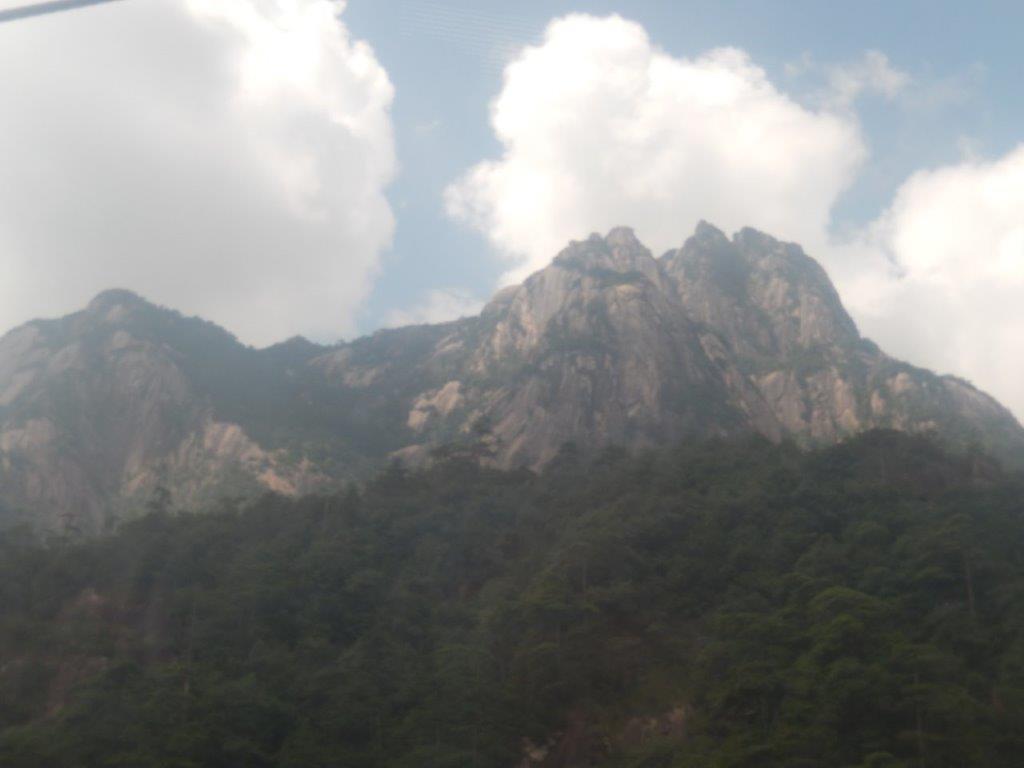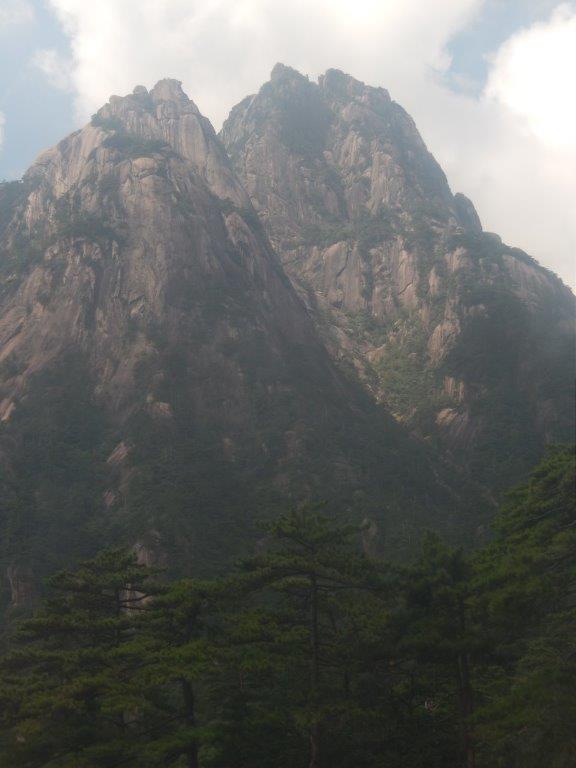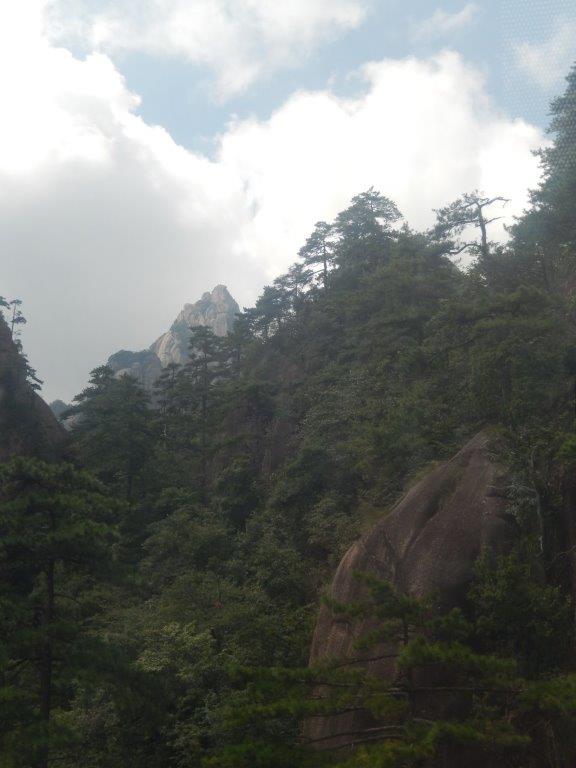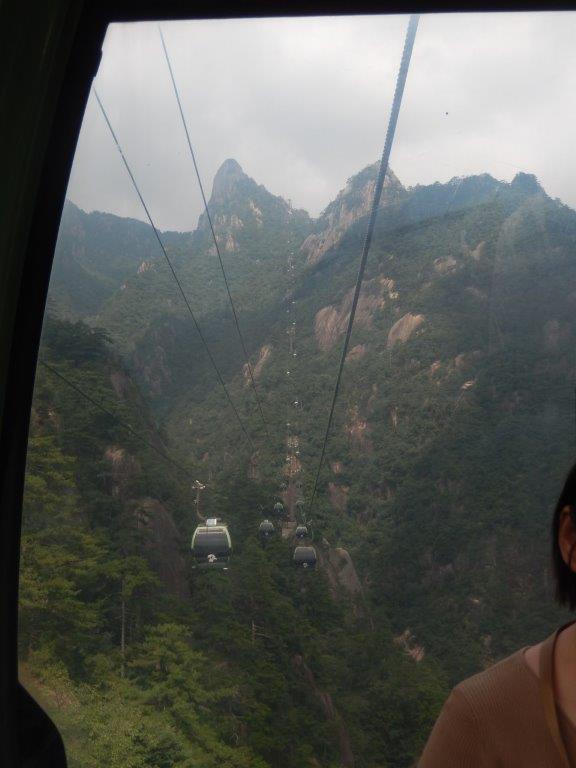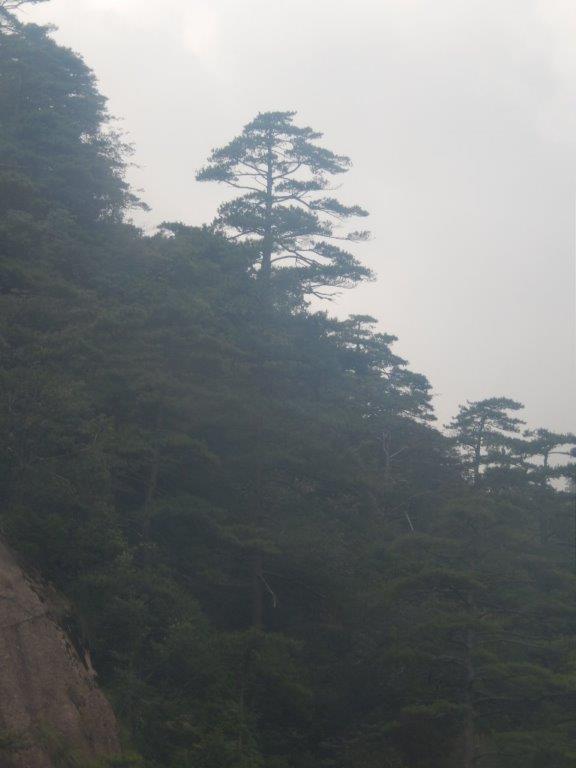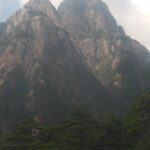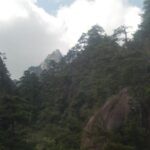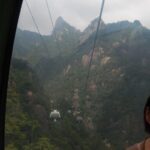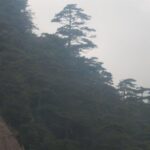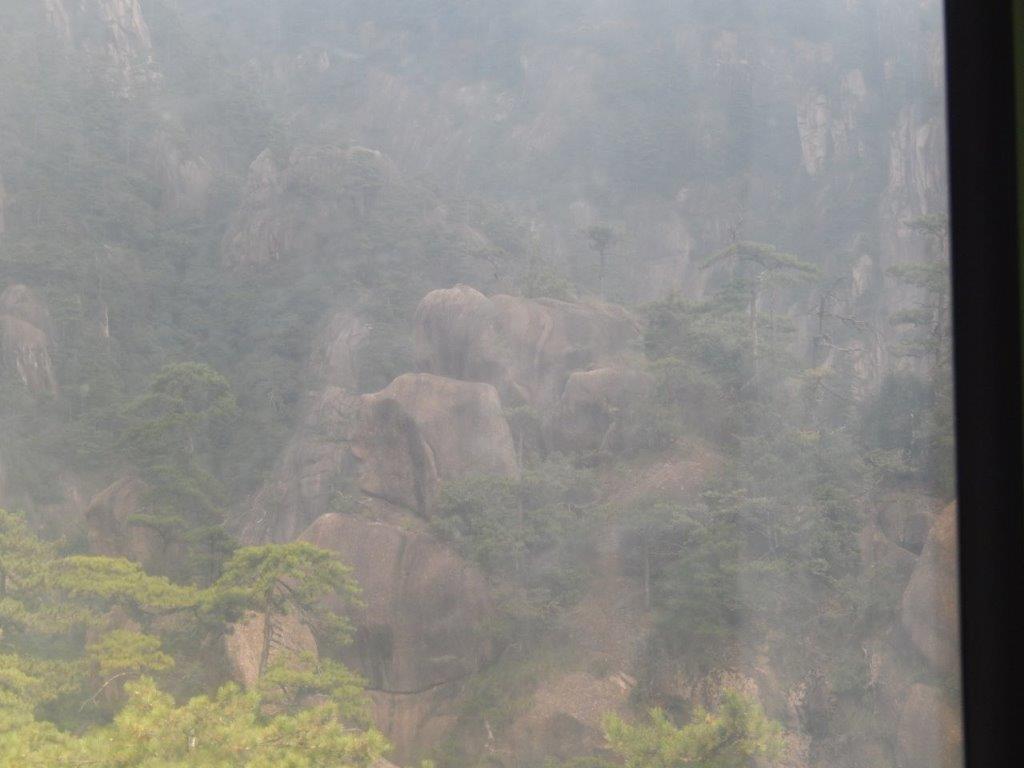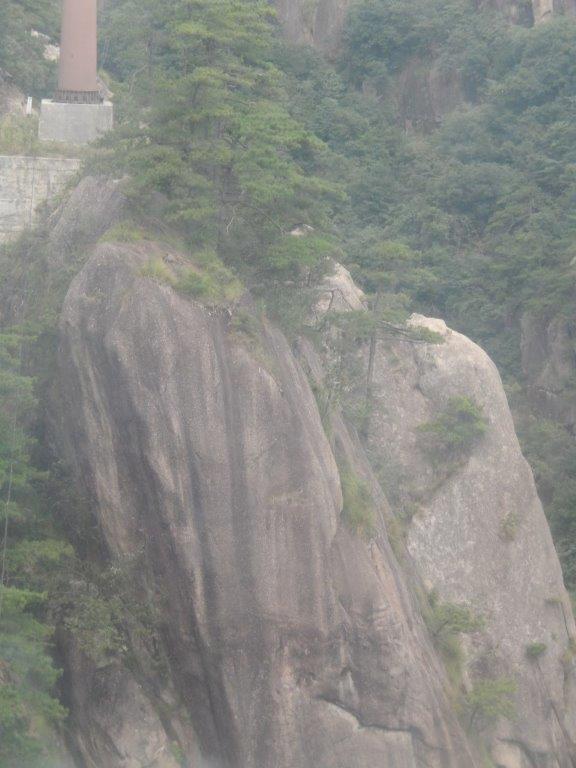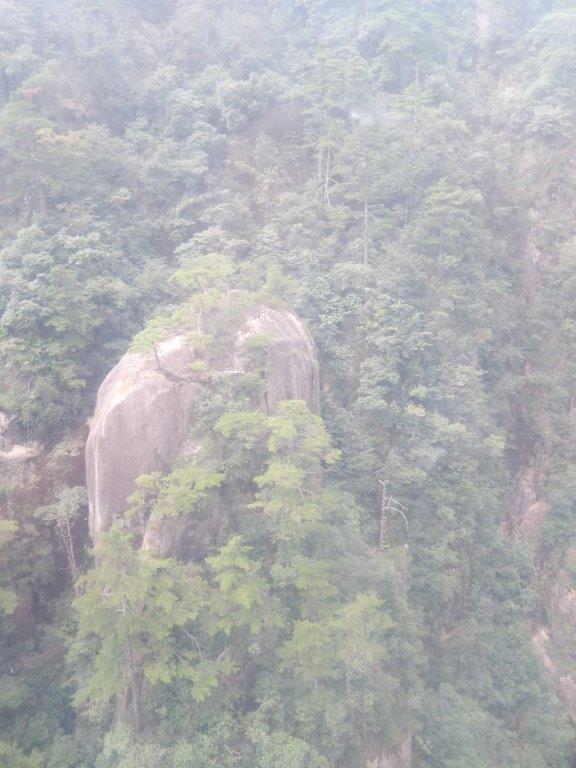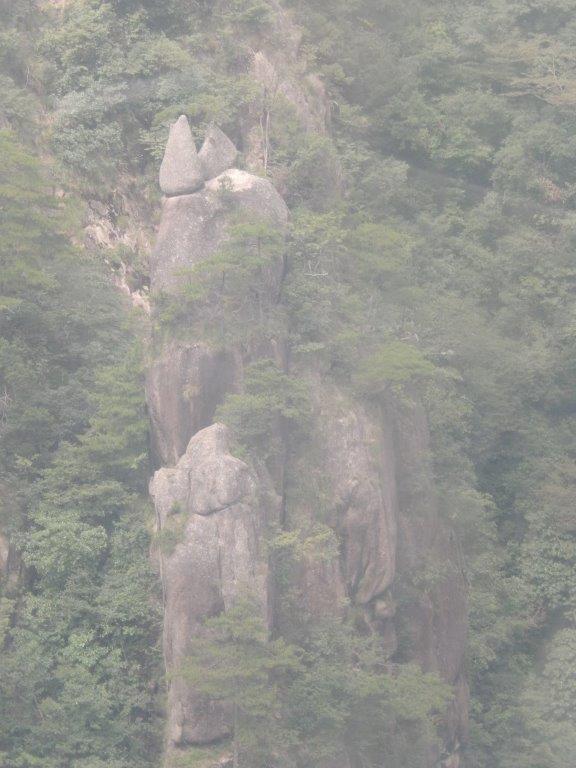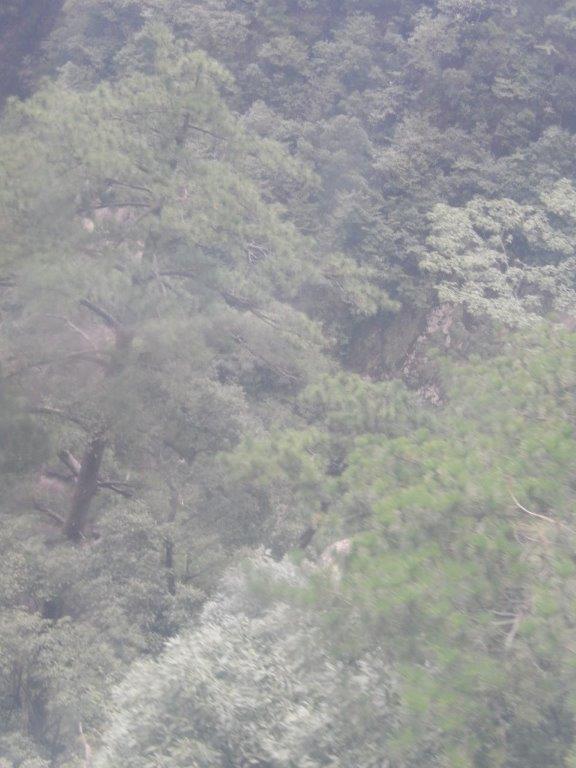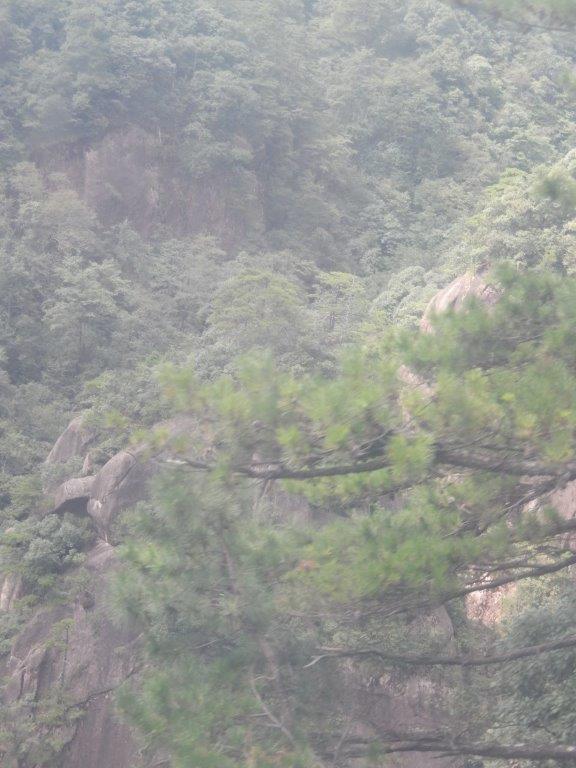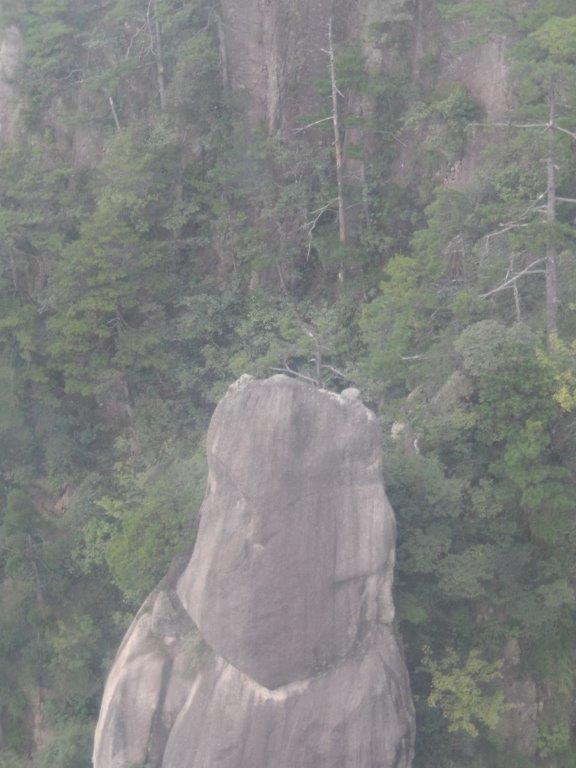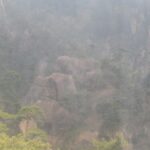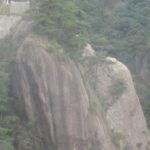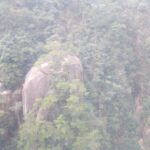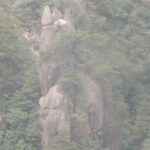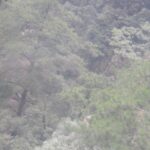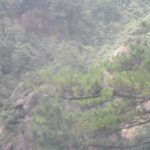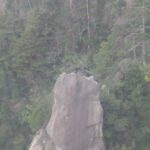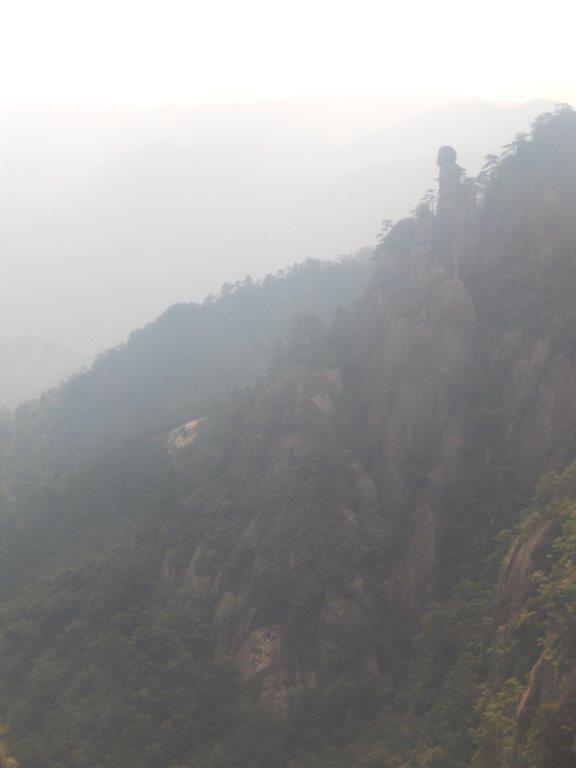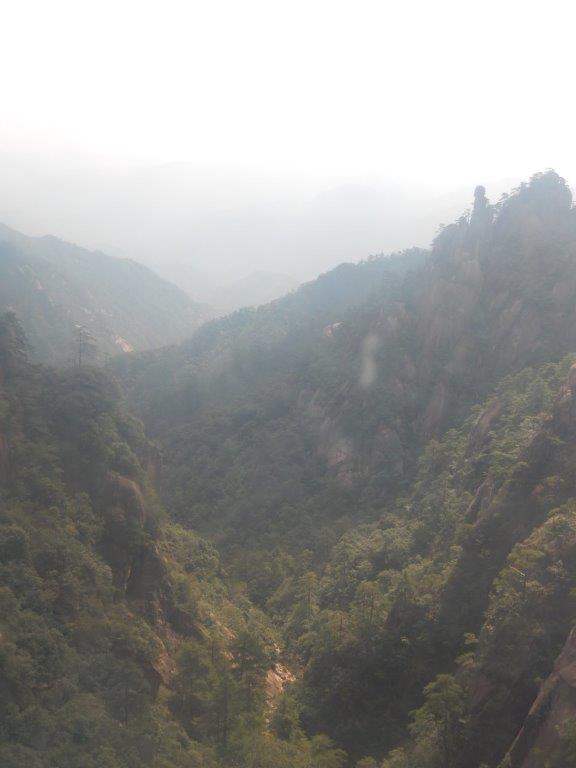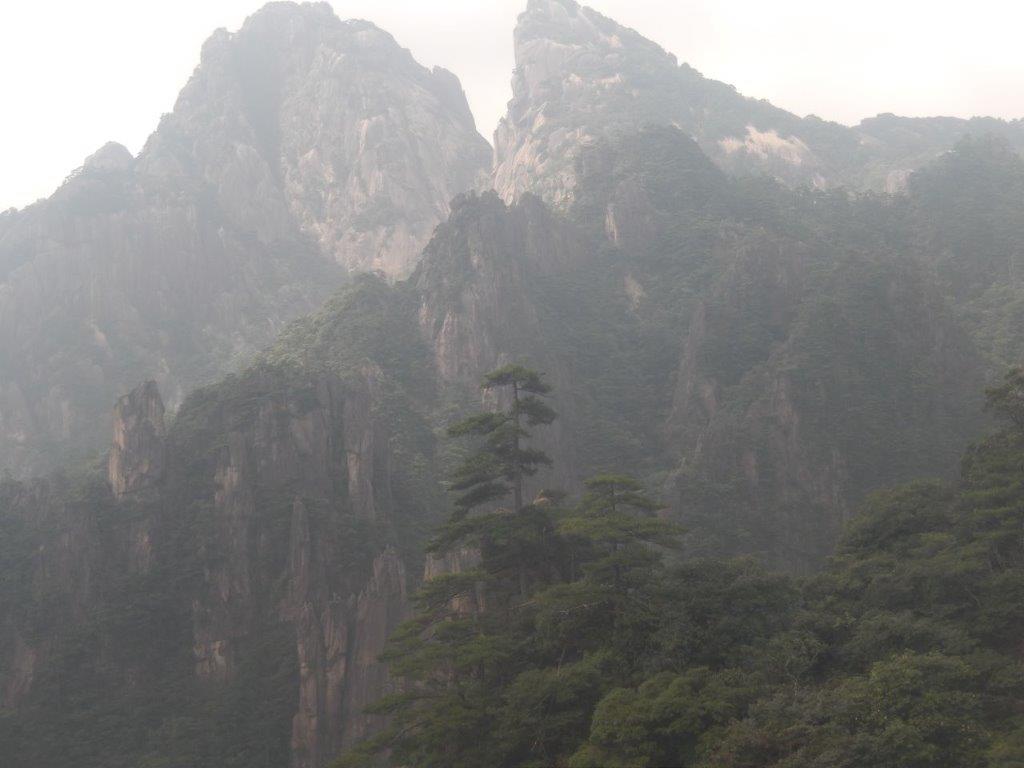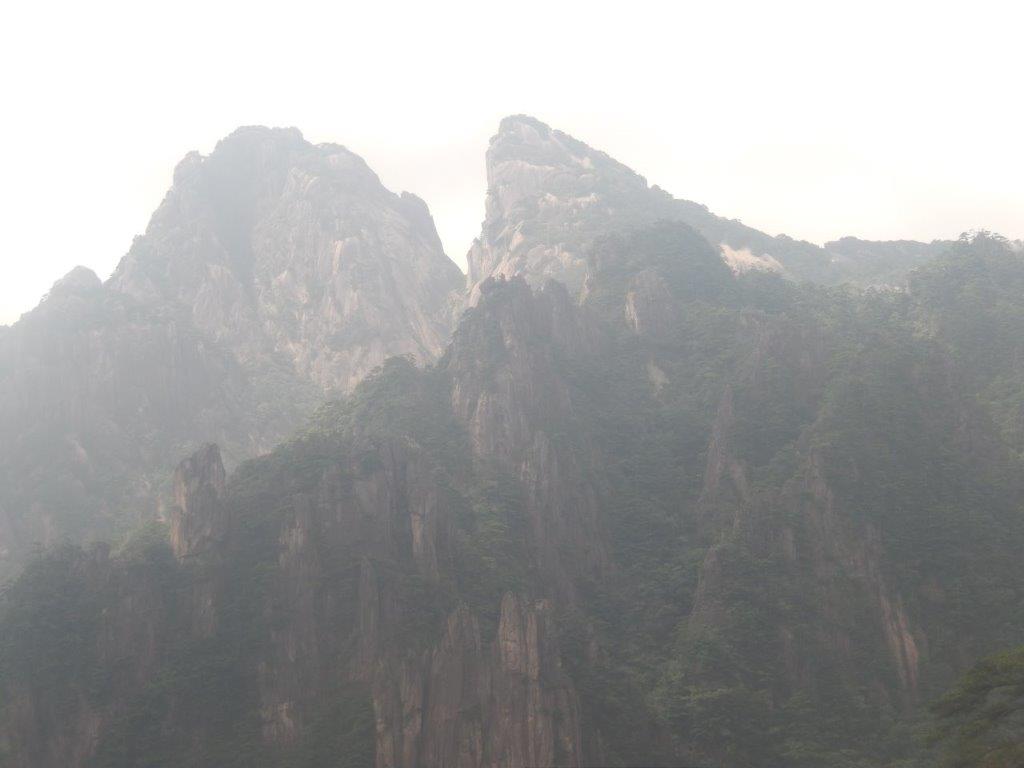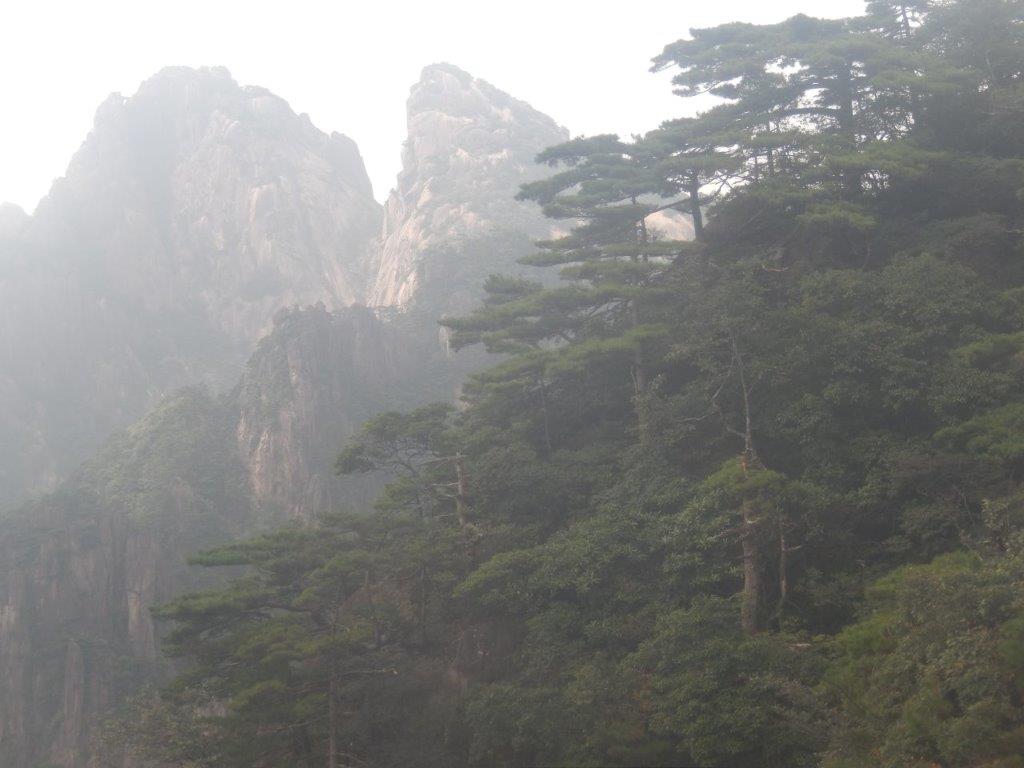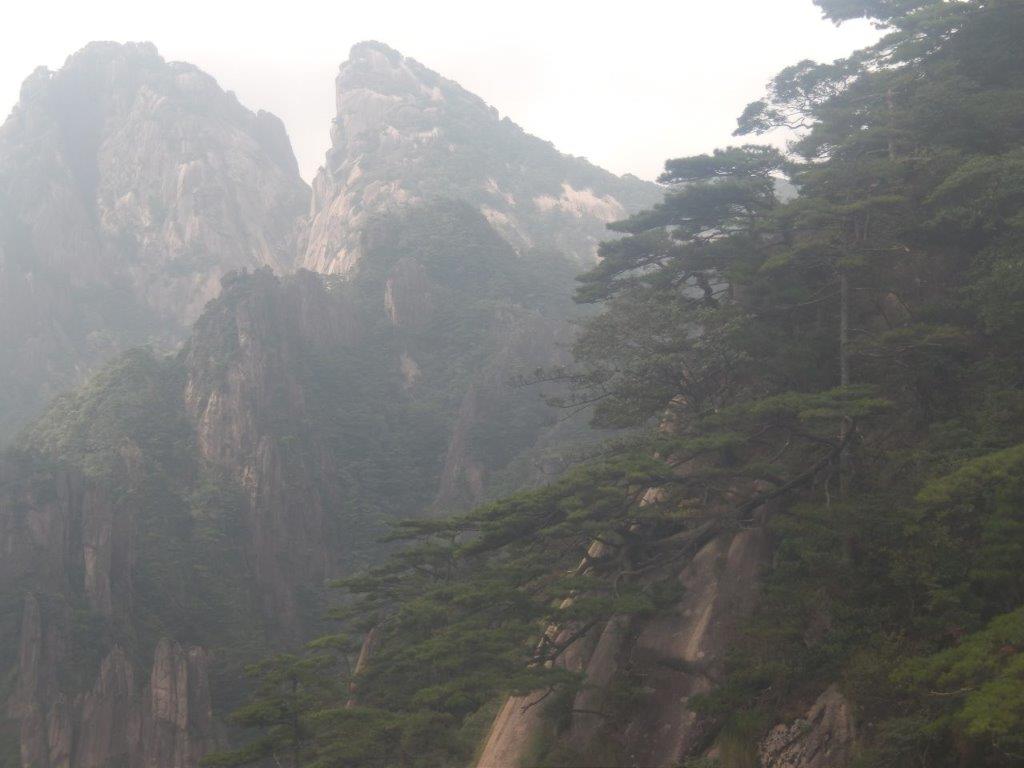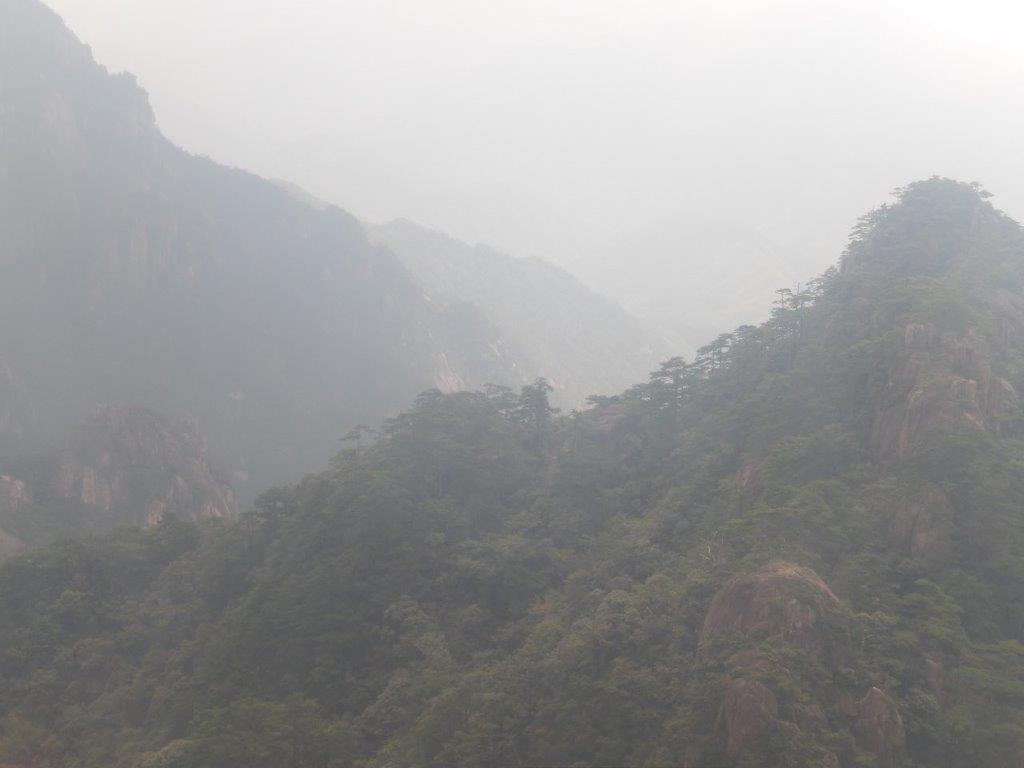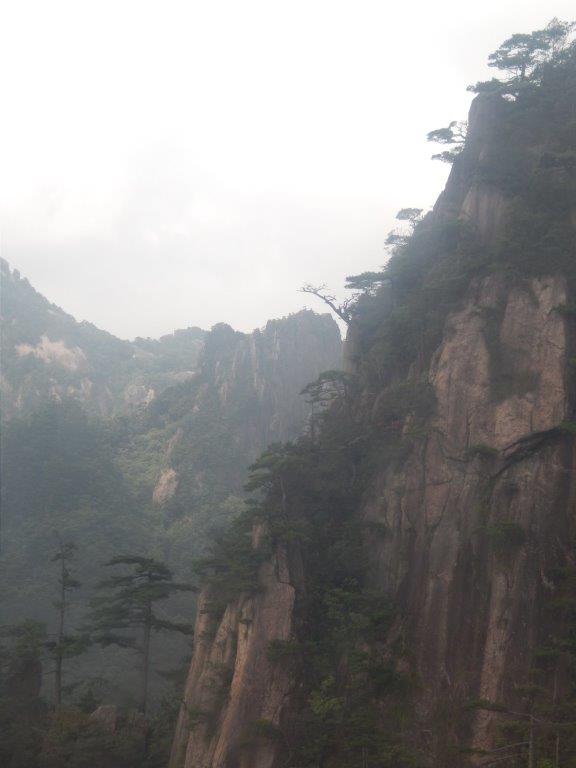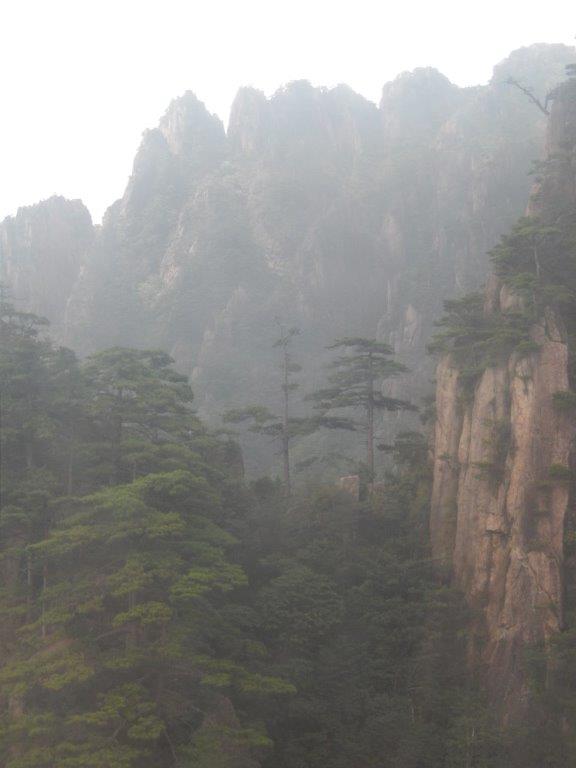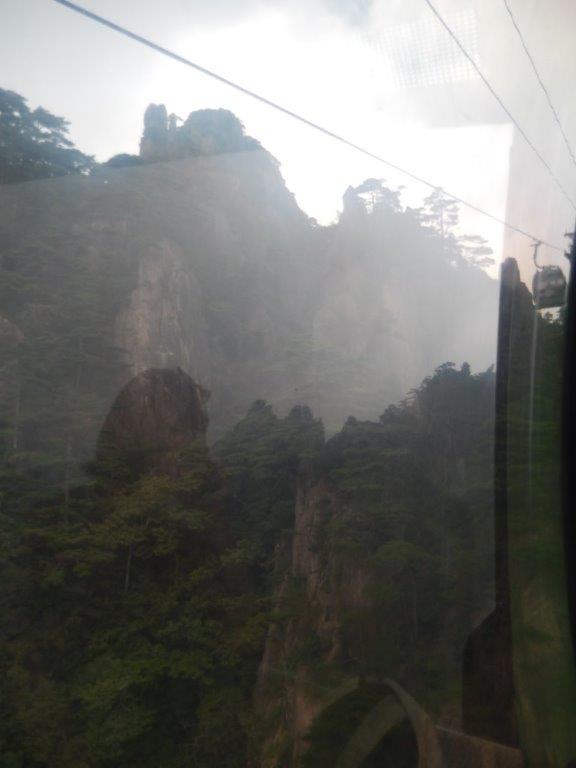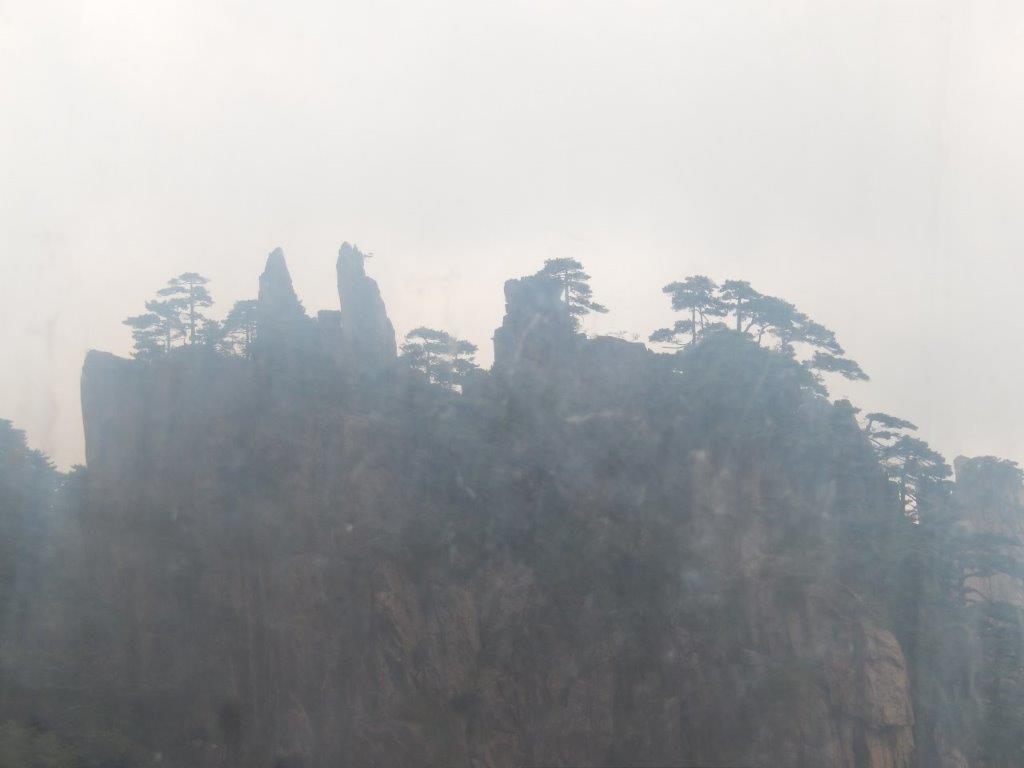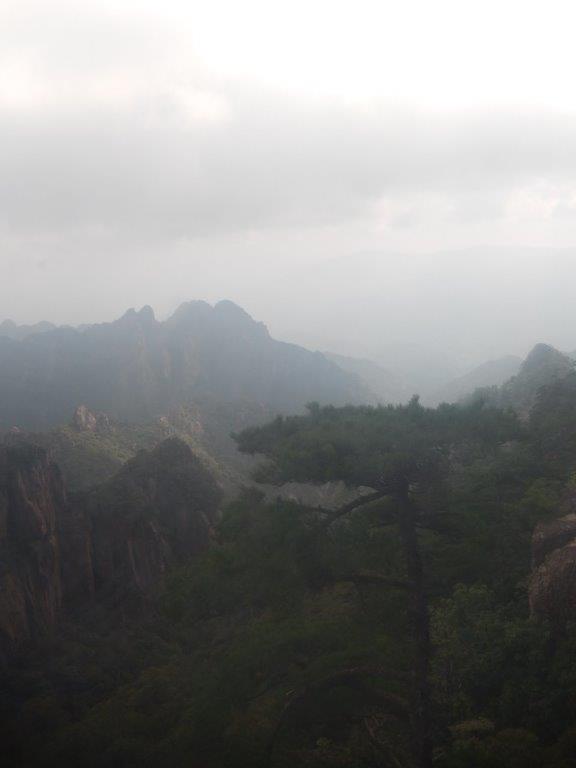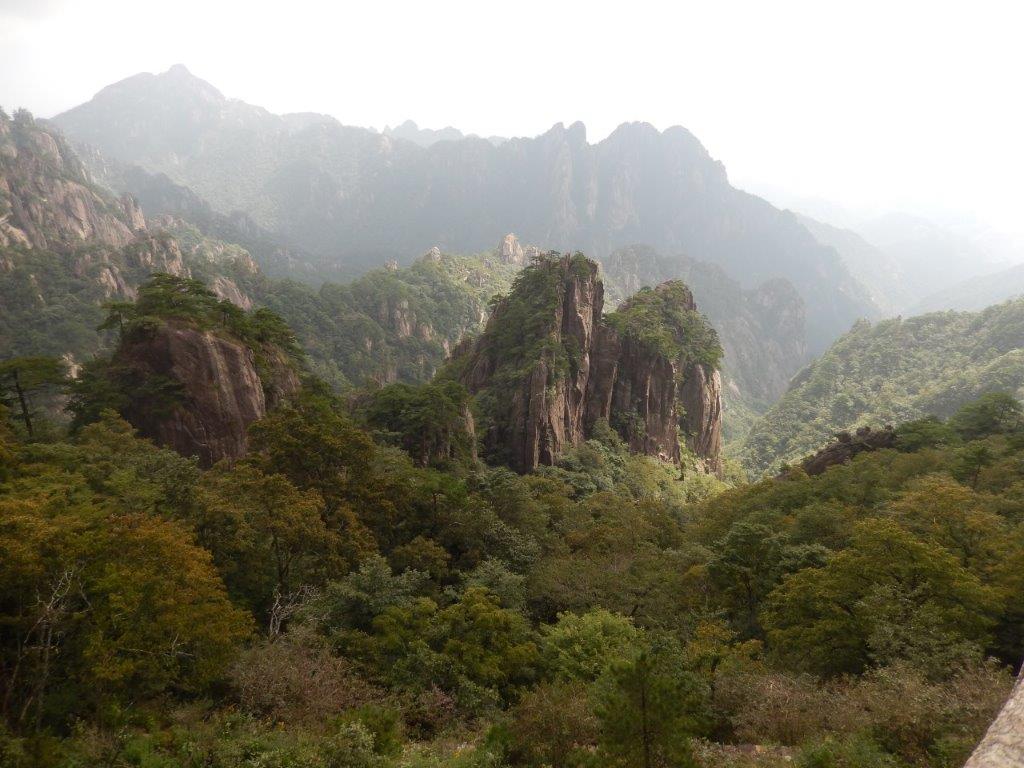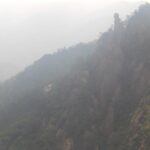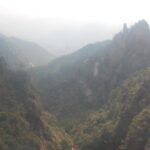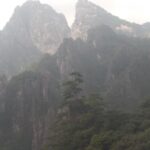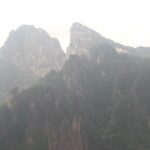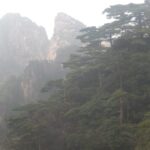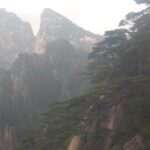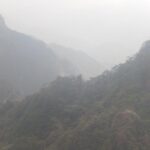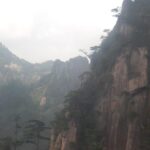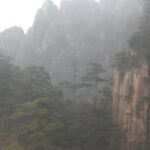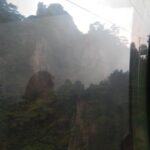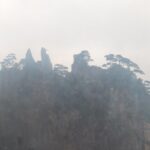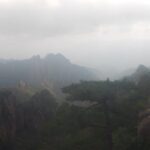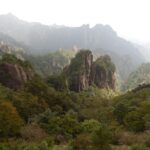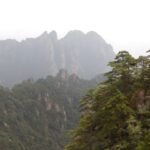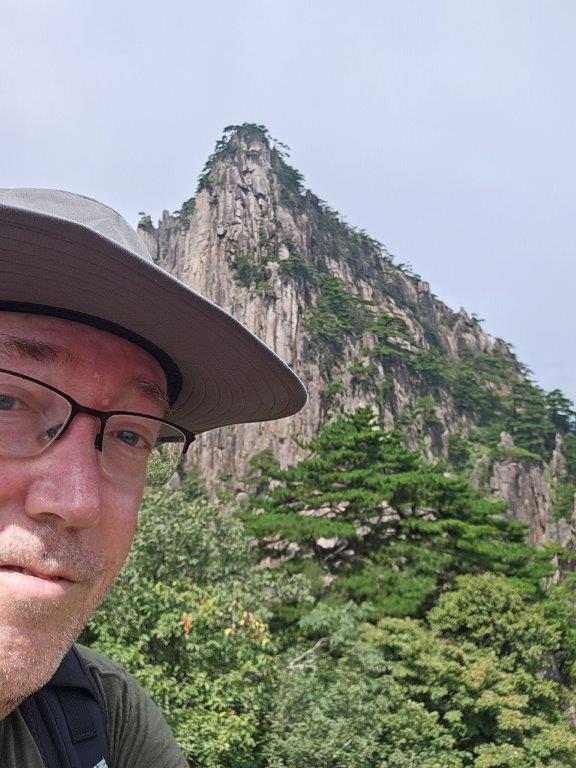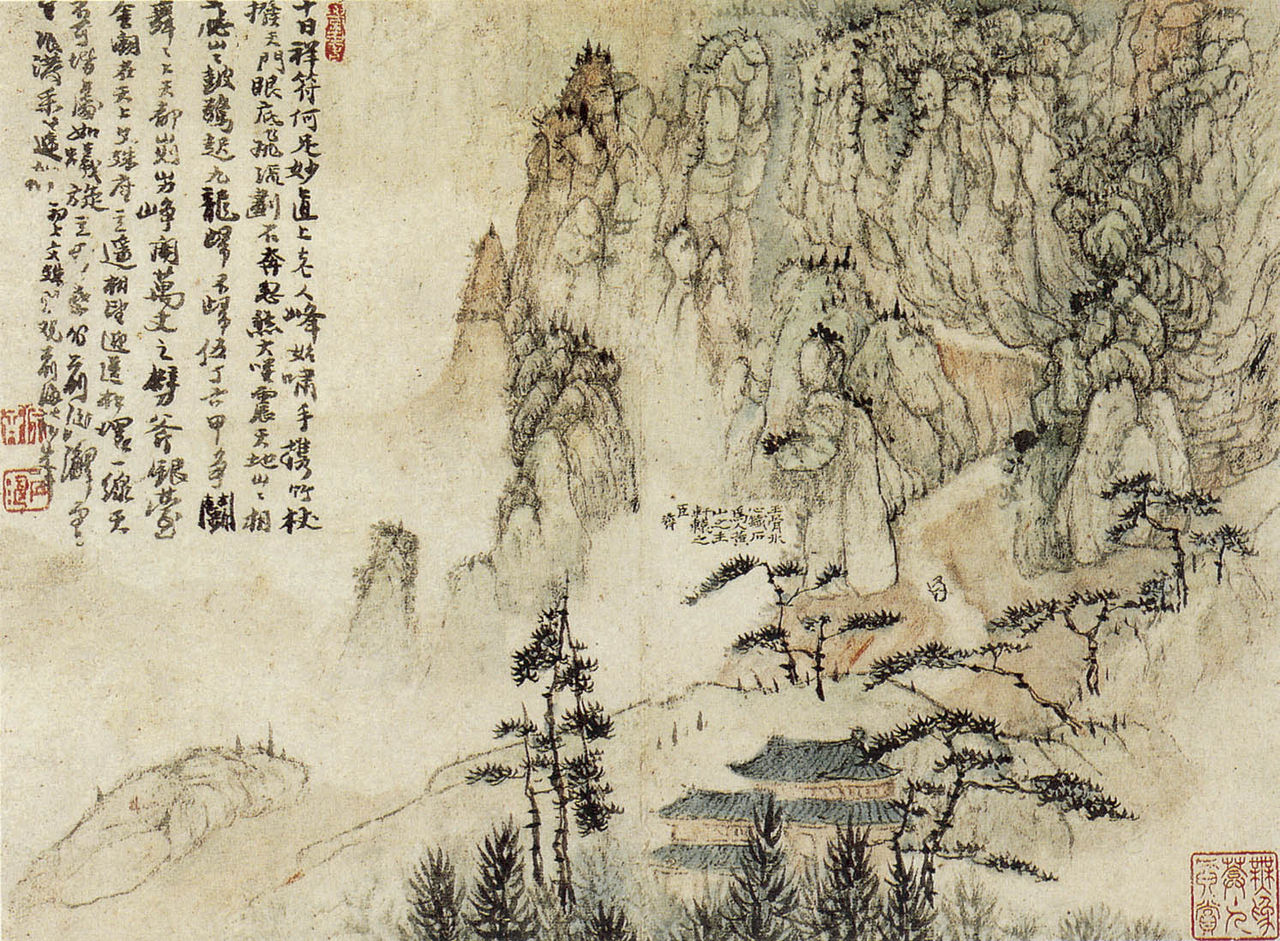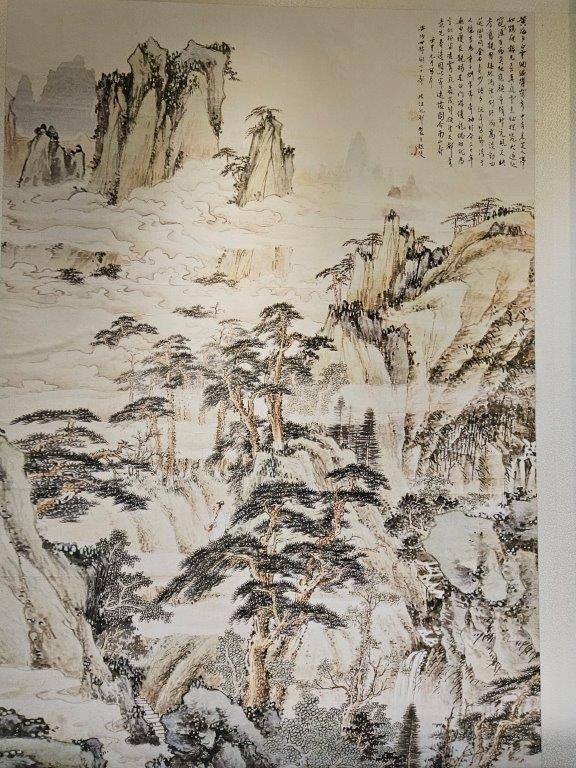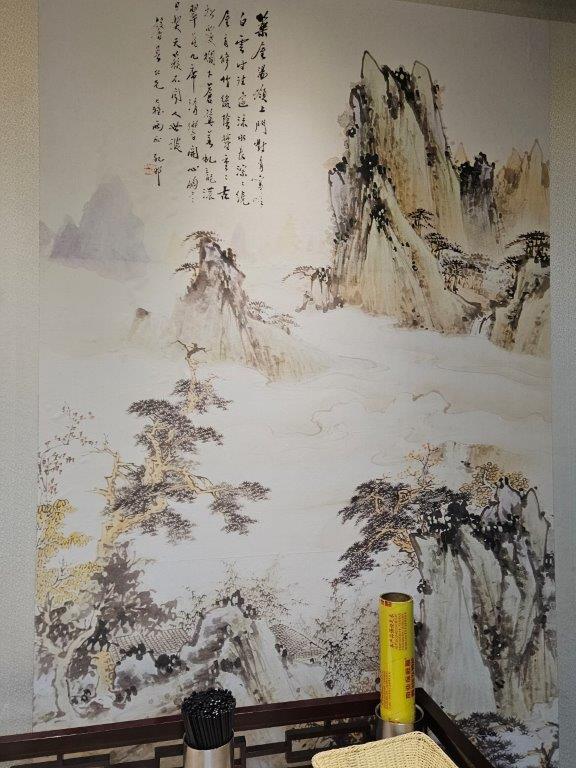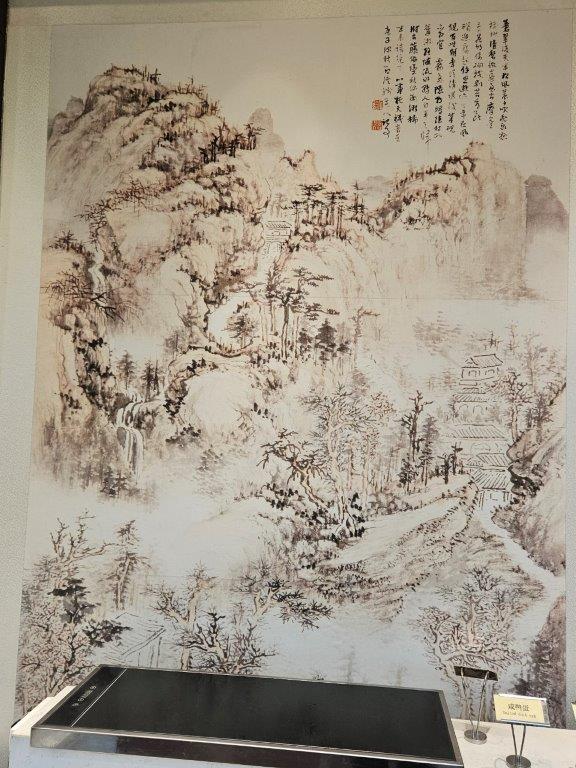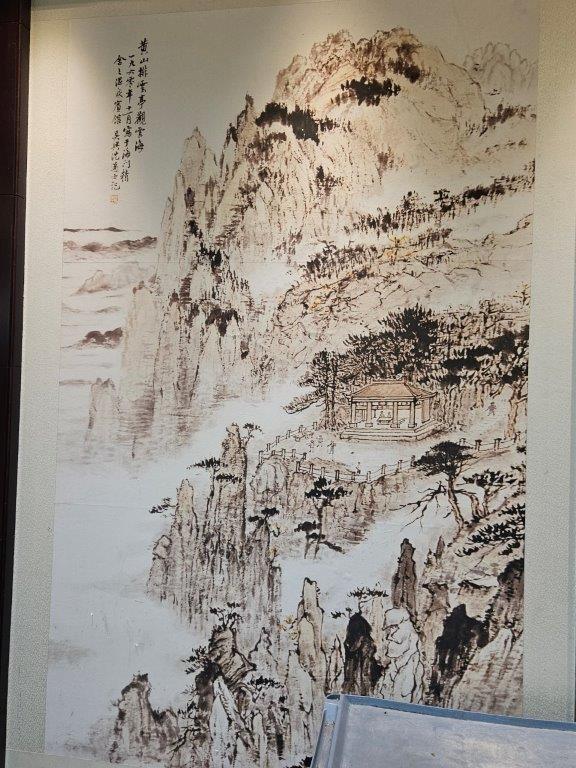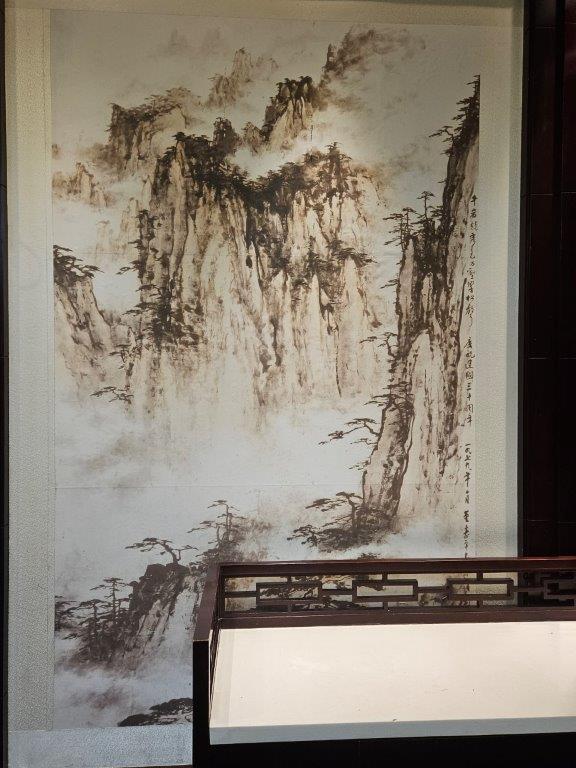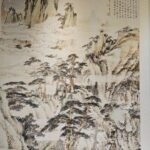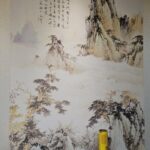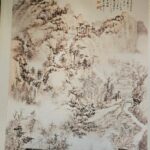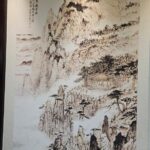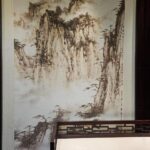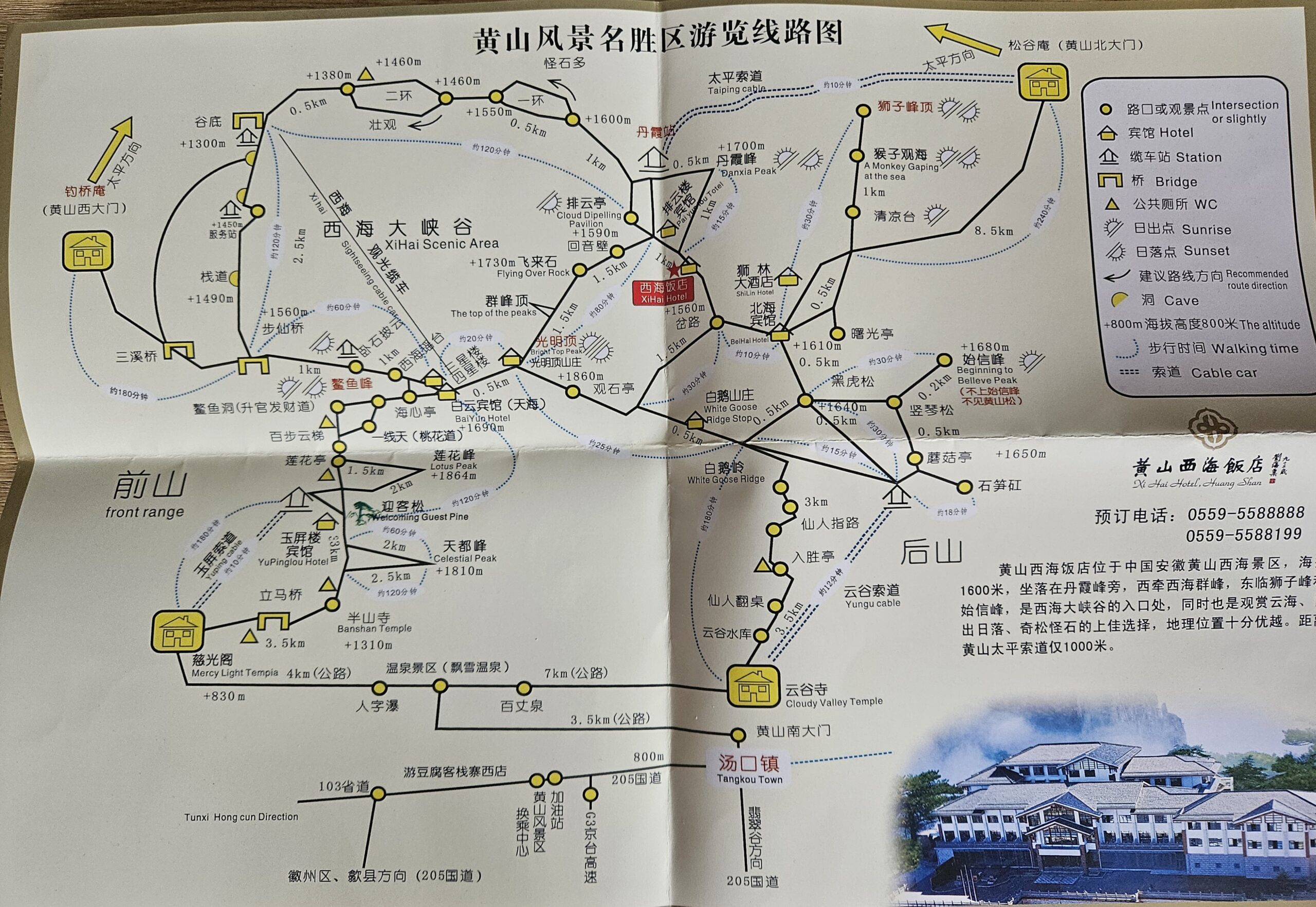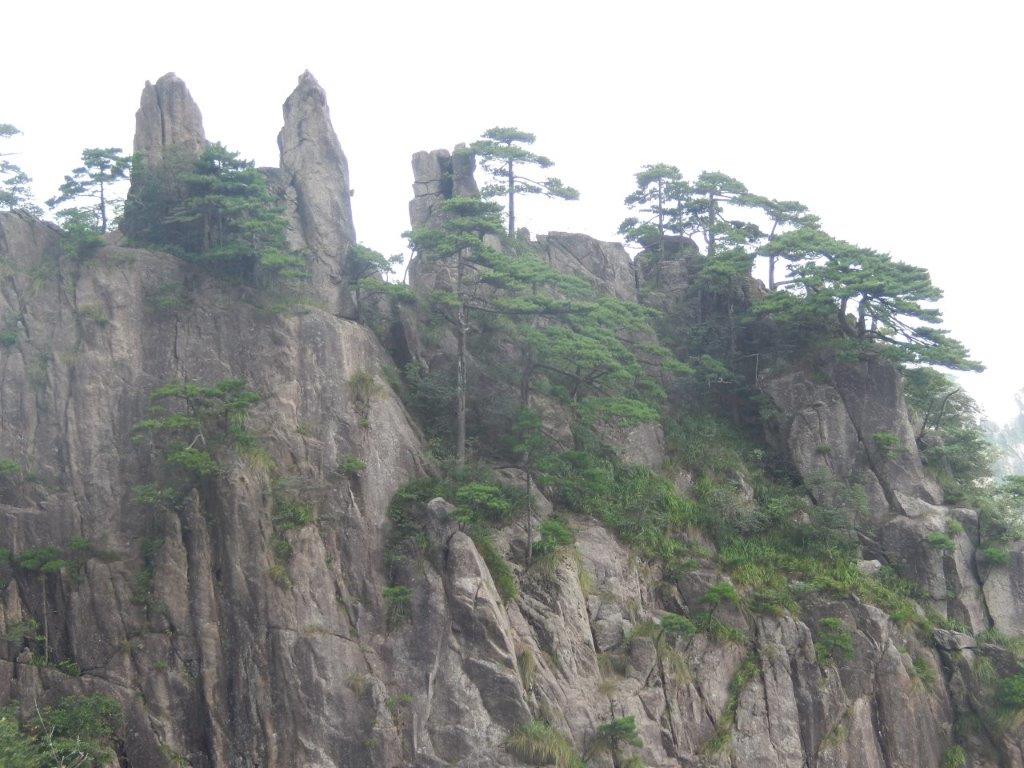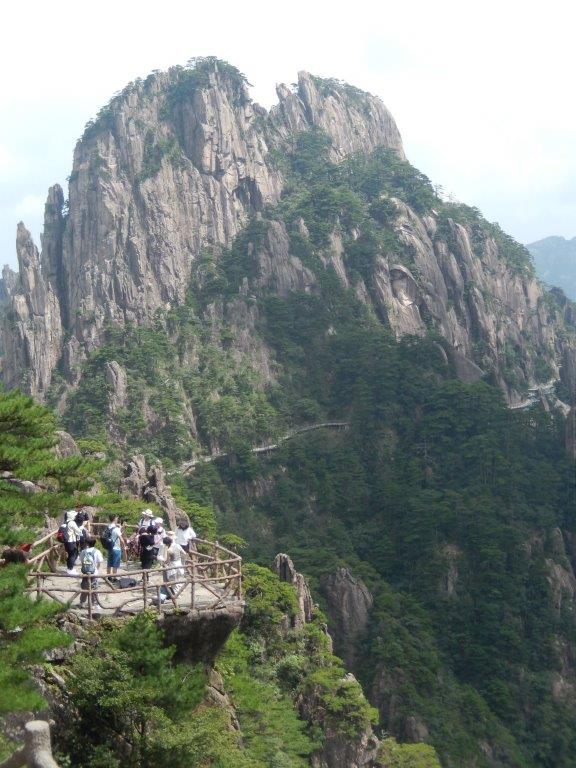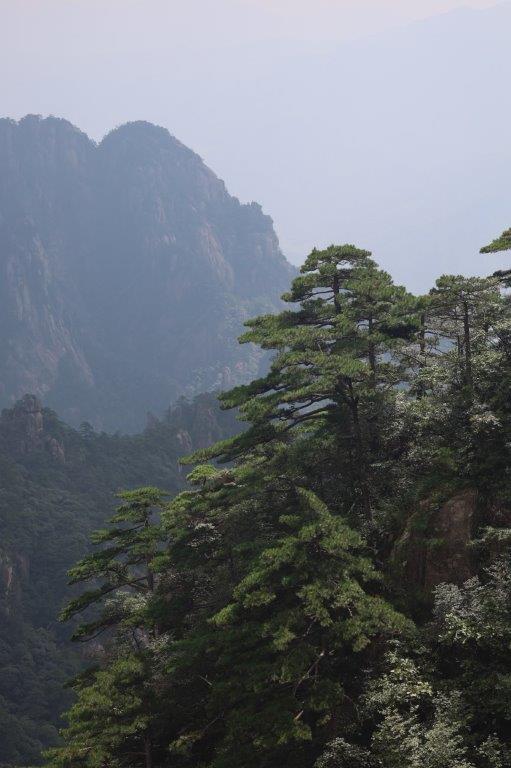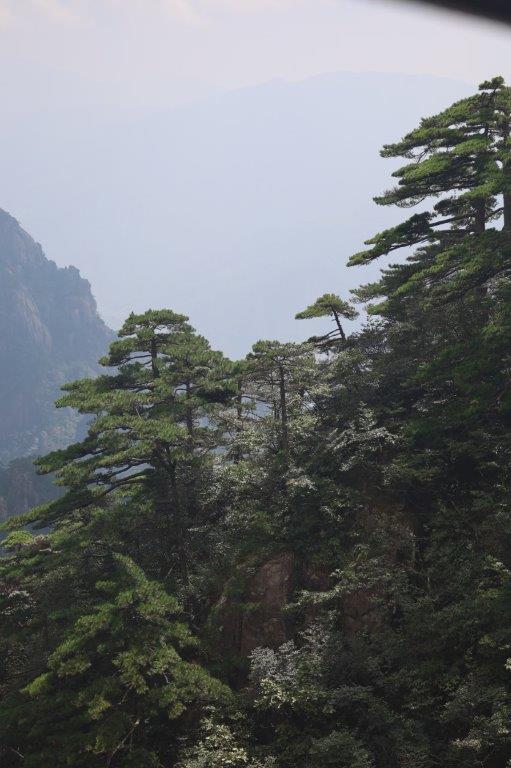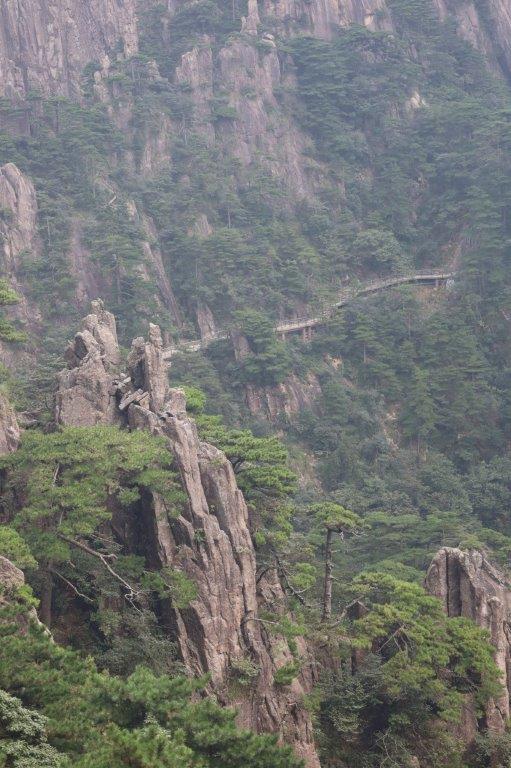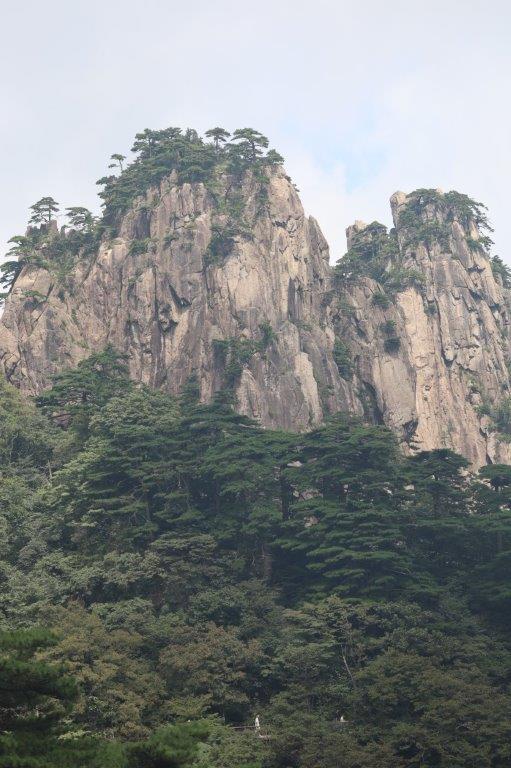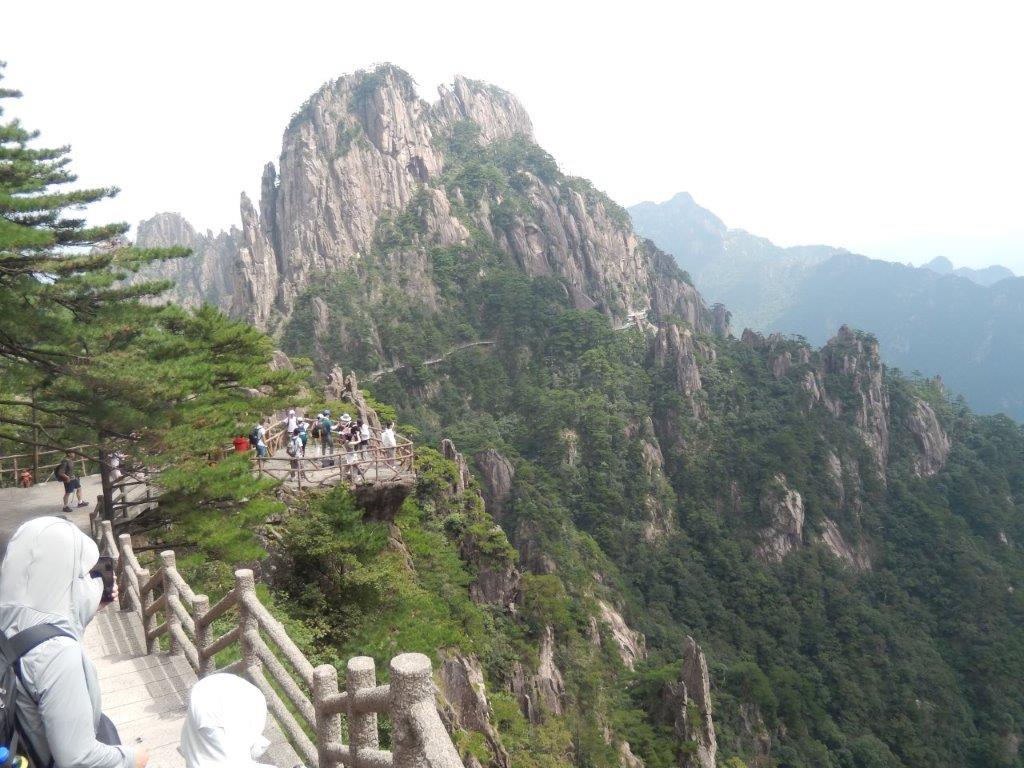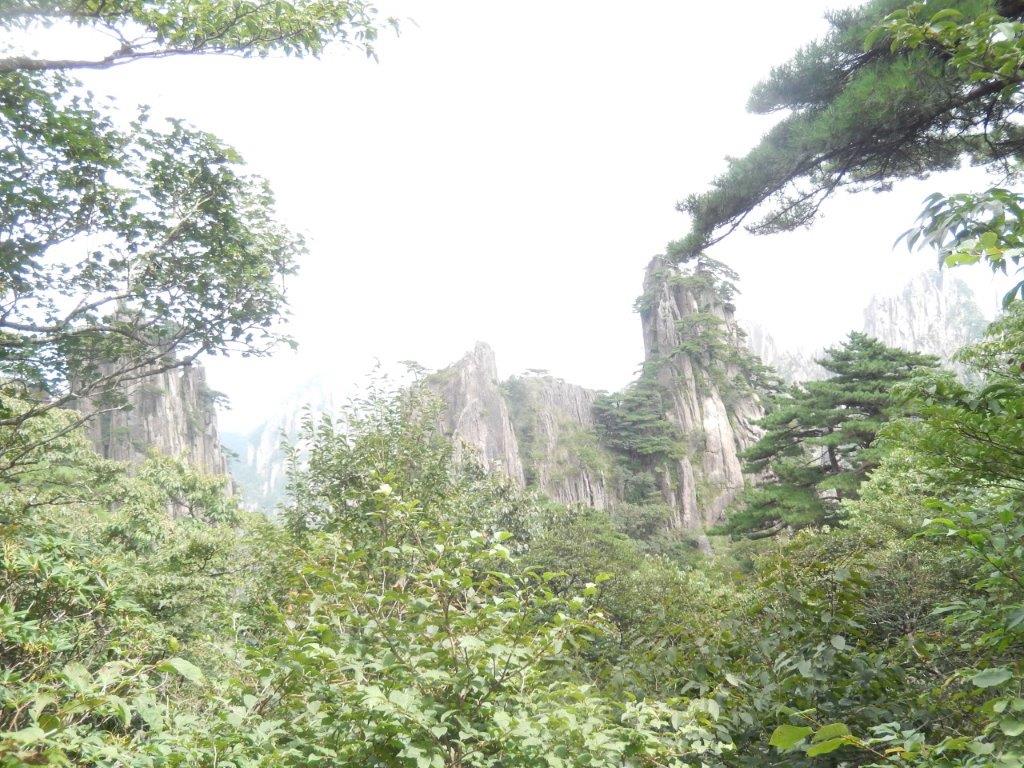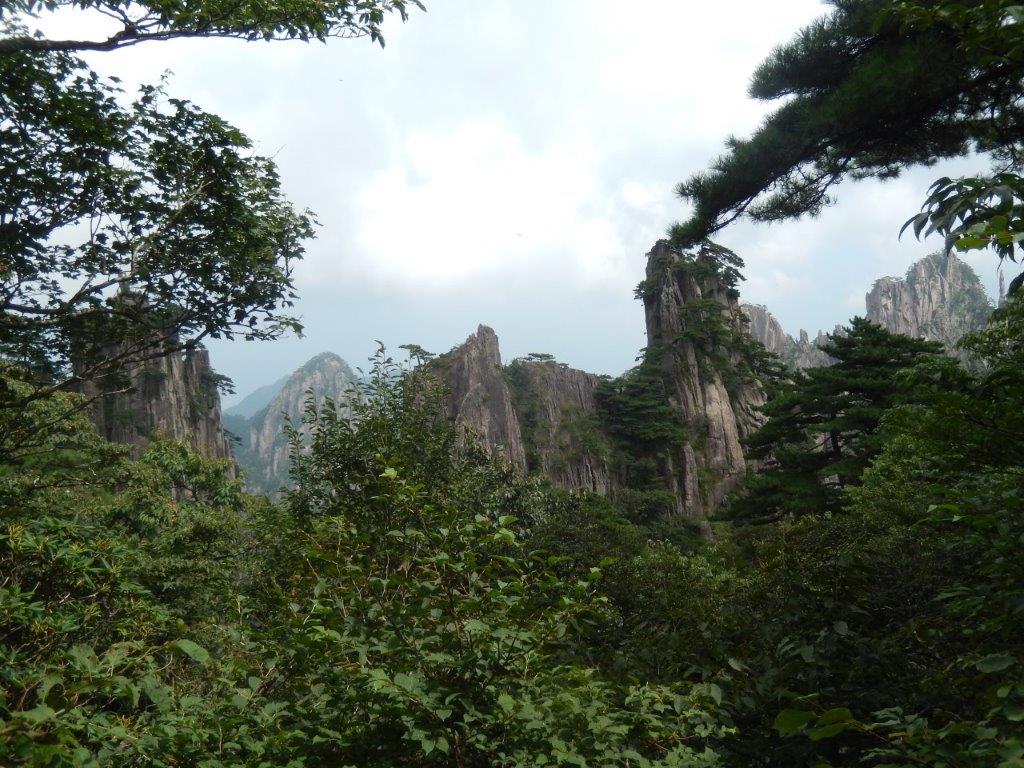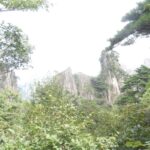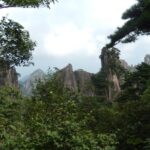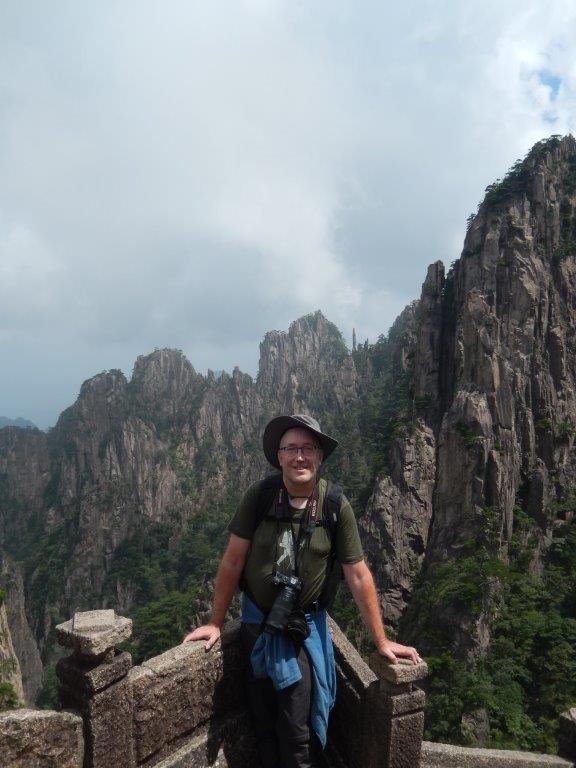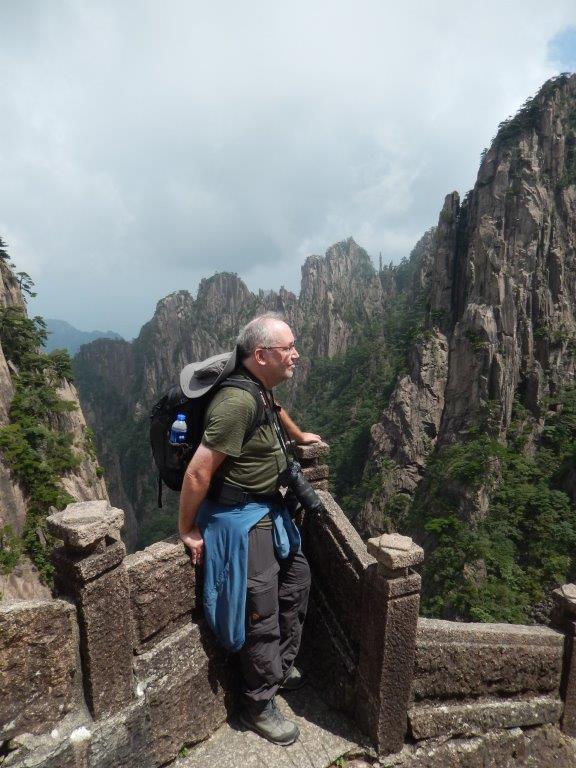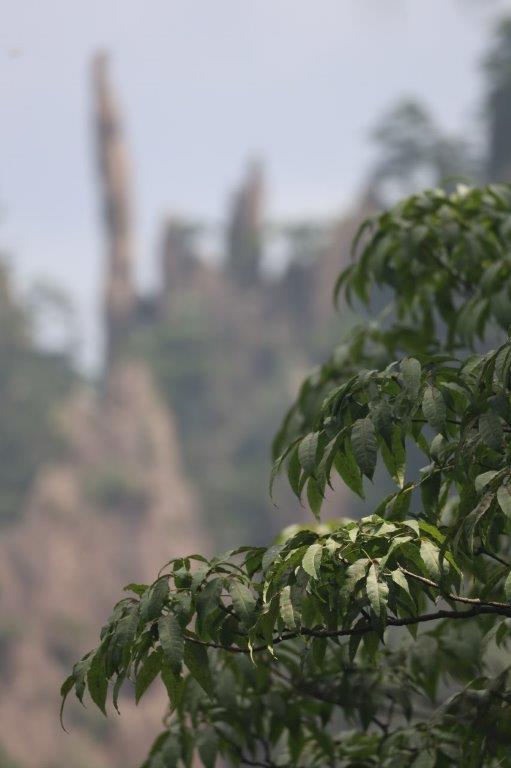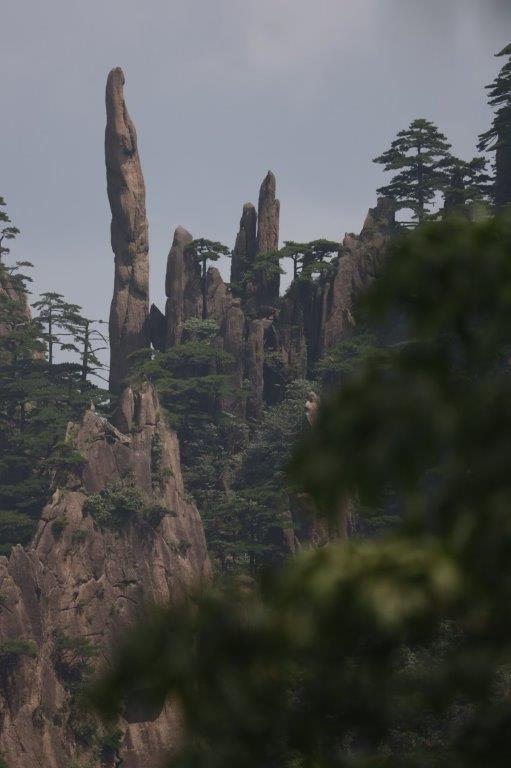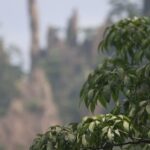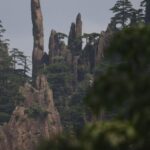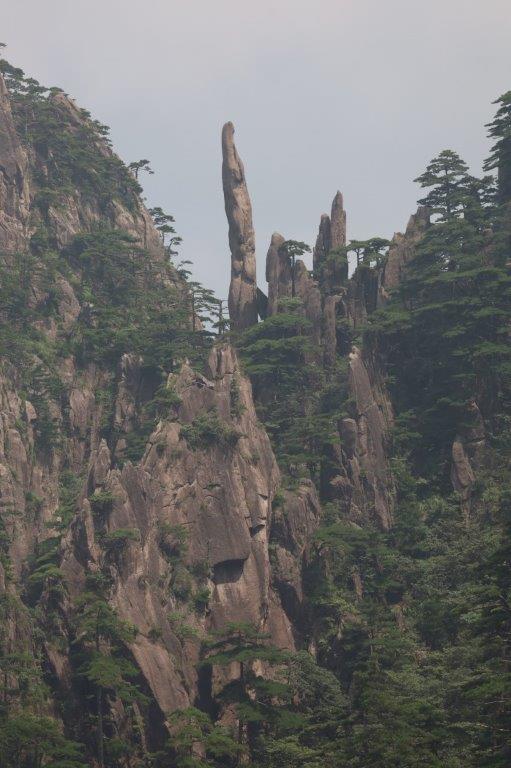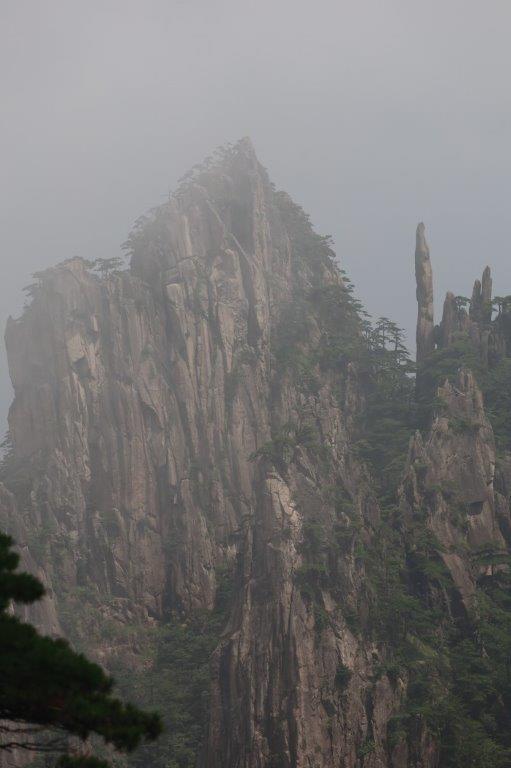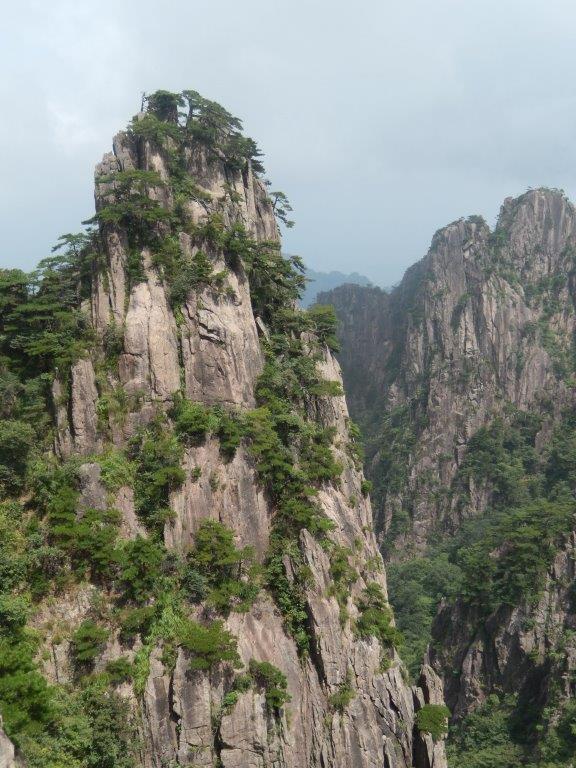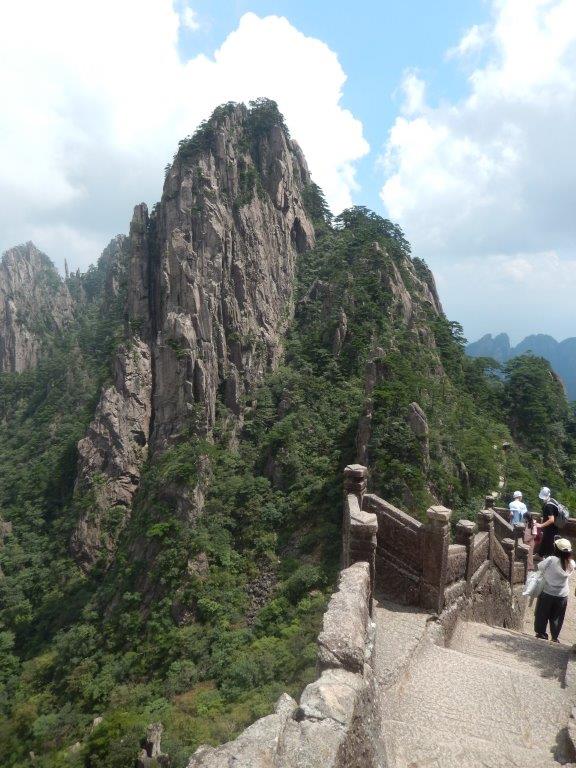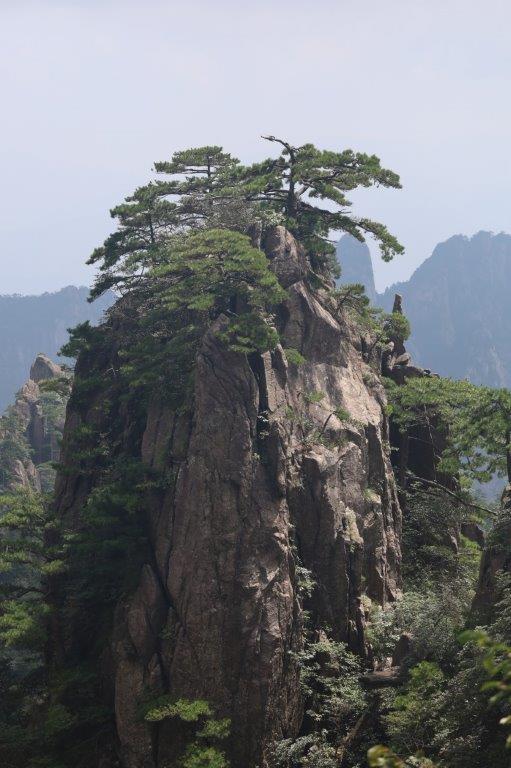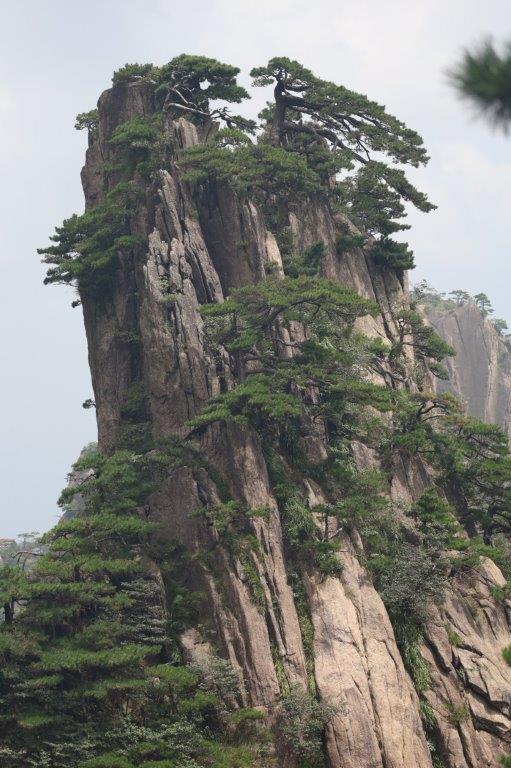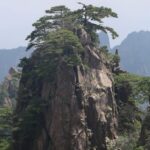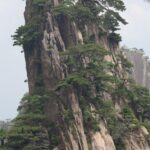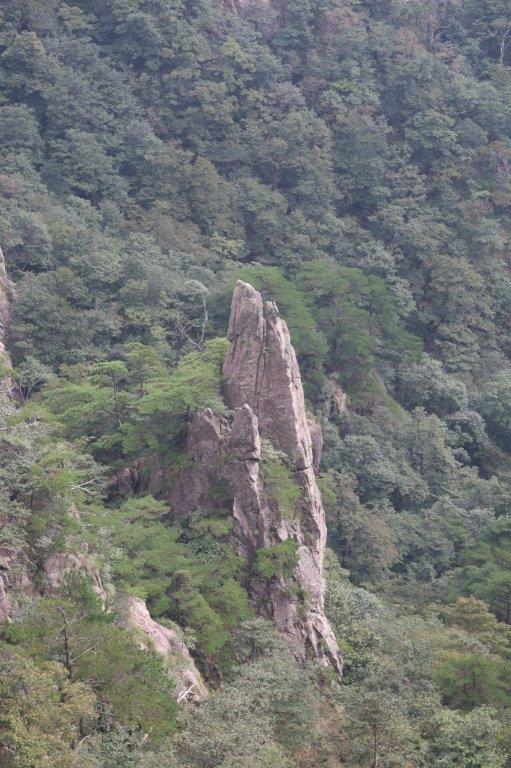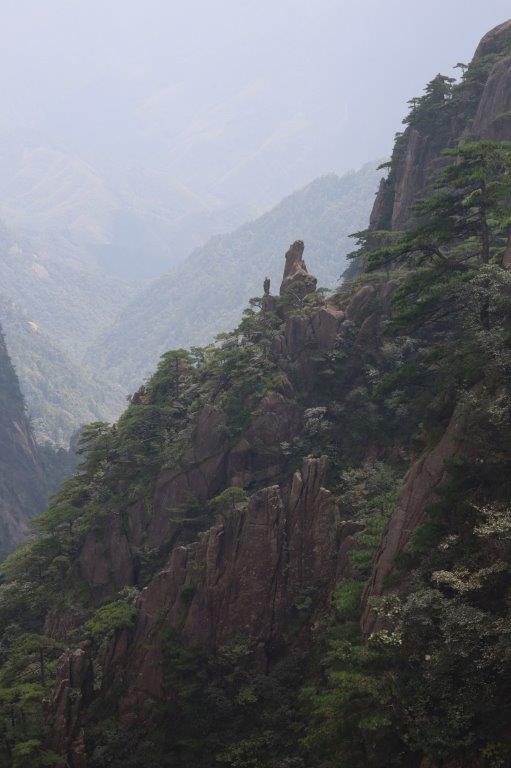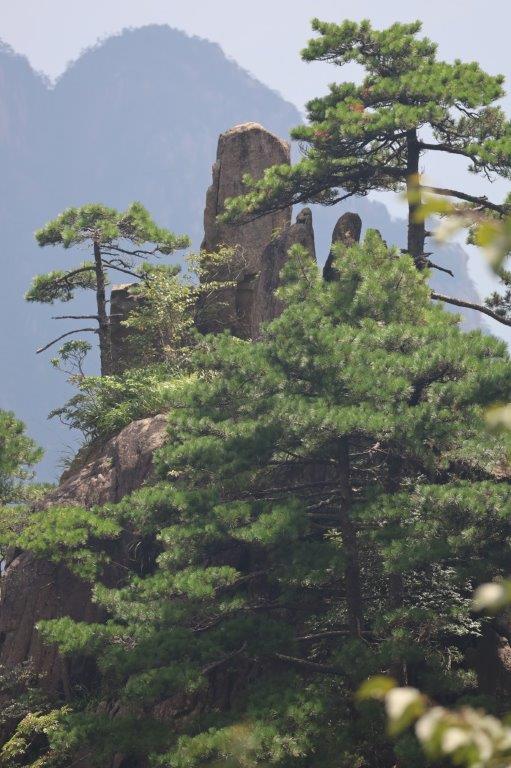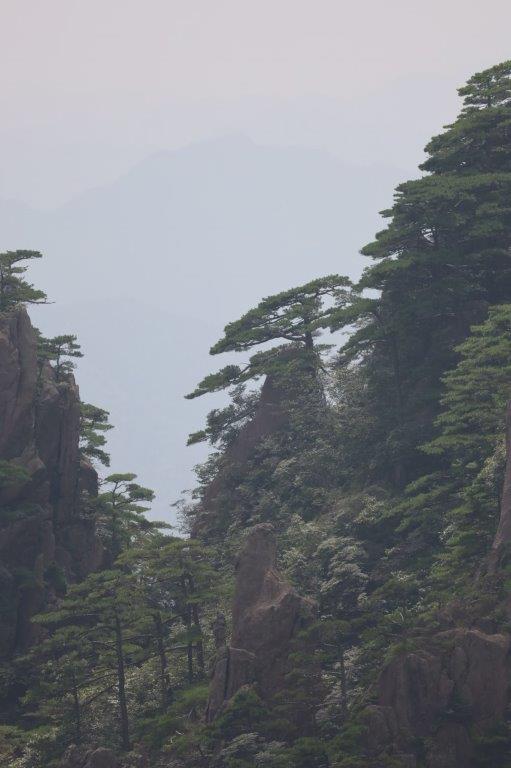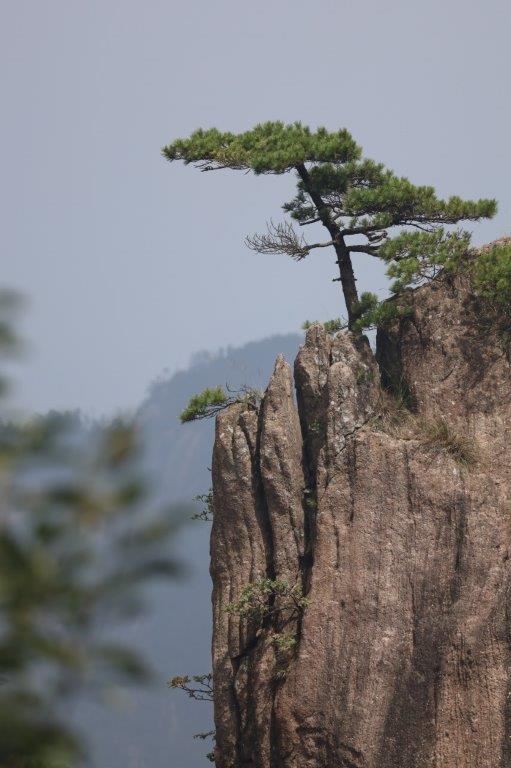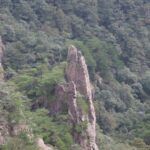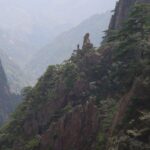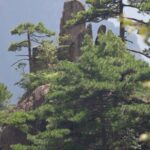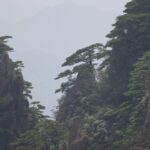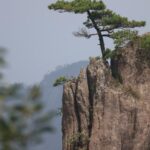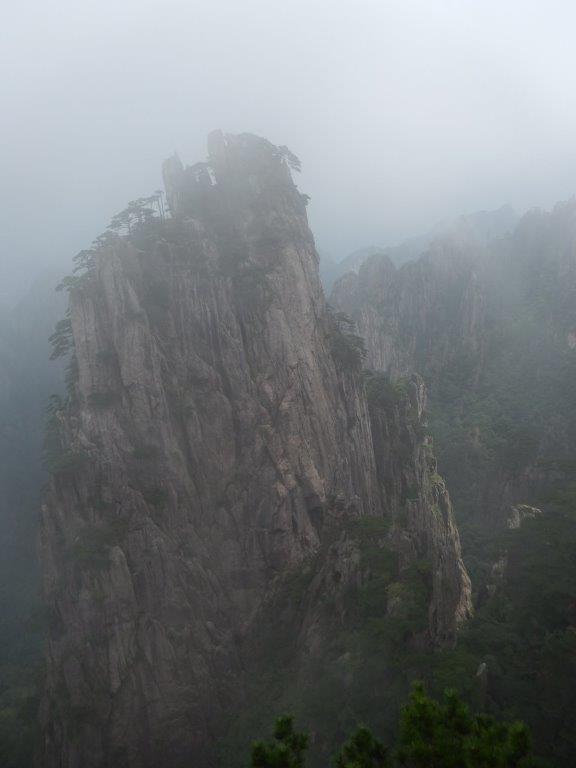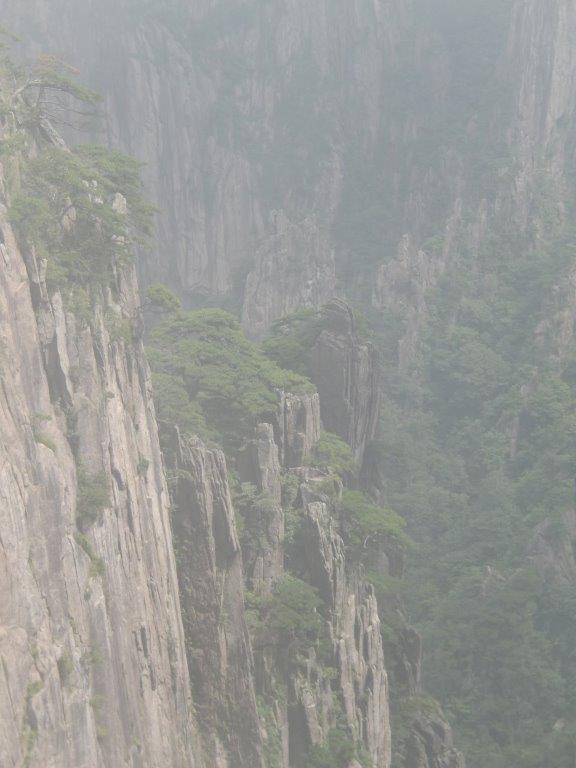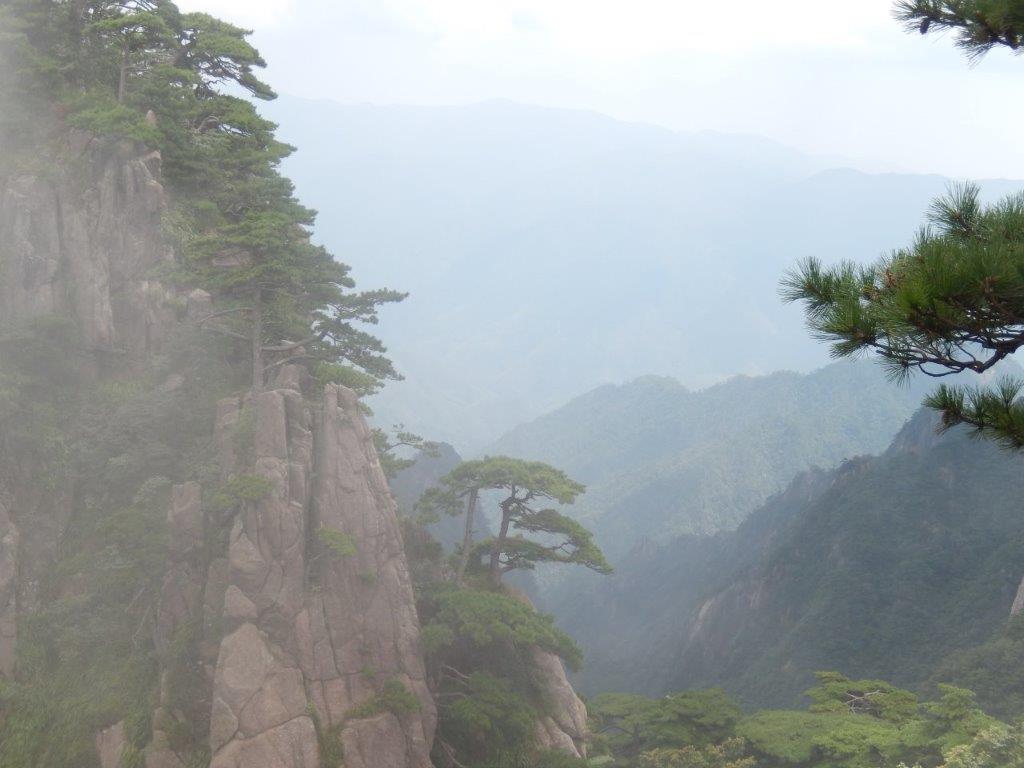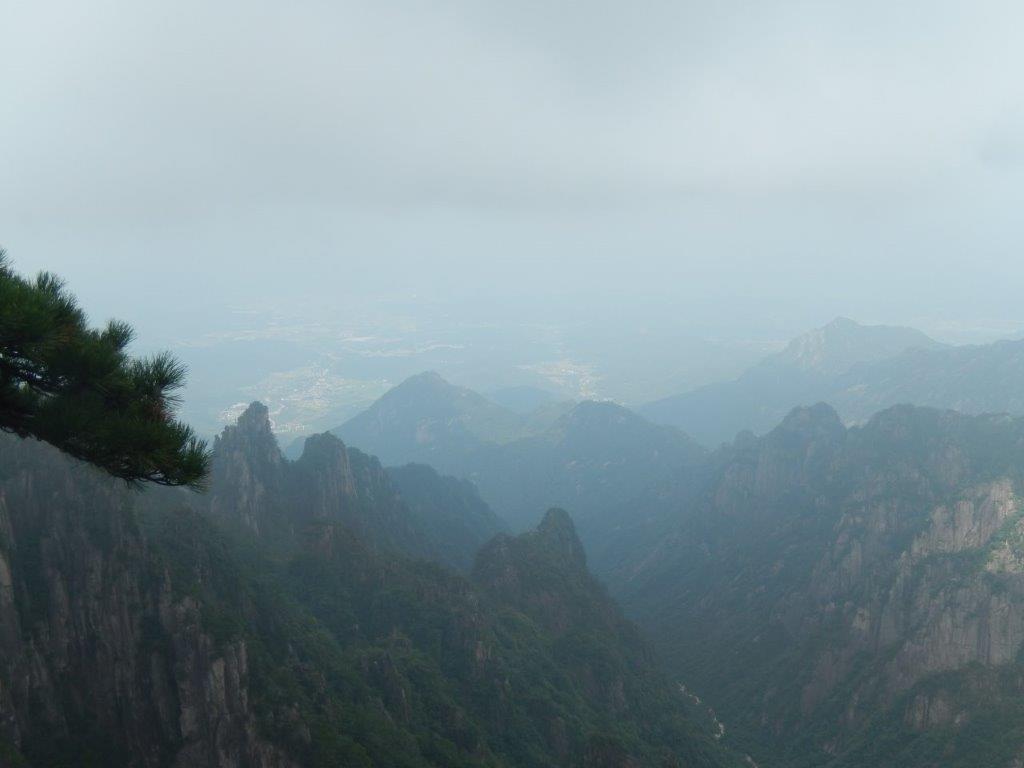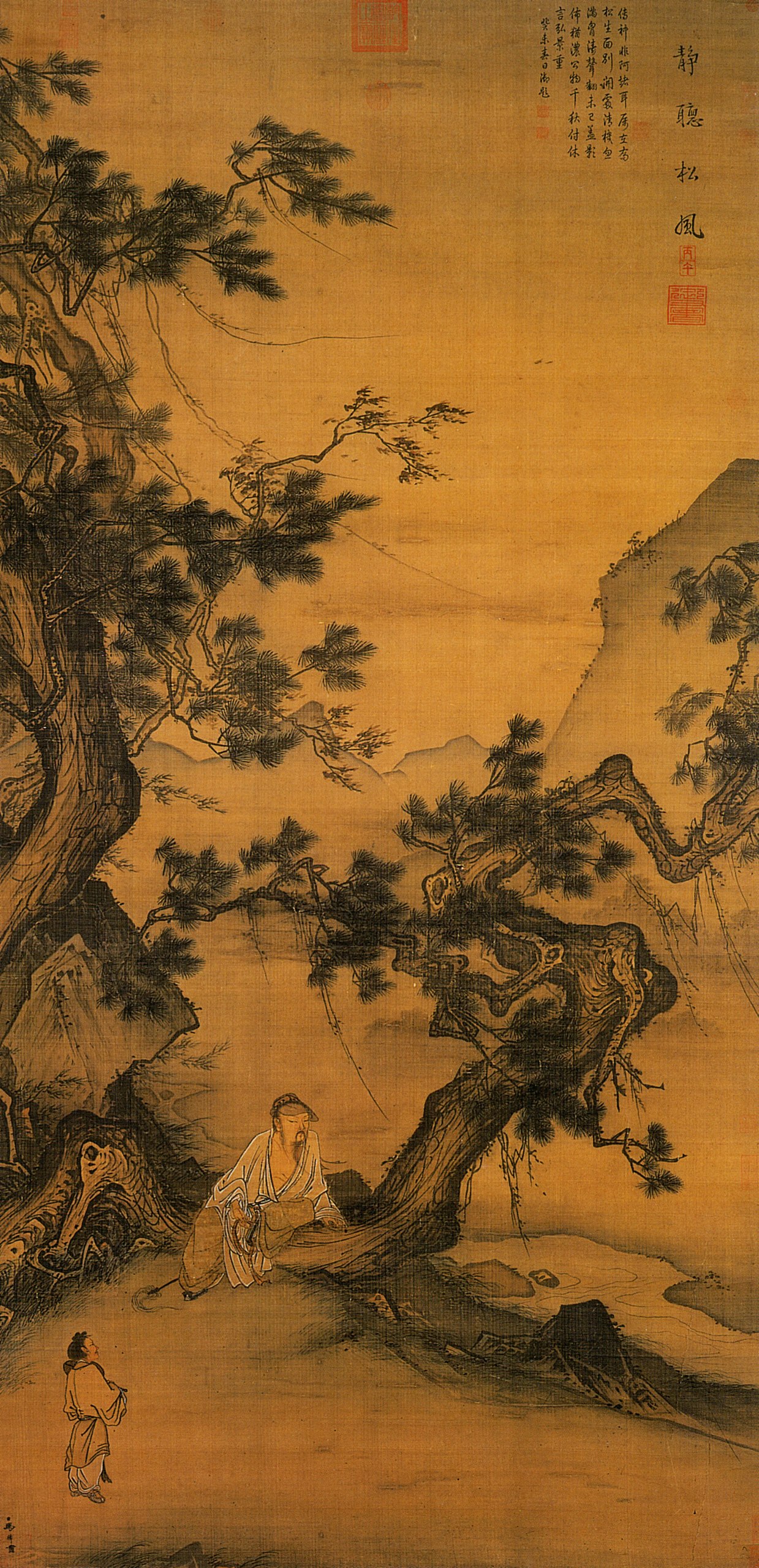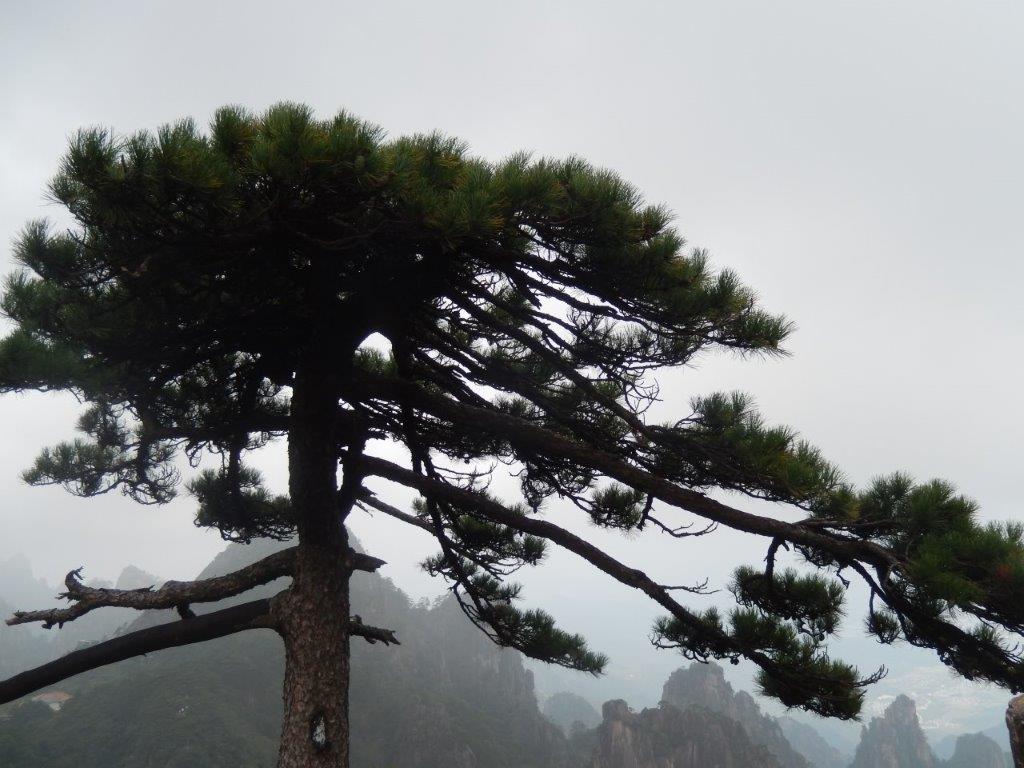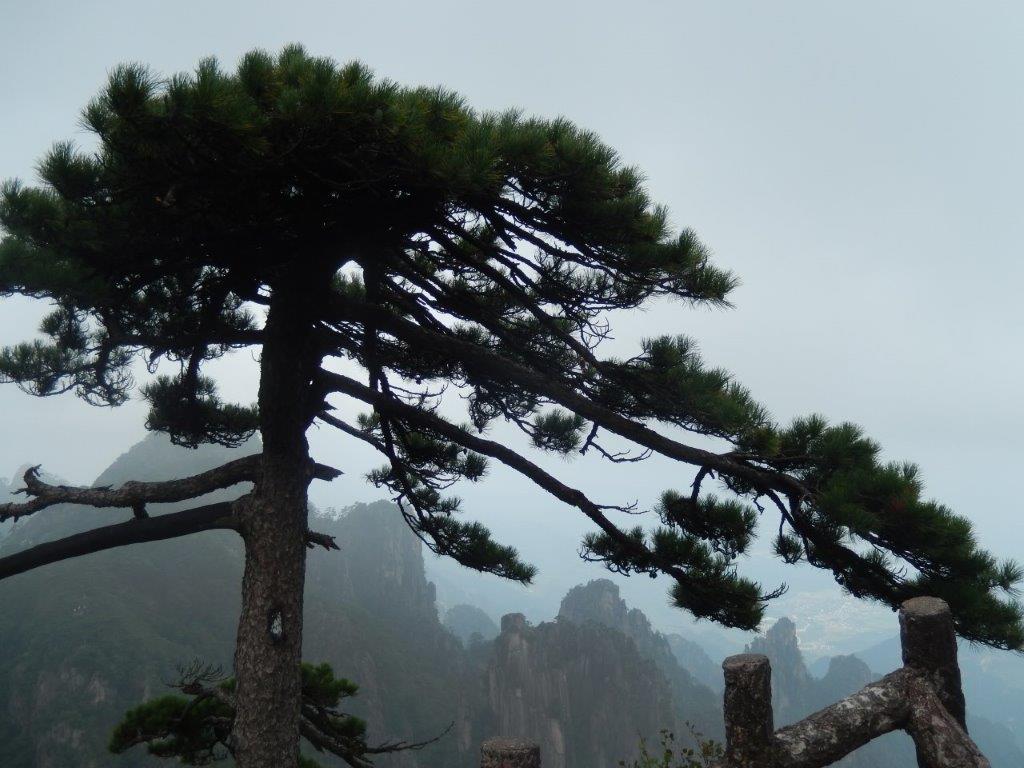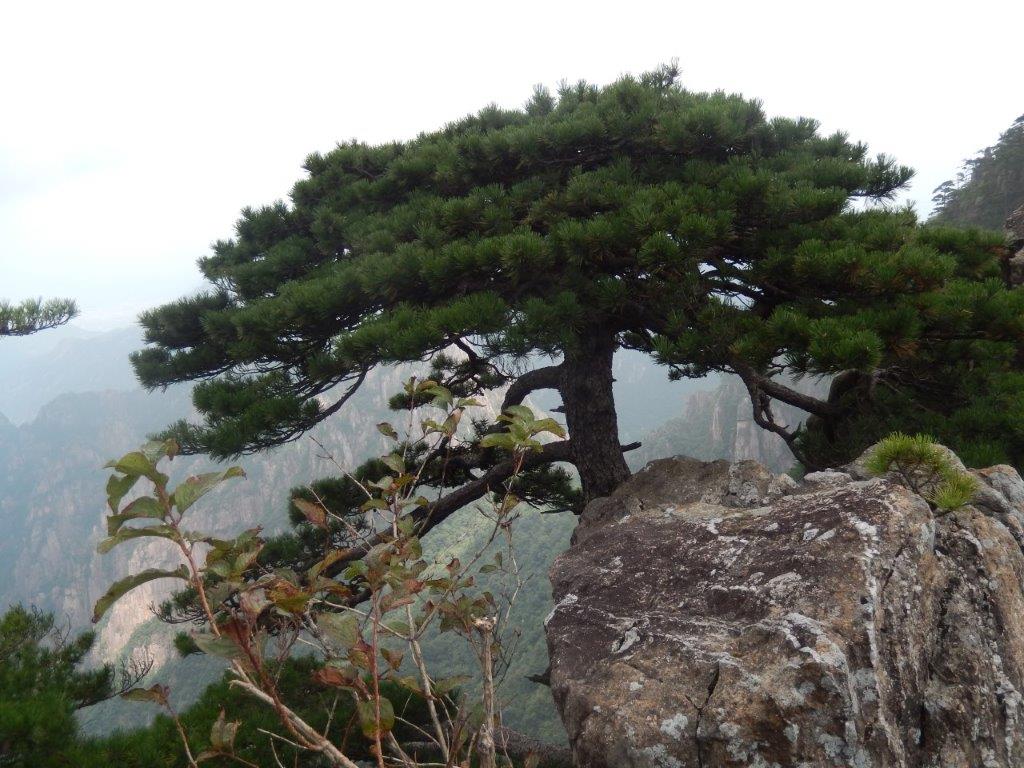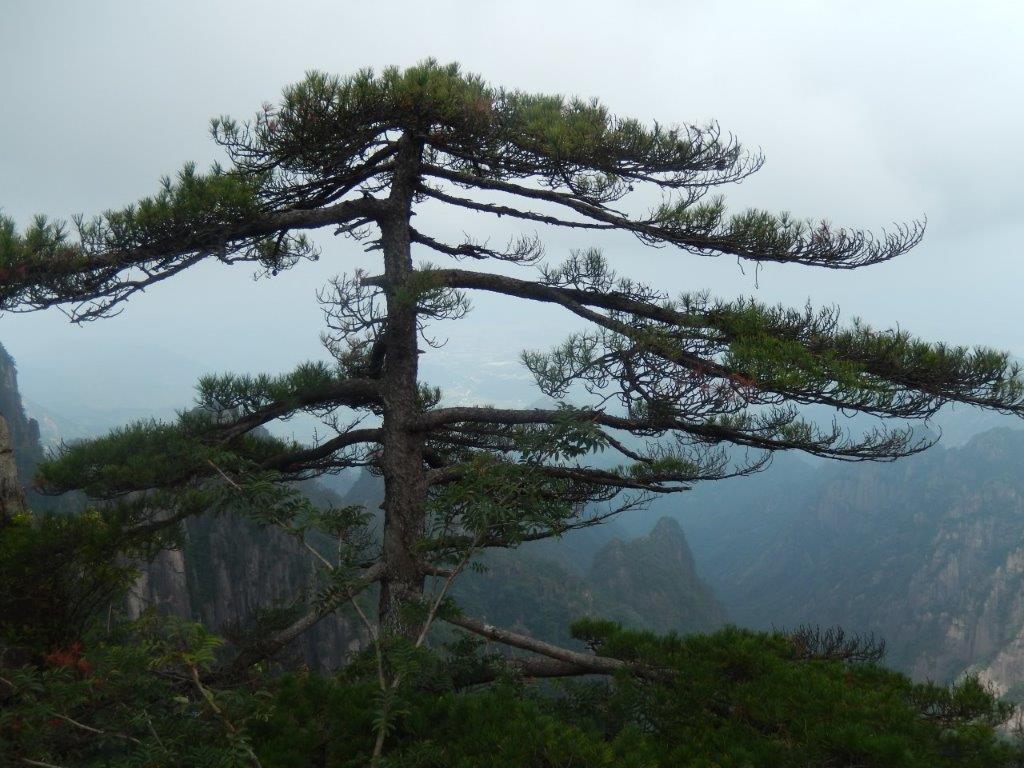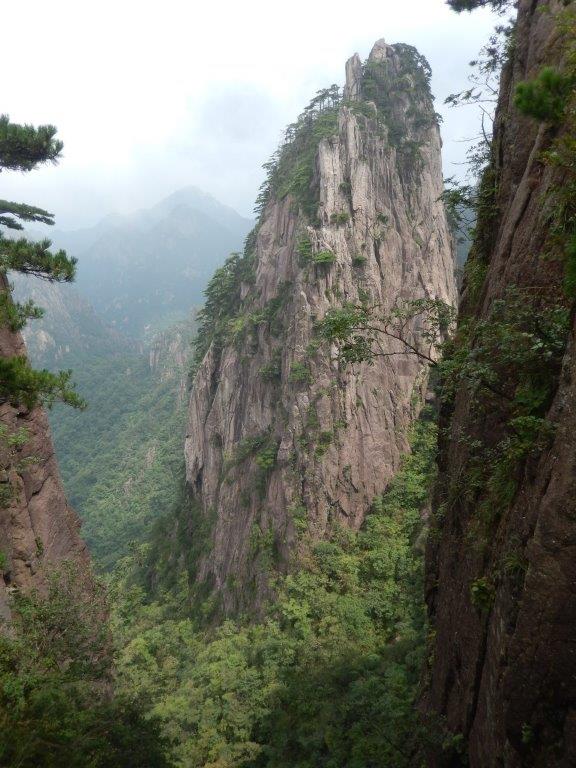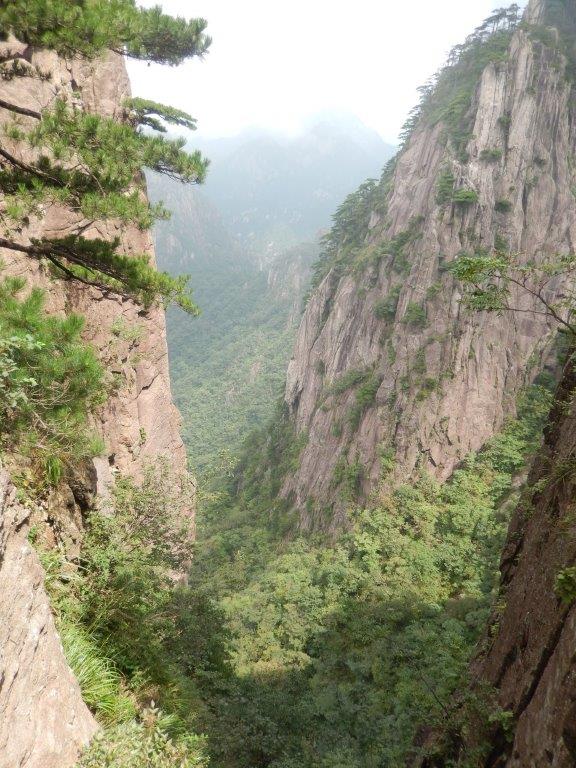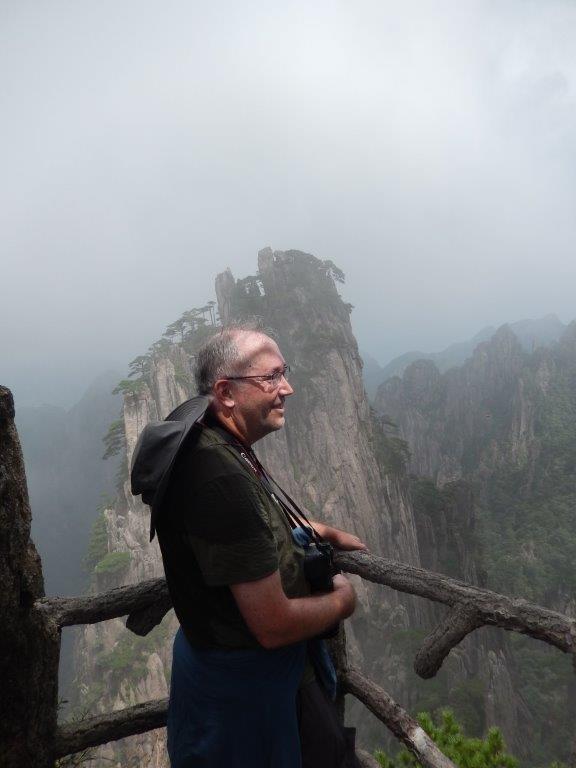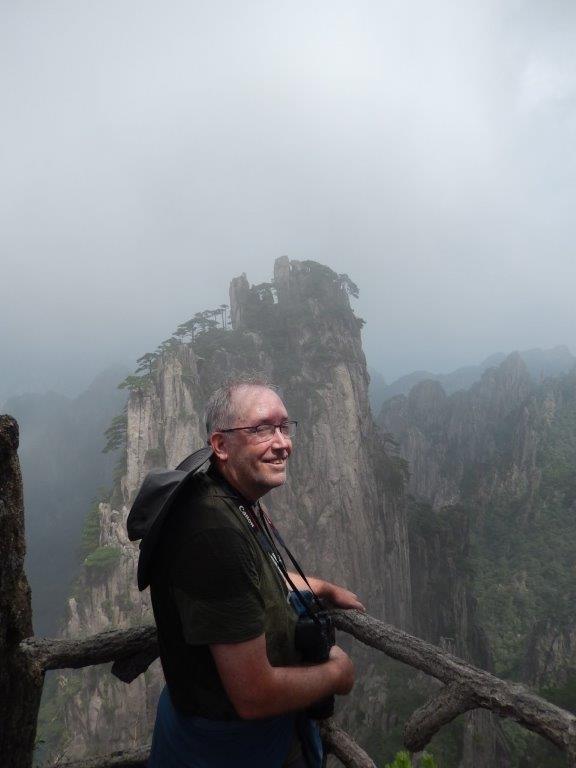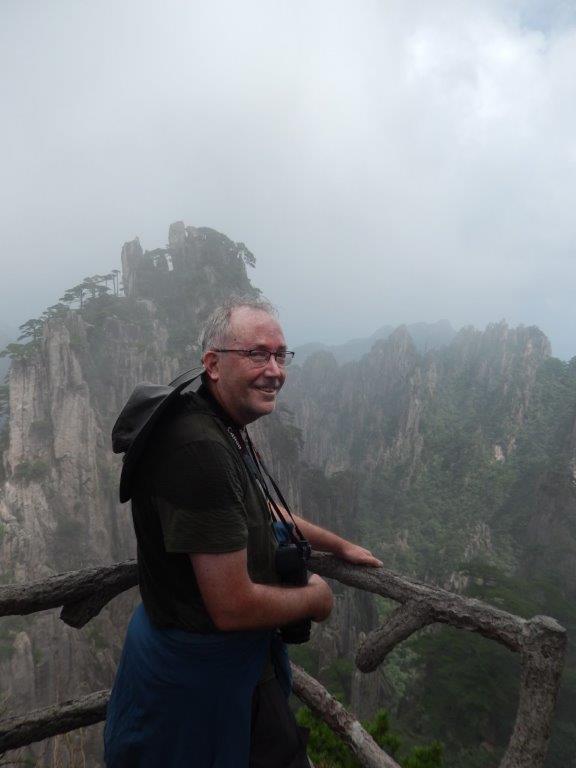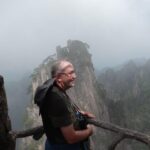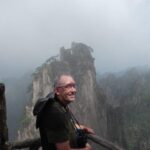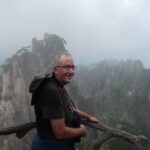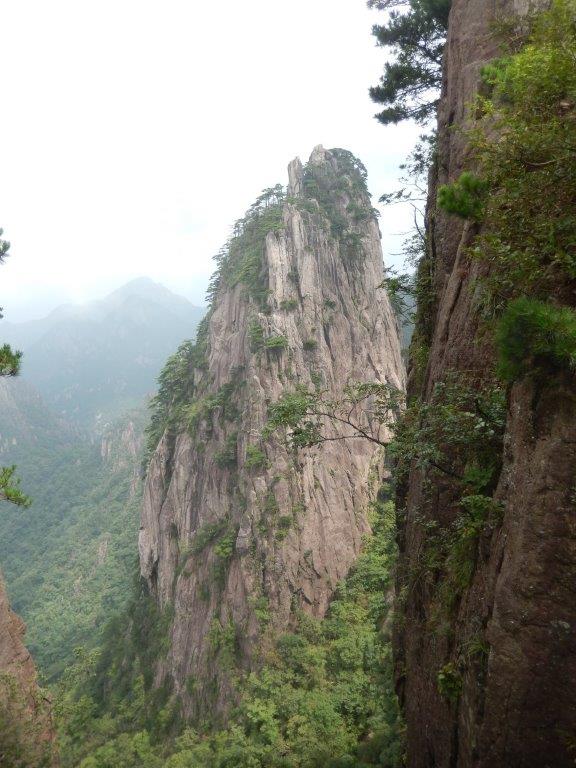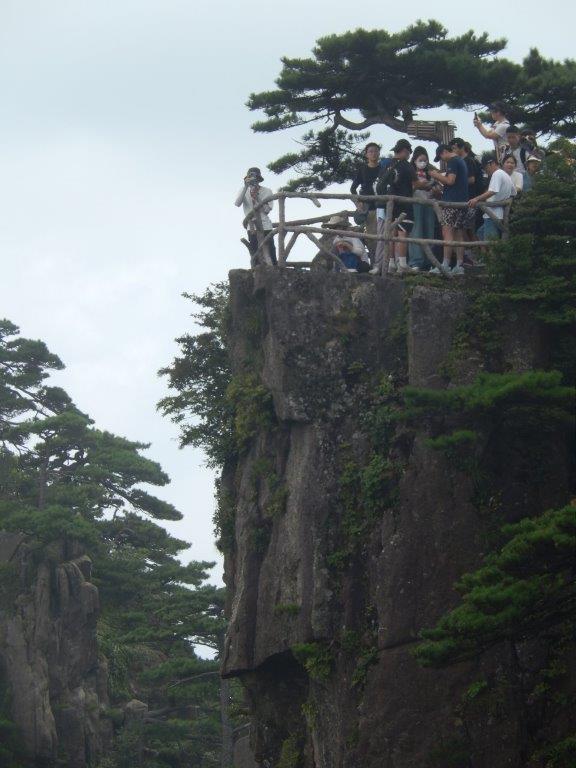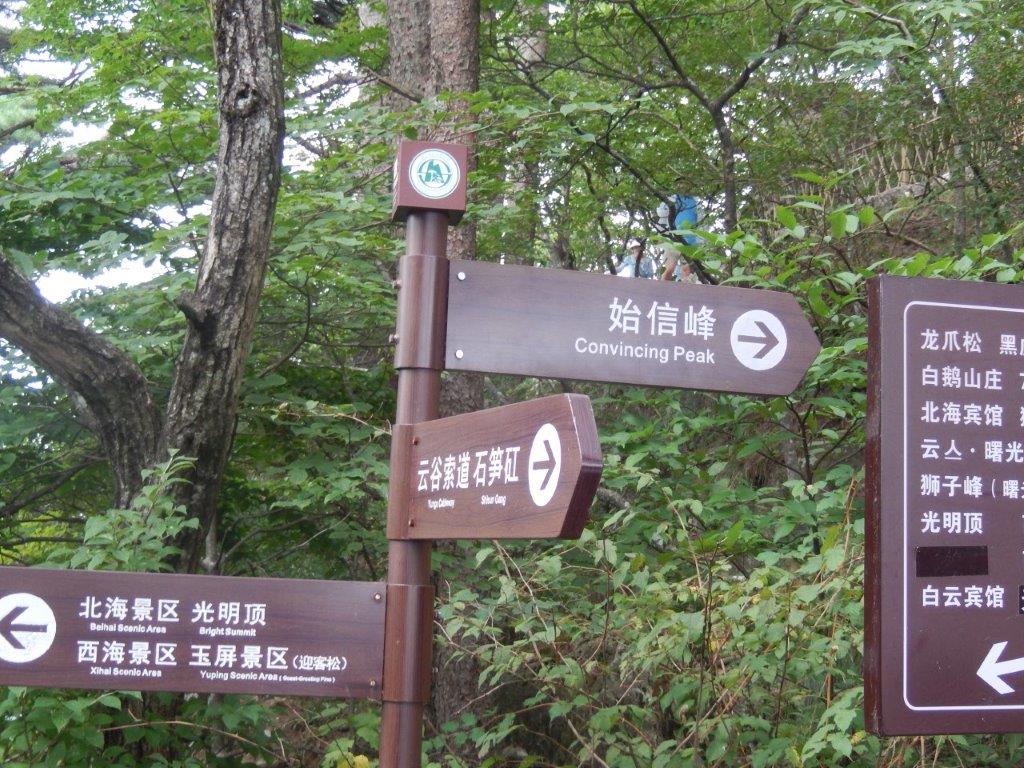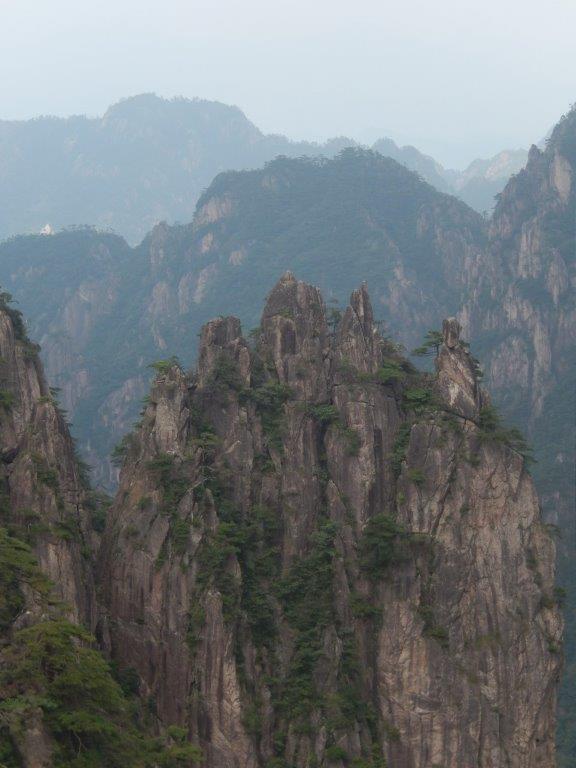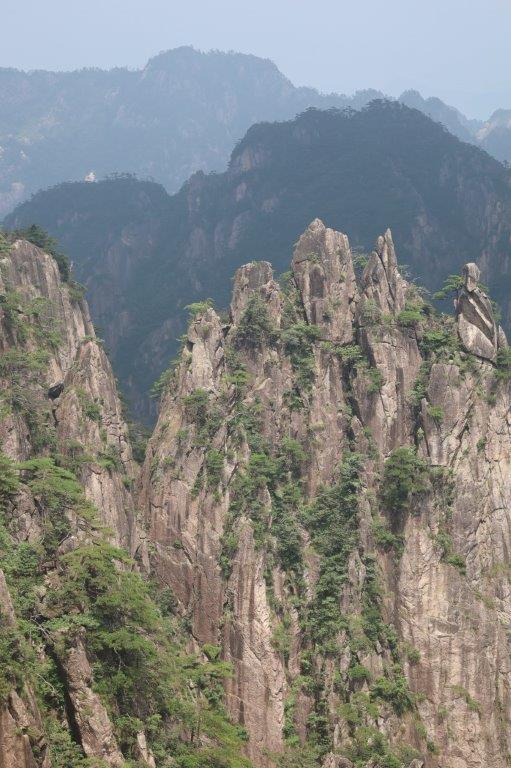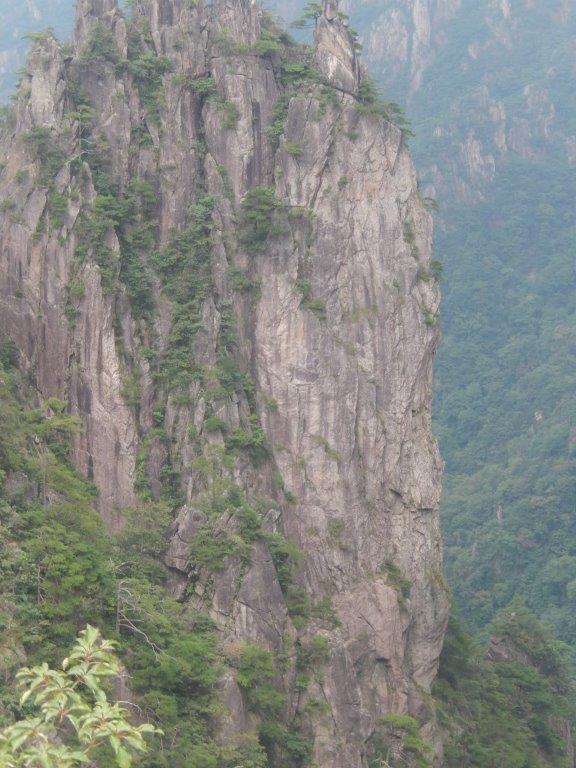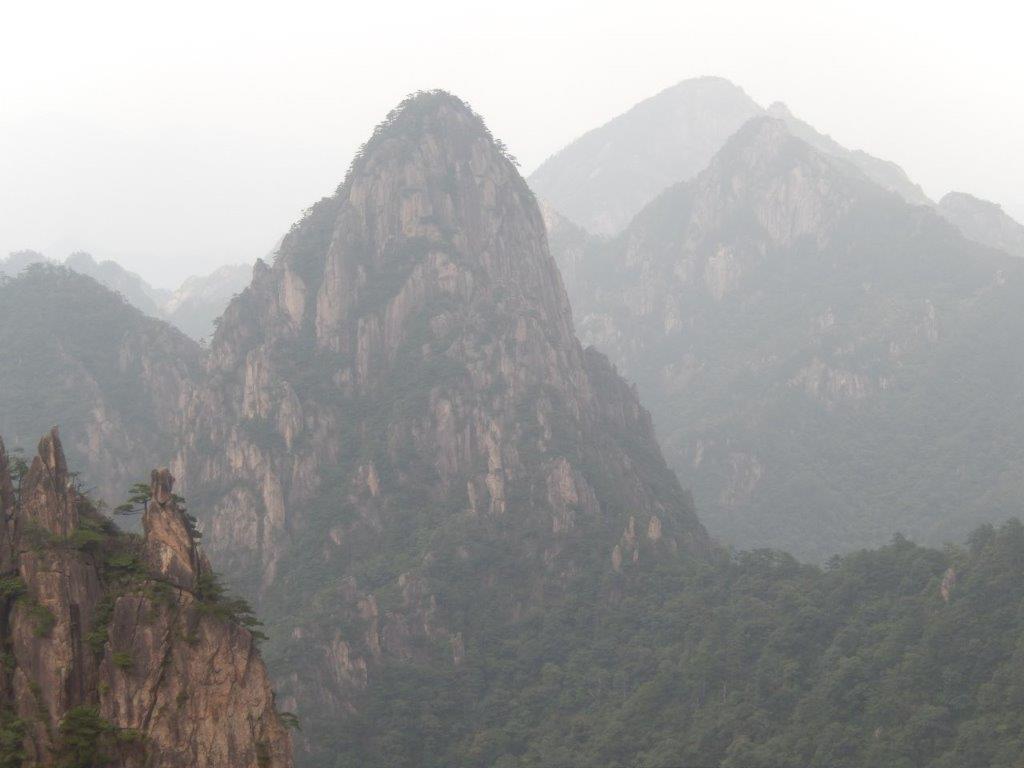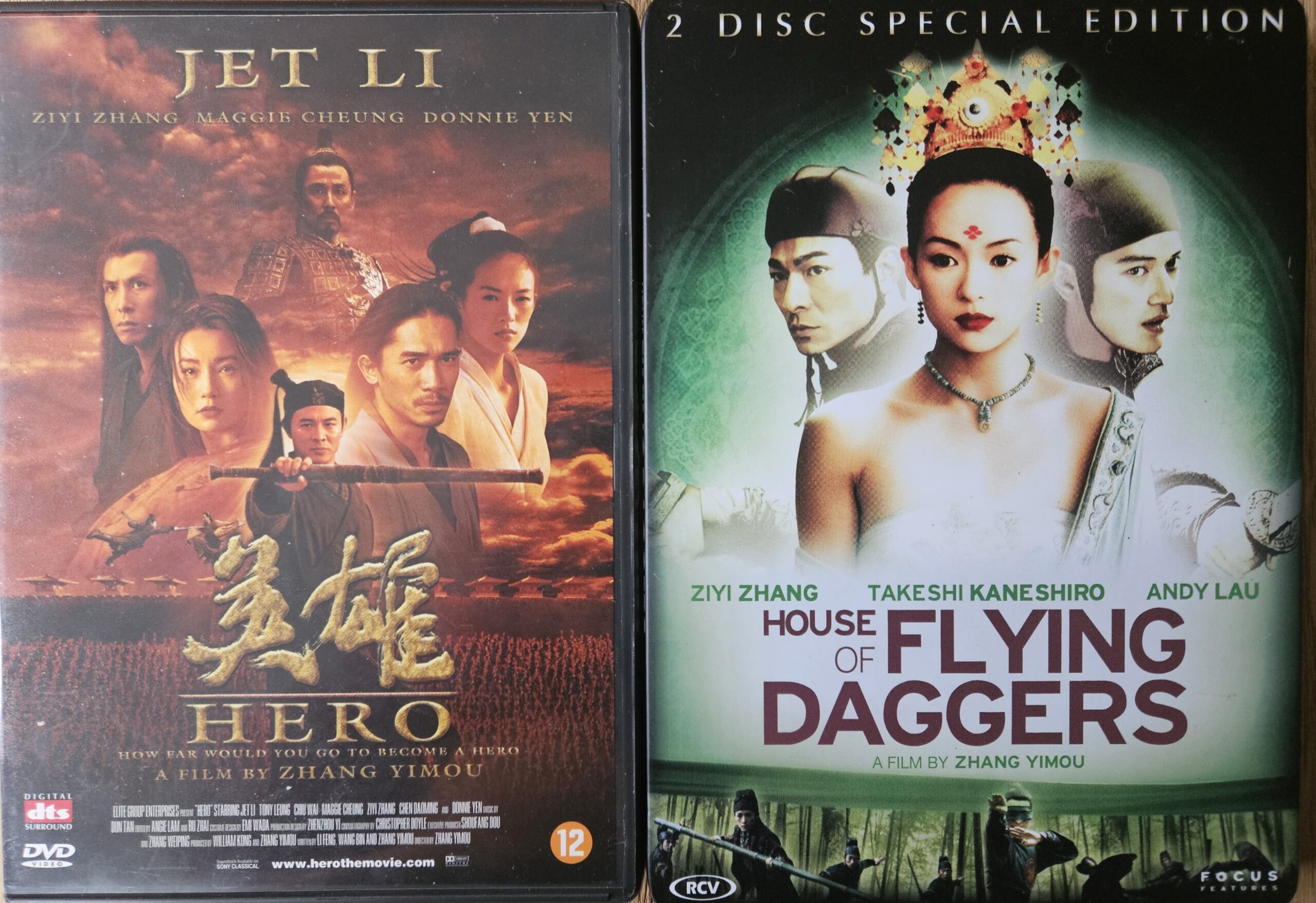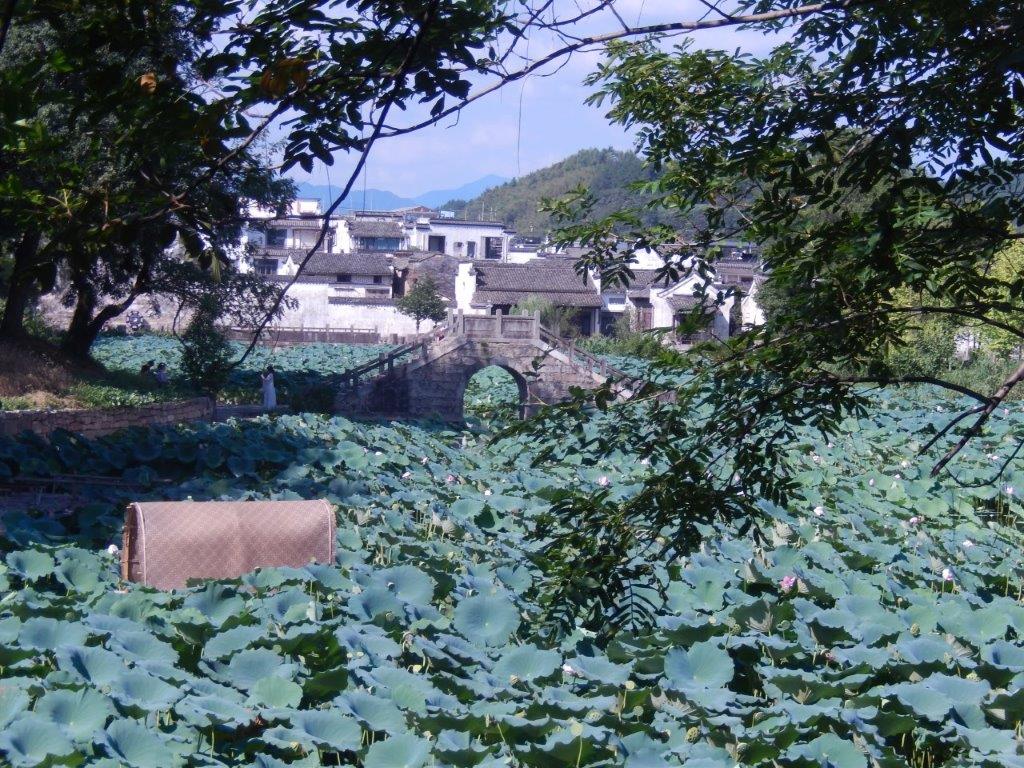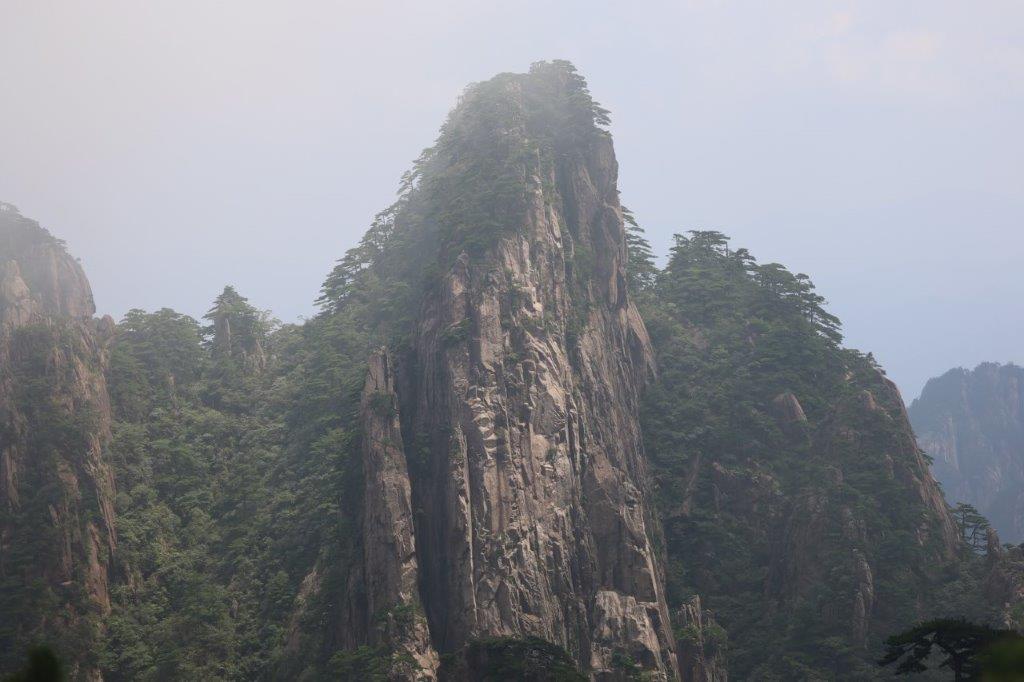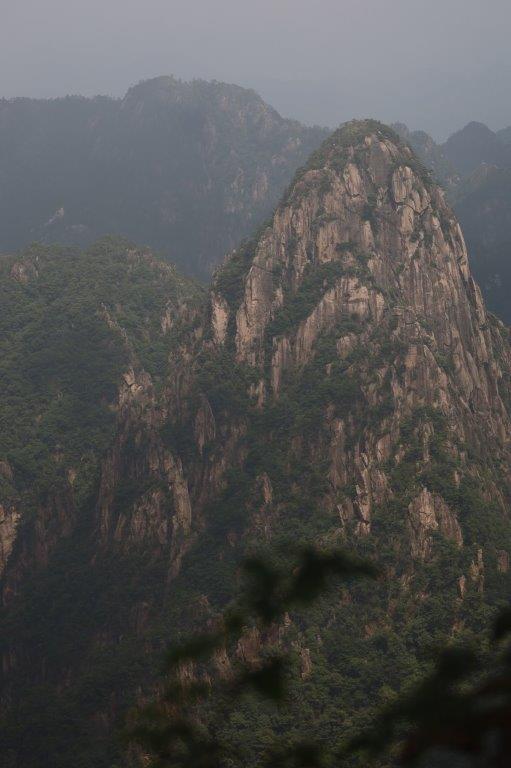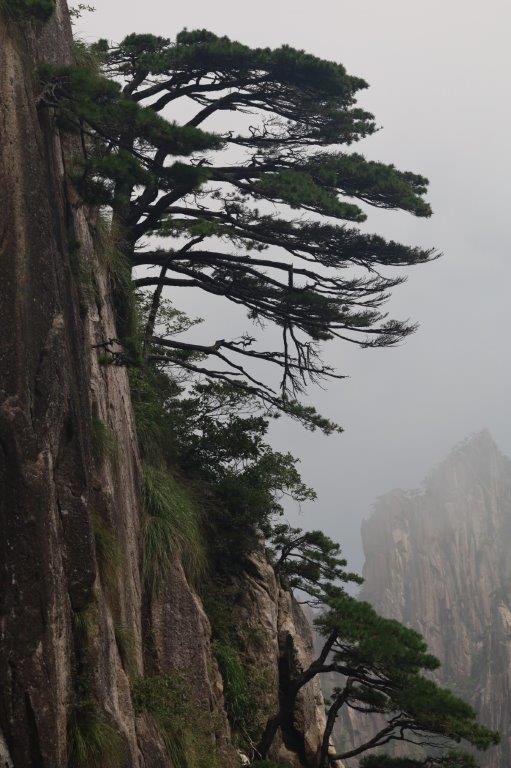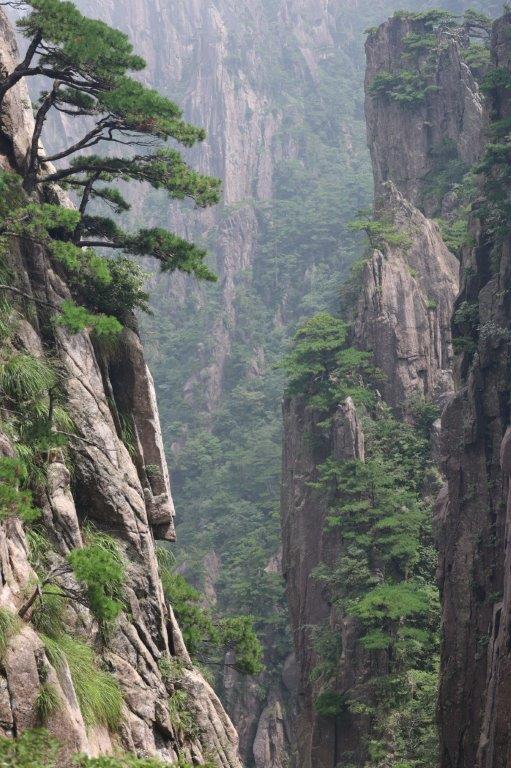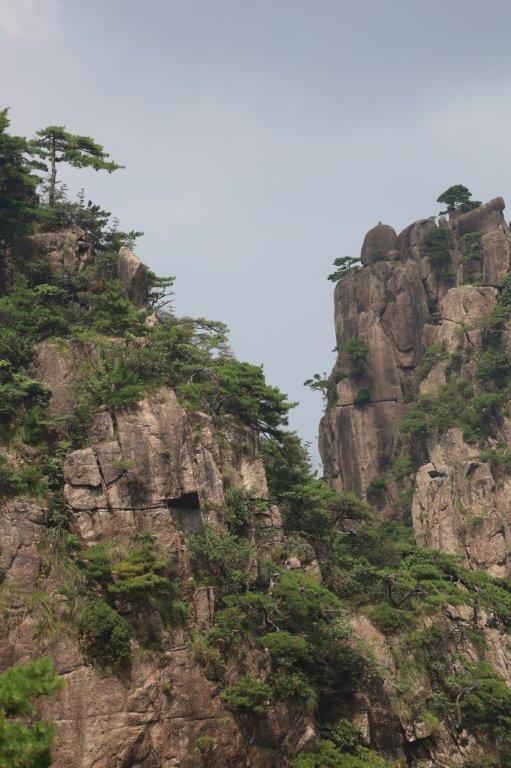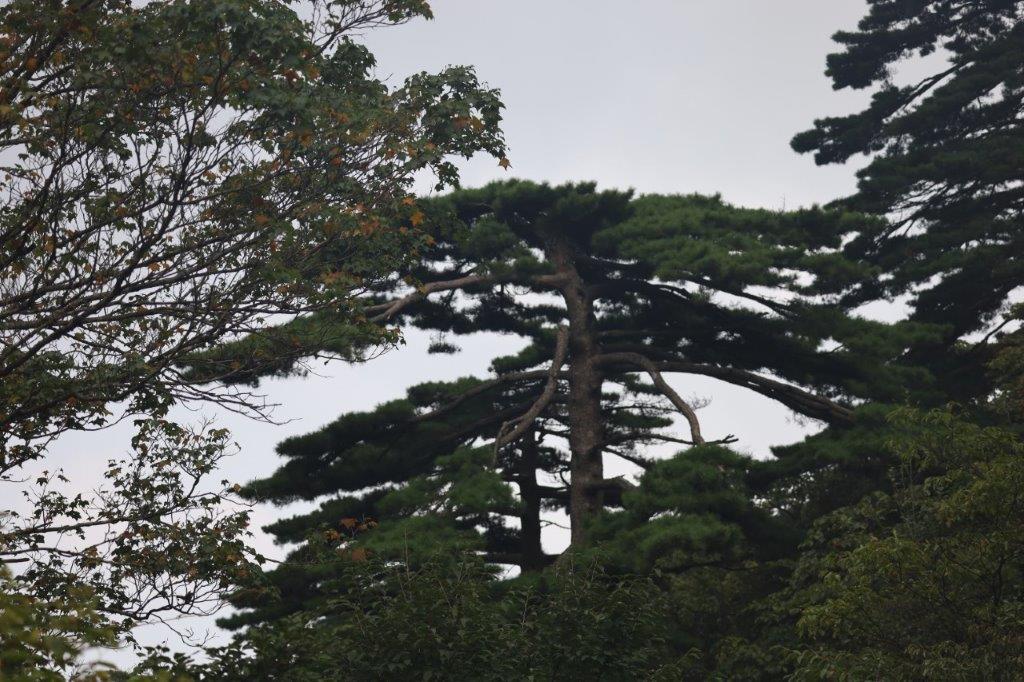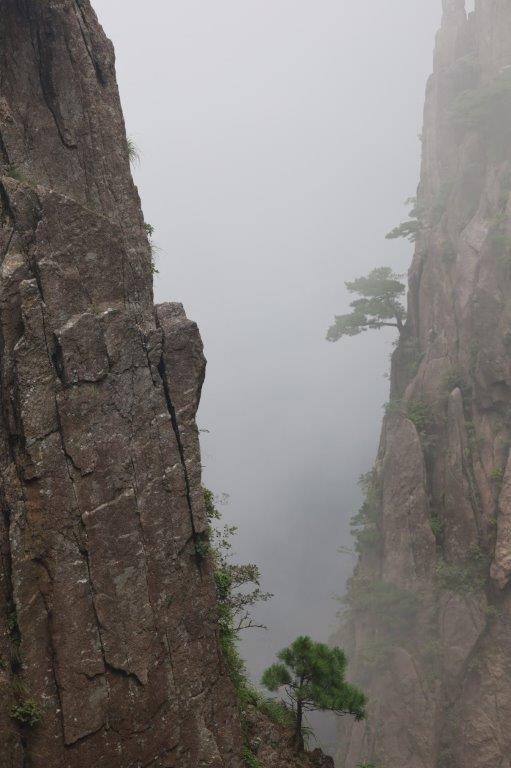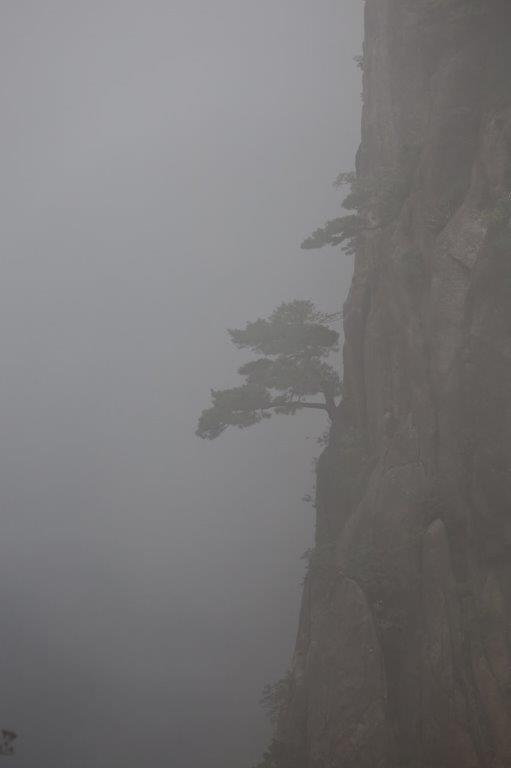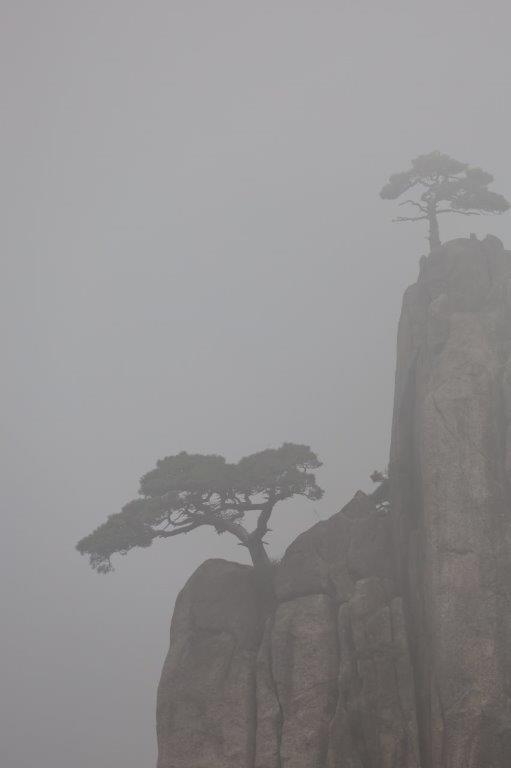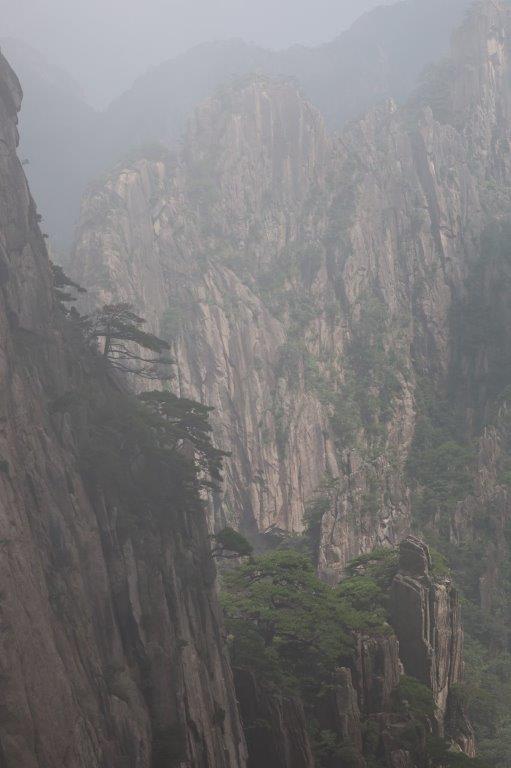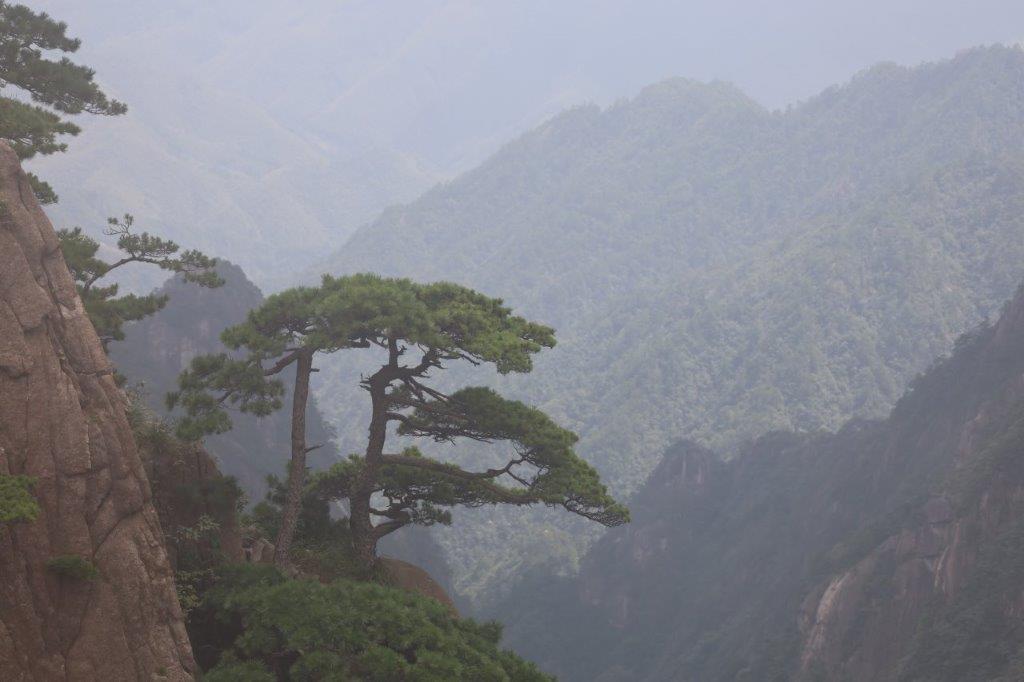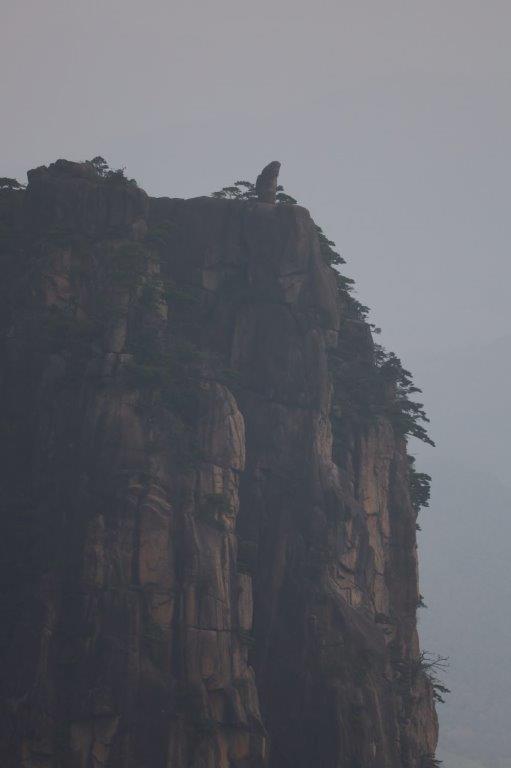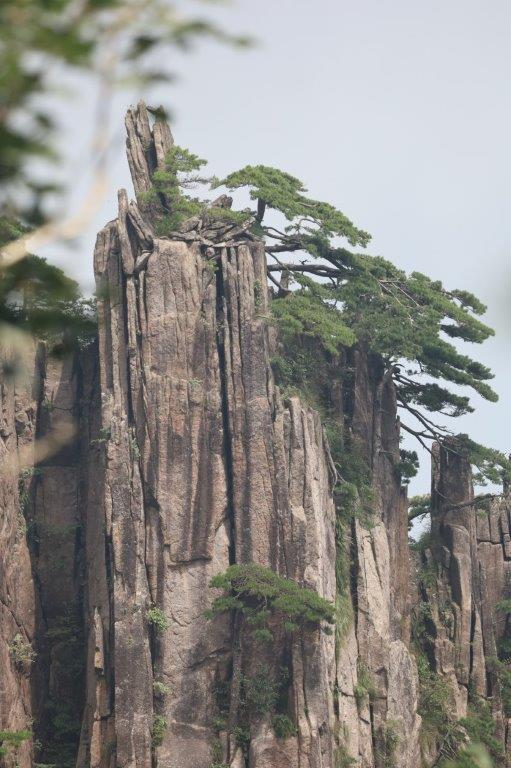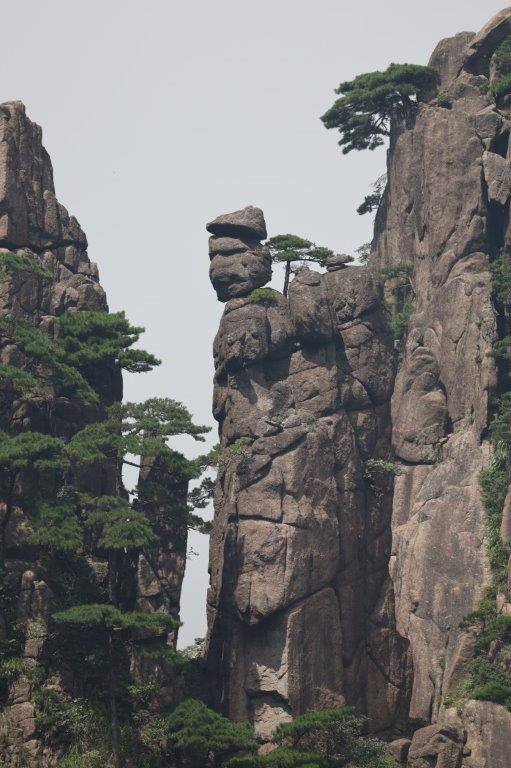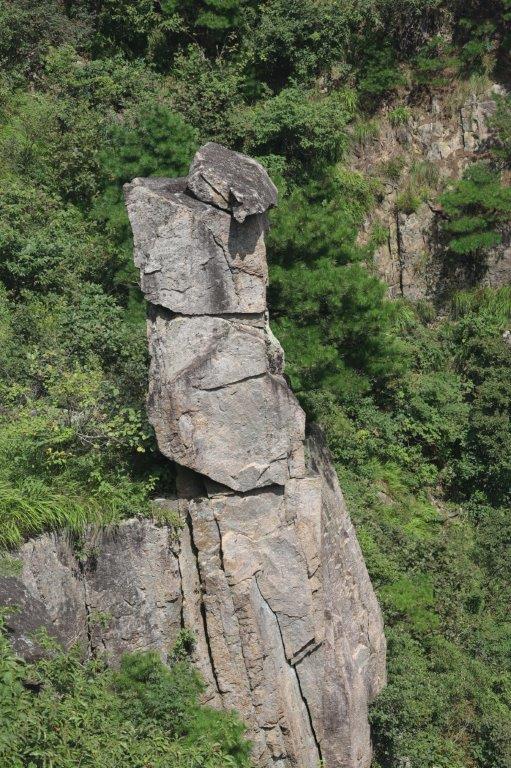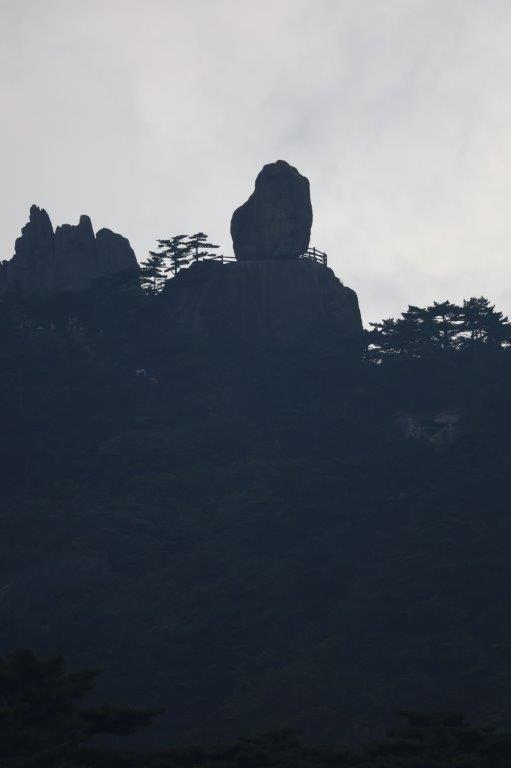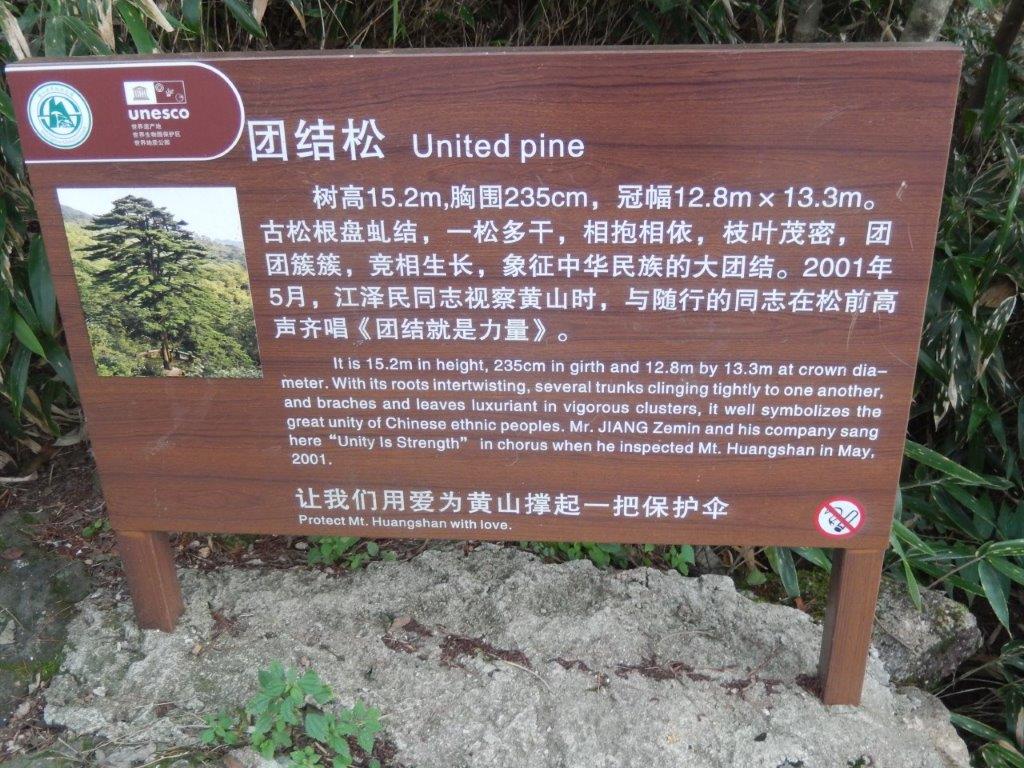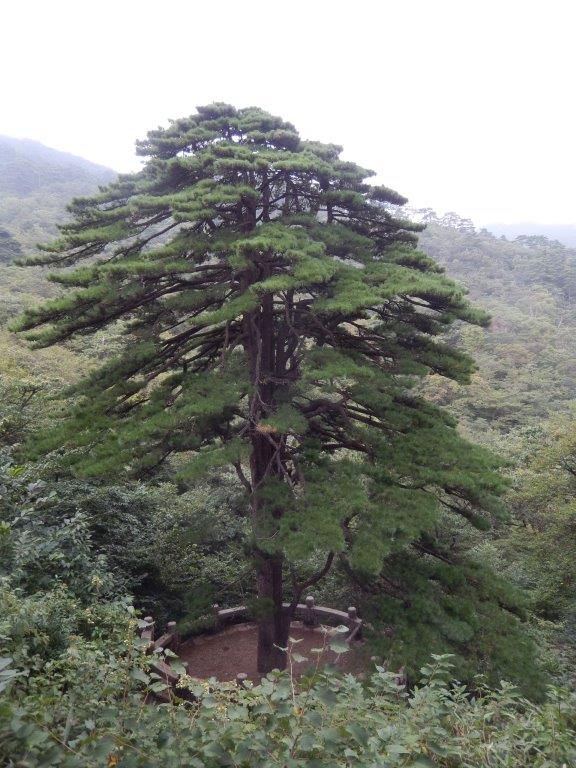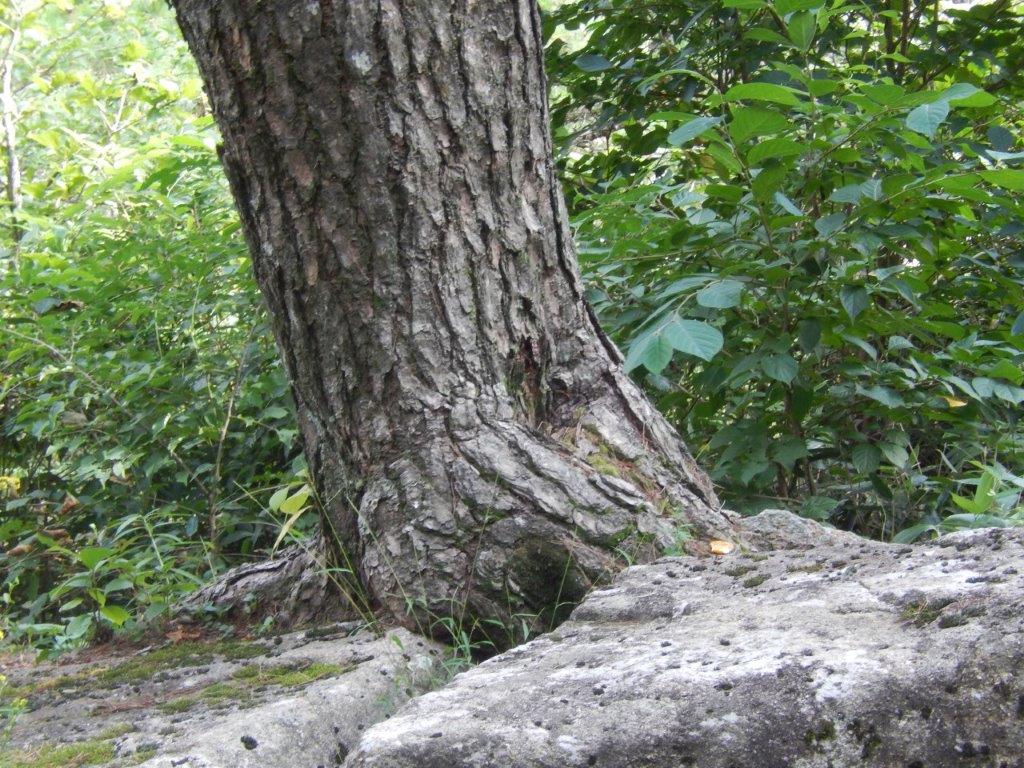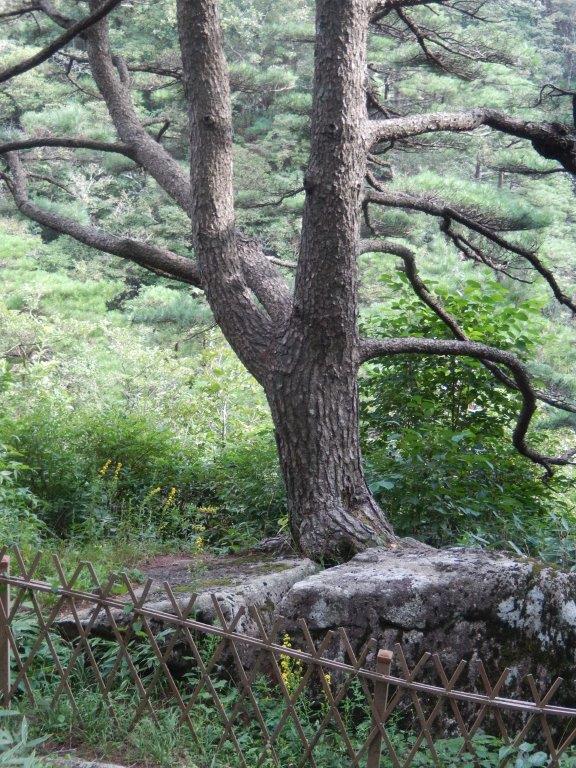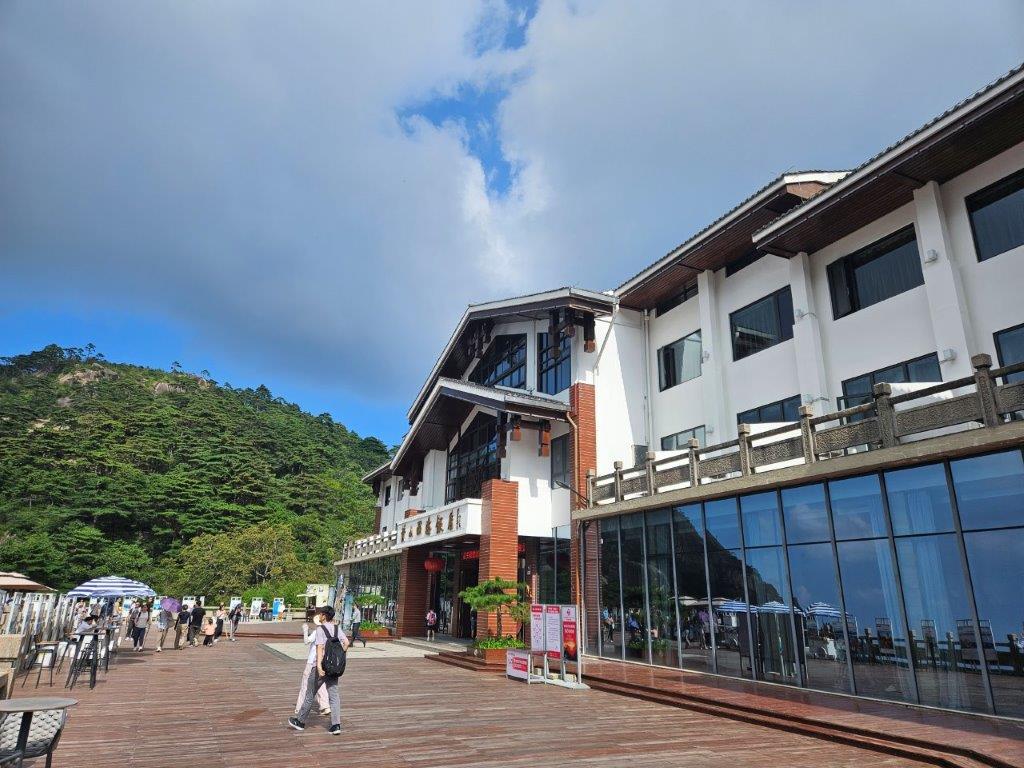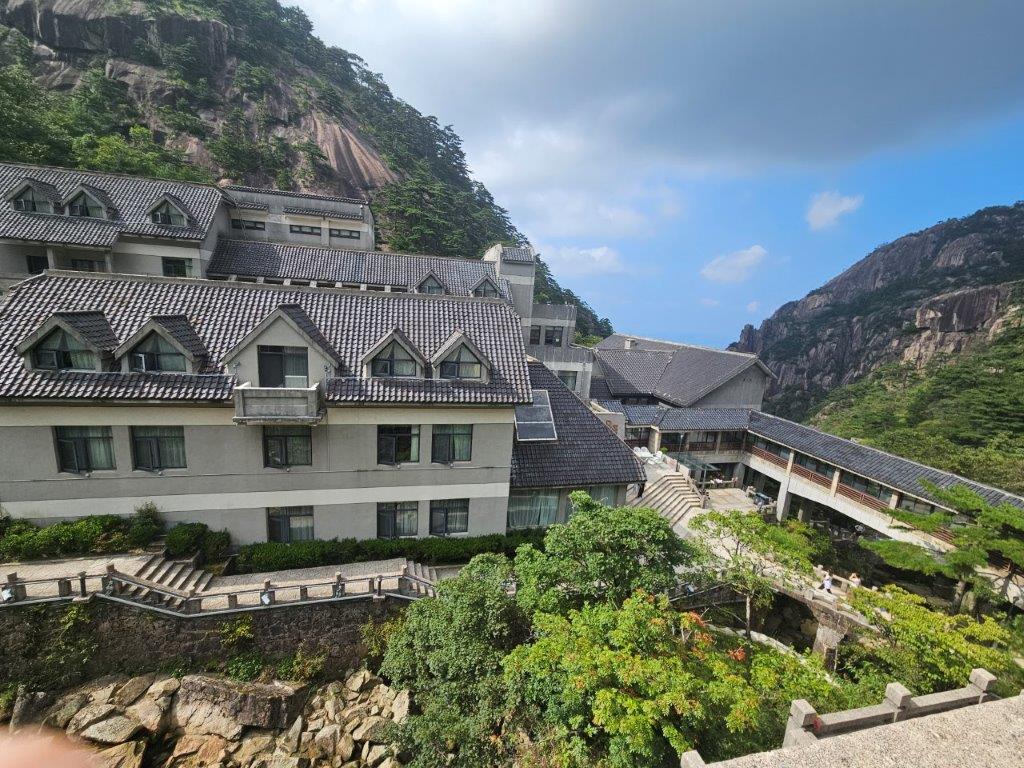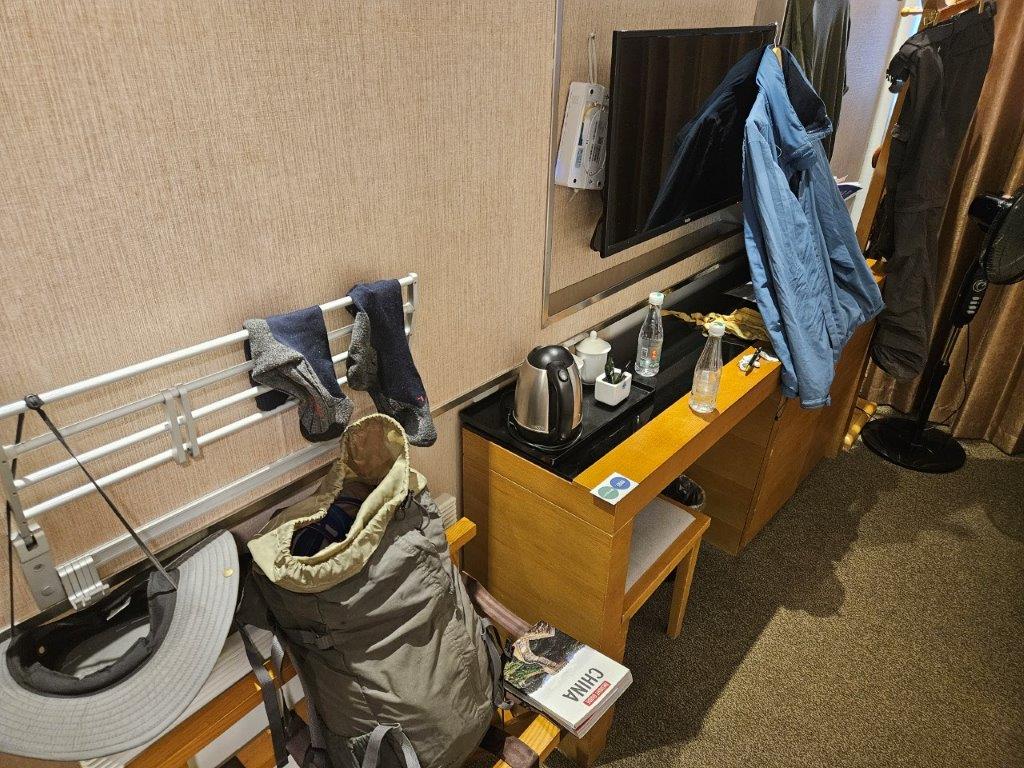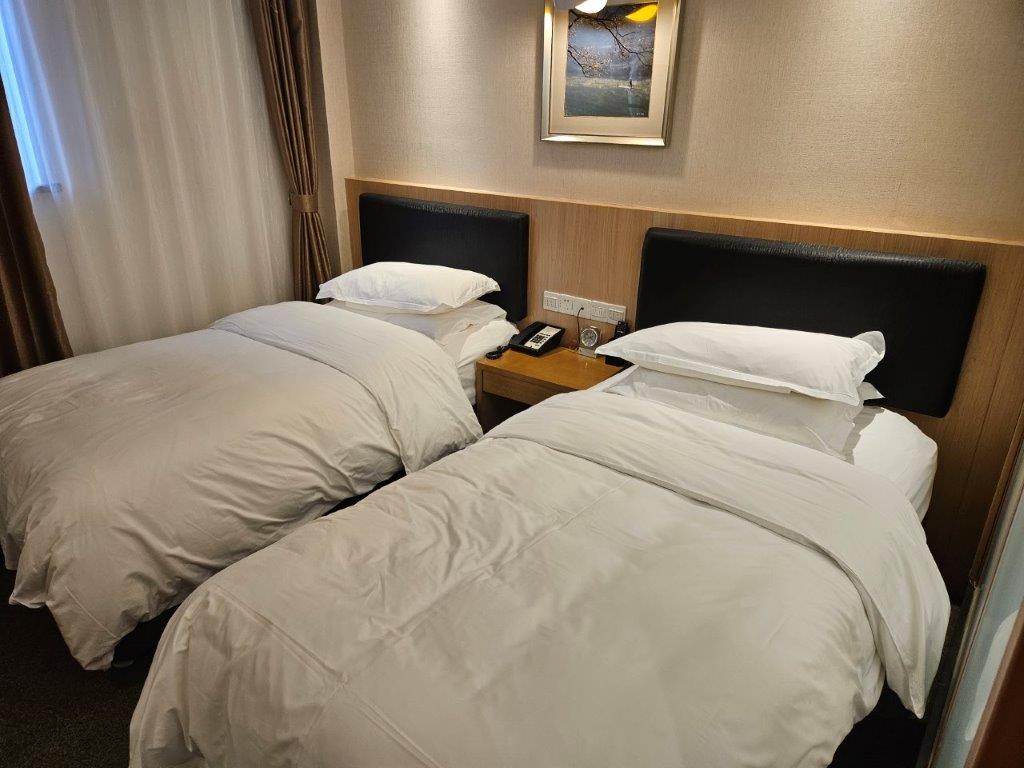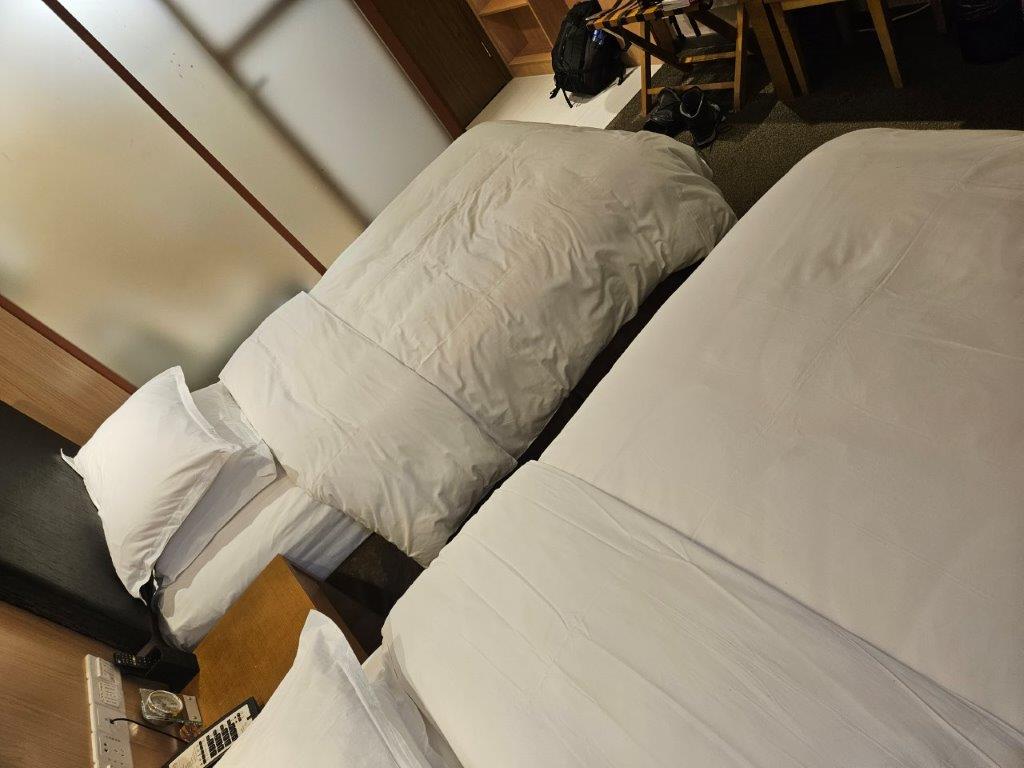6. China/Anhui: Huangshan Mountain Walk 1: White Goose Ridge, Beginning to Believe Peak and including an intro on Shan Shui or Chinese Landscape painting (Huangshan National Park / UNESCO World Heritage)
The next adventure was a quite spectacular one and in retrospect one of my favorites of this journey. After breakfast The Wandelgek was picked up and travelled by car to Huangshan Mountain, the most famous mountain for Chinese people in China.
While driving toward the mountain(s), The Wandelgek again witnessed the phenomenal tunnel building that had made these rural mountainous areas so much better accessible …
It is possible to climb the whole mountain, but The Wandelgek had chosen to use transportation to get to the top and start wandering there. Taxi’s and cars are only allowed until the entrance gates of the National Park.
We drove to the Yungu side of the Huangshan National Park, where from busses went up the mountain before reaching the entrance to the cable cars.
Huangshan National Park
The cable cars went up the mountain and although it was a bit foggy, the views were really great …
There are totally 4 cableways located in different regions on Huangshan Mountain, including the most frequently-used Yungu Cable Car, Yuping Cable Car, Xihai Cable Car and the less-used Taiping Cable Car. It’s convenient to take the cableways up to the mountain top areas and start an authentic hiking trip to famous scenic spots.
Yungu Cable Car 云谷索道
Running Between: Yungu Temple (云谷寺) – White Goose Pavilion (白鹅岭)
Ticket: 80RMB (March ~ November), 65RMB (January, February, December)
Opening Hours: 07:00-17:00
Yungu Cable Car is located in the Back Mountain/ Eastern Route on Huangshan Mountain, and the up station is very close to Beginning to Believe Peak, Lion Peak and Beihai Hotel. It takes just less than 10 minutes by the cable car while the hiking needs about 3 hours.
Huangshan (literally meaning the Yellow Mountain(s)), is a mountain range in southern Anhui province in eastern China. It was originally called “Yishan”, and it was renamed because of a legend that Emperor Xuanyuan once made alchemy here. Vegetation on the range is thickest below 1,100 meters (3,600 ft), with trees growing up to the treeline at 1,800 meters (5,900 ft).
The area is well known for its scenery, sunsets, peculiarly-shaped granite peaks, Huangshan pine trees, hot springs, winter snow and views of the clouds from above. Huangshan is a frequent subject of traditional Chinese paintings and literature, as well as modern photography. It is a UNESCO World Heritage Site and one of China’s major tourist destinations.
The Huangshan mountain range has many peaks, some more than 1,000 meters (3,250 feet) high. The three tallest and best-known peaks are Lotus Peak (Lianhua Feng, 1,864 m), Bright Peak (Guangming Ding, 1,860 m) and Celestial Peak (Tiandu Feng, literally Capital of Heaven Peak, 1,829 m). The World Heritage Site covers a core area of 154 square kilometres and a buffer zone of 142 square kilometres. The mountains were formed in the Mesozoic, approximately 100 million years ago, when an ancient sea disappeared due to uplift. Later, in the Quaternary Period, the landscape was shaped by the influence of glaciers.
The vegetation of the area varies with elevation. Mesic forests cover the landscape below 1,100 meters. Deciduous forest stretches from 1,100 meters up to the tree line at 1,800 meters. Above that point, the vegetation consists of alpine grasslands. The area has diverse flora, where one-third of China’s bryophyte families and more than half of its fern families are represented. The Huangshan pine (Pinus hwangshanensis) is named after Huangshan and is considered an example of vigor because the trees thrive by growing straight out of the rocks. Many of the pine trees in the area are more than a hundred years old and have been given their own names (such as the Ying Ke Pine, or Welcoming-Guests Pine, which is thought to be more than 1500 years old). The pines vary greatly in shape and size, with the most crooked of the trees being considered the most attractive. Furthermore, Huangshan’s moist climate facilitates the growing of tea leaves and the mountain has been called “one of China’s premier green tea-growing mountains. Mao feng cha (“Fur Peak Tea”), a well-known local variety of green tea, takes its name from the downy tips of tea leaves found in the Huangshan area.
The mountaintops often offer views of the clouds from above, known as the Sea of Clouds or “Huangshan Sea” because of the cloud’s resemblance to an ocean, and many vistas are known by names such as “North Sea” or “South Sea.” One writer remarked on the view of the clouds from Huangshan as follows:
To enjoy the magnificence of a mountain, you have to look upwards in most cases.
To enjoy Mount Huangshan, however, you’ve got to look downward.
The area also is host to notable light effects, such as the renowned sunrises. Watching the sunrise is considered a “mandatory” part of visiting the area. A phenomenon known as Buddha’s Light is also well-known and, on average, Buddha’s Light only appears a couple of times per month. In addition, Huangshan has multiple hot springs, most of them located at the foot of the Purple Cloud Peak. The water stays at 42 °C (107.6 °F) all year, and has a high concentration of carbonates. The waters are said to help prevent skin, joint, and nerve illness.
Much of Huangshan’s reputation derives from its significance in Chinese arts and literature. In addition to inspiring poets such as Li Bai, Huangshan and the scenery therein has been the frequent subject of poetry and artwork, especially Chinese ink painting and, more recently, photography. Overall, from the Tang dynasty to the end of the Qing dynasty, more than 20,000 poems were written about Huangshan, and a school of painting named after it. The mountains also have appeared in modern works; director James Cameron cited Huangshan as one of his influences in designing the fictional world of his 2009 film Avatar, and Chinese animated series Stitch & Ai, a spin-off of Disney’s Lilo & Stitch franchise, is set in the Huangshan mountains. These examples of paintings of the Yelloow Mountains/Huangshan Mountains can be found in the restaurant of the Behai Hotel:
The Wandelgek really loves these Chinese paintings, which are comparable to Calligraphy and apart from the beautiful Huangshan Landscapes, there are also paintings of other often mountainous landscapes or of bamboo forests in China of which I’ll show a bit more in later posts. Suffices to know for now that these art forms of paintings, but also photography, were what inspired The Wandelgek to visit these mountains.
The area also has been a location for scientific research because of its diversity of flora and wildlife. In the early part of the twentieth century, the geology and vegetation of Huangshan were the subjects of multiple studies by both Chinese and foreign scientists. The mountain is still a subject of research. For example, in the late twentieth century a team of researchers used the area for a field study of Tibetan macaques, a local species of monkey.
Having at least 140 sections open to visitors Huangshan is a major tourist destination in China. Huangshan City changed its name from Tunxi (屯溪) in 1987 in order to promote Huangshan tourism. In 2007 more than 1.5 million tourists visited the mountain. The city is linked by rail and by air to Shanghai, and also is accessible from cities such as Hangzhou, Zhejiang and Wuhu, Anhui. Buses connect Huangshan City to the base of the mountain, where visitors can take a cable car or hike to the summit.
There are more than 50 kilometers of footpaths providing access to scenic areas for visitors and staffers of the facilities. Throughout the area there are hotels and guest houses that accommodate overnight visitors, many of whom hike up the mountains, spend the night at one of the peaks to view the sunrise, and then descend by a different route the next day. The area is classified as a AAAAA scenic area by the China National Tourism Administration.
Huangshan is known for its stone steps, carved into the side of the mountain, of which there may be more than 60,000 throughout the area. The date at which work on the steps began is unknown, but they have been said to be more than 1,500 years old.
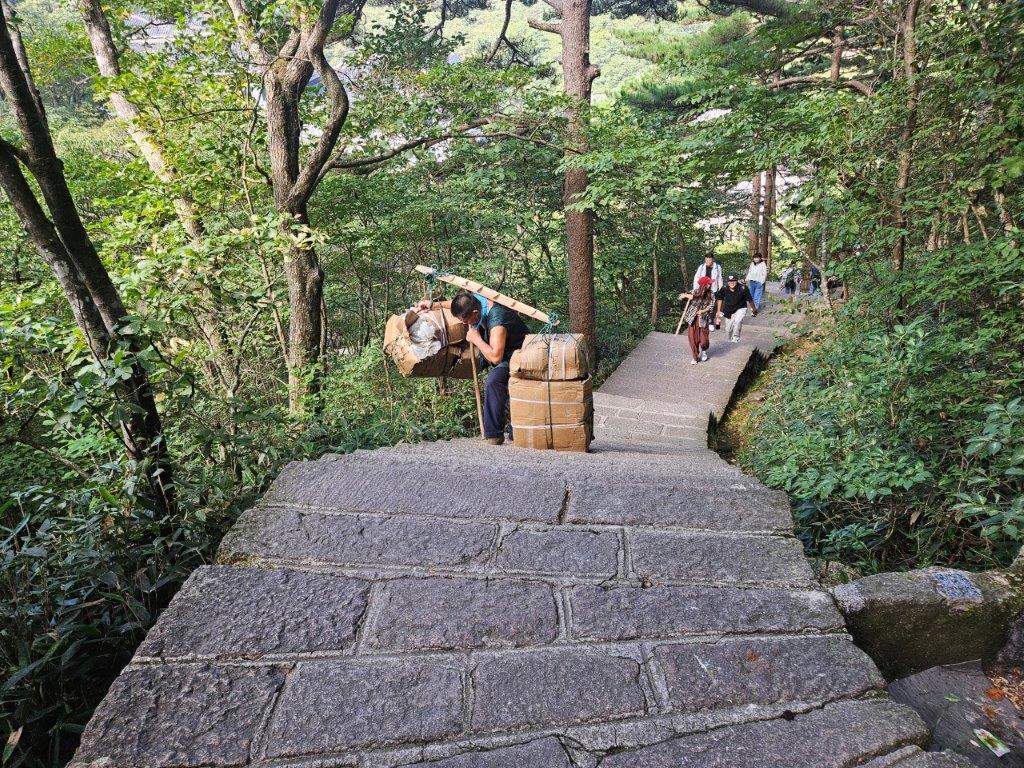 The hotels, restaurants, and other facilities at the top of the mountain are serviced and kept stocked by porters who carry resources around the mountain on foot, hanging their cargo from long poles balanced over their shoulders or backs.
The hotels, restaurants, and other facilities at the top of the mountain are serviced and kept stocked by porters who carry resources around the mountain on foot, hanging their cargo from long poles balanced over their shoulders or backs.
There was also a new hotel being built on top of the mountain. Building activities had started in 2020, 4 years ago and were about to finish in 2025. The porters were also carrying building materials from the cable cars up to the hotel. Louise mentioned that in her youth porters were going up carrying stuff from the foot of the mountain to the top, because there were no cable cars yet.

You simply have to admire the stamina and physical strength of these guys who were seldomly seen pausing on a hot day like this. The porters could also be hired by travellers or tourists to bring their luggage to the hotel. The Wandelgek did hire a porter like that, because he didn’t want to take all his luggage on his first mountain walk, which he could now start from the cable car station.
The Wandelgek started his first walk from the cable car station towards the Behai Hotel. But he took a detour to get there which would get him to see some really marvellous views. His walking took him first to the: route
White Goose Ridge
This mountain ridge resembles some scarves of broken dishes, maybe made of China 😉.
The Wandelgek had loads of time to reach his hotel so he strolled slowly through this landscape which was breathtaking at every new step …
This was also literally quite breathtaking, because of the height of the walk which went up and down and up and down again on a height of approximately 1800 meters. There were over 60.000 steps often carved from the rocks that formed the many walkways. These walks are quite a workout and I think I never saw as many steps as this in sich a relatively small area. Not that the area for walks was small, because it was
Huangshan was formed approximately 100 million years ago and gained its unique rock formations in the Quaternary Glaciation.
So why and when are these mountains yellow? At sunrise or sunset or under specific light conditions? Turns out the name is not associated to the color, but to the name of an emperor.
During the Qin dynasty, Huangshan was known as Yishan (Mount Yi). In 747 AD, its name was changed to Huangshan (Mount Huang) by imperial decree; the name is commonly thought to have been coined in honor of Huang Di (the Yellow Emperor), a legendary Chinese emperor and the mythological ancestor of the Han Chinese. One legend states that Huangshan was the location from which the Yellow Emperor ascended to Heaven. Another legend states that the Yellow Emperor “cultivated moral character and refined Pills of Immortality in the mountains, and in so doing gave the mountains his name. The first use of this name “Huangshan” often is attributed to Chinese poet Li Bai. Huangshan was fairly inaccessible and little-known in ancient times, but its change of name in 747 AD seems to have brought the area more attention; from then on, the area was visited frequently and many temples were built there.
Over the years, many scenic spots and physical features on the mountain have been named; many of the names have narratives behind them. For example, one legend tells of a man who did not believe the tales of Huangshan’s beauty and went to the mountains to see them; almost immediately, he was converted to the same view. One of the peaks he is said to have visited was named Shixin (始信), roughly meaning “start to believe.”
In 1982, Huangshan was declared a “site of scenic beauty and historic interest” by the State Council of China. It was named a UNESCO World Heritage Site in 1990 for its scenery and for its role as a habitat for rare and threatened species. Subsequently, certified as a National Geopark, and then as a regional geopark (Asia Pacific Geopark Network), it was admitted as a UNESCO Global Geopark in 2004.
The walkways were often “glued” to the mountain and seen from a distance I often couldn’t believe having walked over those tiny, narrow paths …
The Wandelgek had brought his camera bag for this walk and used his Nikon Coolpix as well as his Canon EOS RP for most of the photos. The EOS body was attached to his 100 to 400 mm telephoto lens and used for most close ups and zoomed details and the Coolpix he used for the overall landscape photos.
There was a lot of time and the mountain weather changed quite a bit during this walk from sunny to cloudy to foggy. It was nice to be able to just sit down several times, or stand at a cliff’s edge to absorb all these changes for a while without feeling guilty of stalling a travel group.
The paths to get here are steep but doable for everyone with a good physical condition, but most impressive were the trails of wood that were glued to the steep mountain slopes. There had been a show on television where they showed what the architects and designers and builders of these trails had to endure to get the job done and it showed they had to be professional mountaineers as well, using mountaineering boots, crampons, a climbing helmet, an ice axe are standard, ropes, harness and crevasse rescue equipment to protect against crevasse falls. And then the building materials need to be brought up there as well.
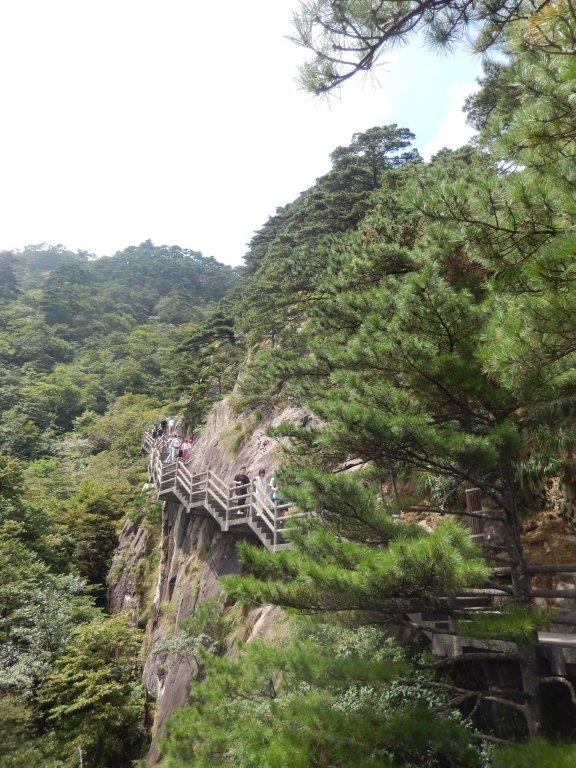
It must have been a gigantic job to carve all these steps and build the little walls and pillars, protecting people from falling into the abyss.
1. Stalagmite Peak
The Wandelgek reached Stalagmite Peak in the early afternoon. The Stalagmites which were seen from this view point were quite amazing. Some were as thin as needles, pointing upward. Most of the rocky area of Huangshan is Granite, a very hard rocktype, so no worries about these fragile looking rock needles. They will still be here for many centuries and probably much longer …
Apart from photographing the landscape, The Wandelgek took time to let everything he saw sink in …
It was like he had been drawn into one of those Chinese drawings he so admired …
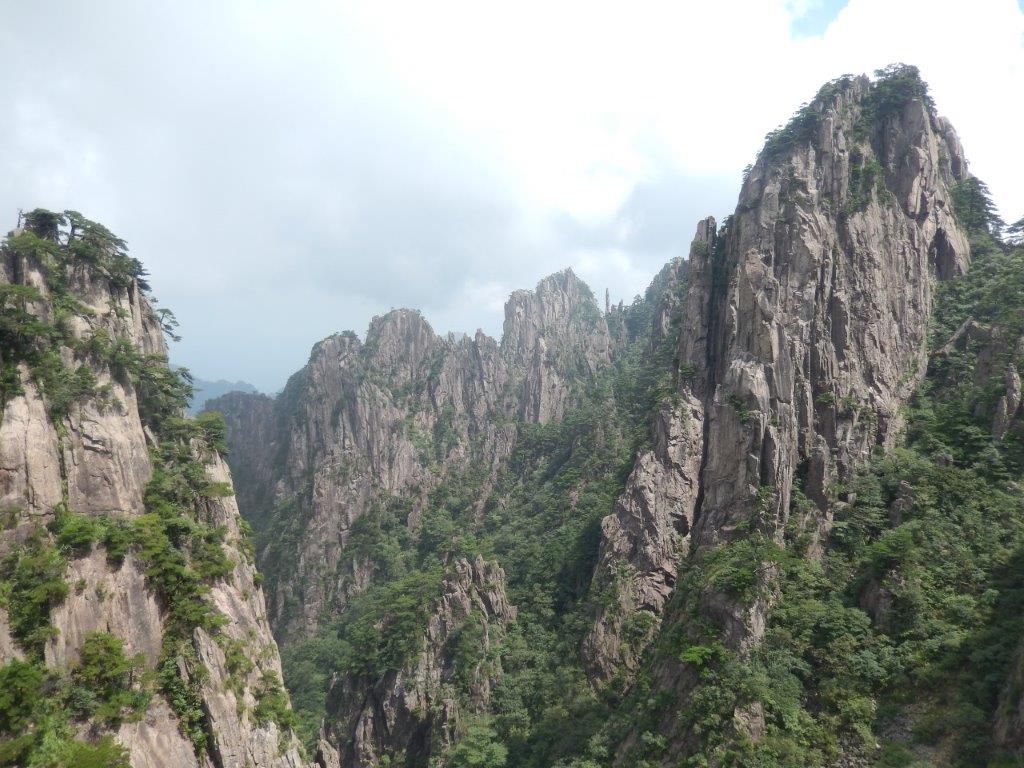 The Stalagmite ensemble that gave its name to this rock formation seemed almost fragile, seen from afar and surrounded by massive mountains…
The Stalagmite ensemble that gave its name to this rock formation seemed almost fragile, seen from afar and surrounded by massive mountains…
The formation looked like a lady (left), looking down upon a stooping servant (center), followed by one or two standing servants (right) …
It had been quite sunny up till then but now the weather was quickly changing. On the east coast a hurricane was entering China, but although it would probabky not reach Huangshan Mountain, there was a change in weather conditions noticeable …
Here on top of the mountain it was about 27° Celsius, while in the villages and towns down there it was about 37° Celsius. The increase in height caused this temperature difference and it was so much better for walking that the temperature went down a bit.
The towering mountain structures were just incredible, but The Wandelgek was hoping for the famous vistas where clouds and mist shrouds were veiling parts of those incredible mountains, thus creating more mysterious views like the ones he had seen in many drawings and on many photo’s, preferably the black and white photo’s.
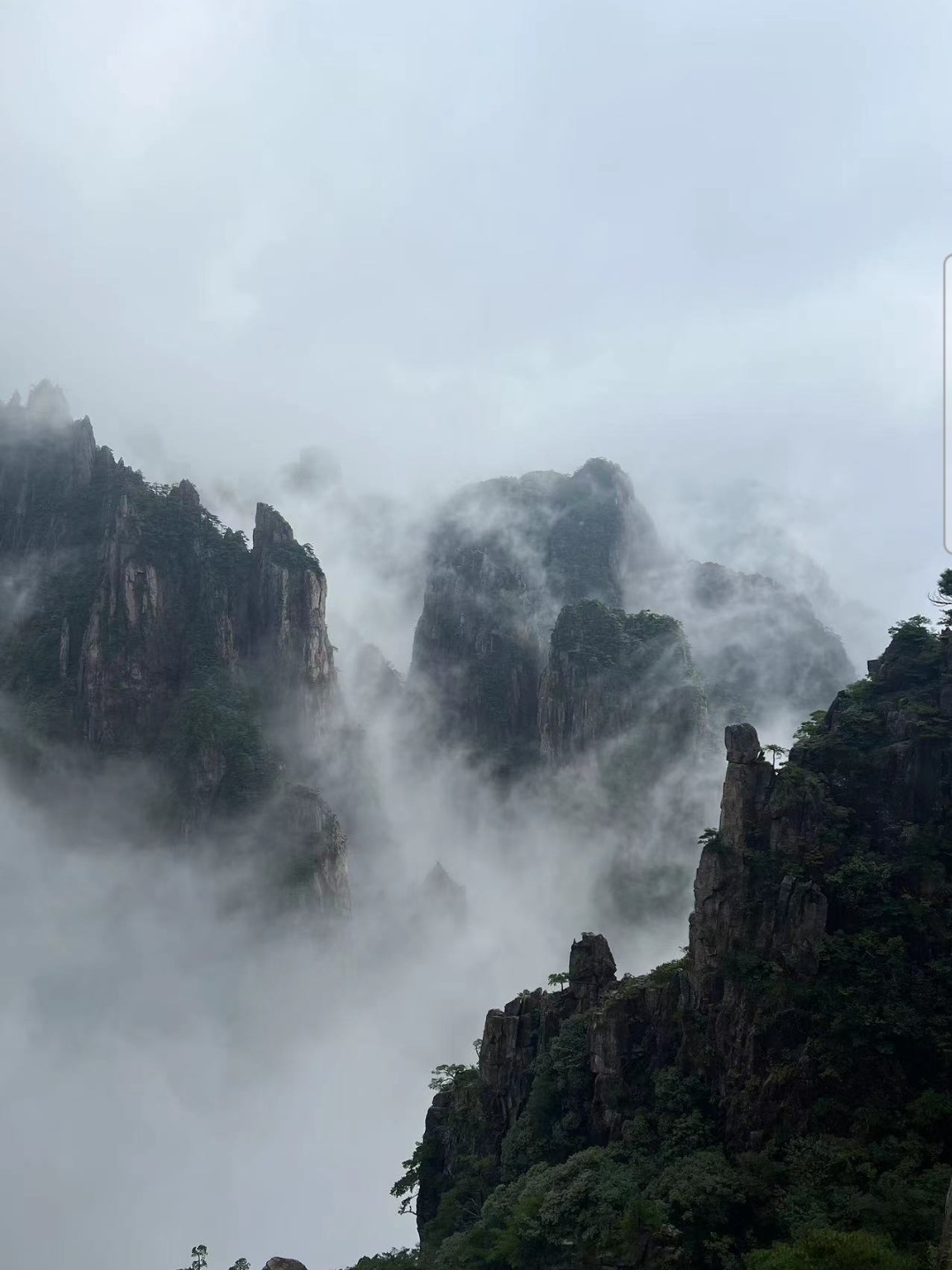
This photo is an example of such a view obscured by clouds. It was the situation 2 days after my visit to Huangshan Mountain … The photo was send to me by my local travel guide Louise.
The combination of these strange mountain shapes and the odd growing often directed to one side of tge Huangshan Pine Trees is what makes these mountains so special. I’ve not seen this anywhere else and I completely understand why artists and photographers like to visit these mountains …
The Pines form little gardens on mountain tops and sometimes against the mountain’s steepest slopes. Nothing stops them from growing at the most inaccessible spots …
2. Beginning-to-Believe Peak (1680 m.)
Suddenly mist came rolling in, completely changing the mood. Everything suddenly looked dreamy and mysterious. This caused by the silhouettes of these strangely formed mountains …
Beginning-to-Believe-Peak (1 705m/5 594ft) is a wonderful spot to see multiple peaks of the Huangshan mountains. It is about a kilometer from the Yungu cable car station.
3. The famous Huangshan Pine Trees
There are many eceptionally shaped pine trees in the yellow mountains, which inspired the Chinese to give them many fantastic sounding names as well. Like e.g. the Black Tiger Pine, The Guest Welcoming Pine or the United Pine.
Pinus hwangshanensis, or Huangshan pine, is a species of pine endemic to the mountains of eastern China; it is named after the Huangshan Mountains in Anhui, from where it was first described.
Huangshan pines are endemic to the mountains of eastern China, in the provinces of Anhui, Fujian, Guizhou, Hubei, Hunan, Jiangxi, and Zhejiang.
They typically grow at moderate to high altitudes on steep, rocky crags, and are a major vegetation component in the landscapes of eastern China. Many specimens are venerated for their unique rugged shapes and are frequently portrayed in traditional Chinese paintings.
A lot of the pines below get their sunlight from one side, because they grow against a steep mountain slope which keeps away the light from the other direction…
 Thus these pines started growing in the direction where the light comes from…
Thus these pines started growing in the direction where the light comes from…
This weird way of growing seems a bit distorted to me and I think that in combination with the clouds and the fog and the strange mountain shapes it altogether attracts us humans.
It is a bit otherwordly out there …
The pines are present at locations where you would definitely not expect a pine tree to grow.
They seem to just sprout out of bare rock …
How did they get there????
There was a bit of mist rolling in between the mountains, but not yet the amount that I had been hoping for …
… but even now it became obvious how much these clouds and the mist were attributing to the mysterious mood …
It must have been the birds that carry the seeds this far up and later the winds and gravity that spread them all over the mountain slopes …
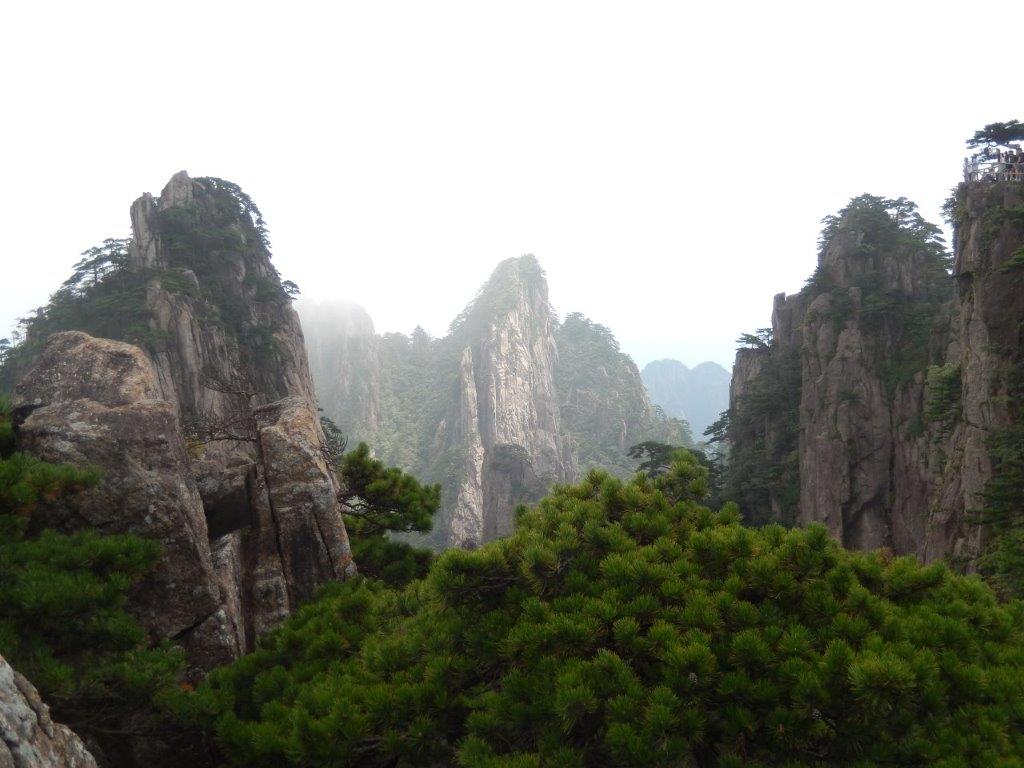 These pines only need a small crack in the surface, filled with a bit of water and subsequently some soil to get growing and get a very tight hold on the rock even so tight that it is the rock that starts to break and crack even more asr the pine grows …
These pines only need a small crack in the surface, filled with a bit of water and subsequently some soil to get growing and get a very tight hold on the rock even so tight that it is the rock that starts to break and crack even more asr the pine grows …
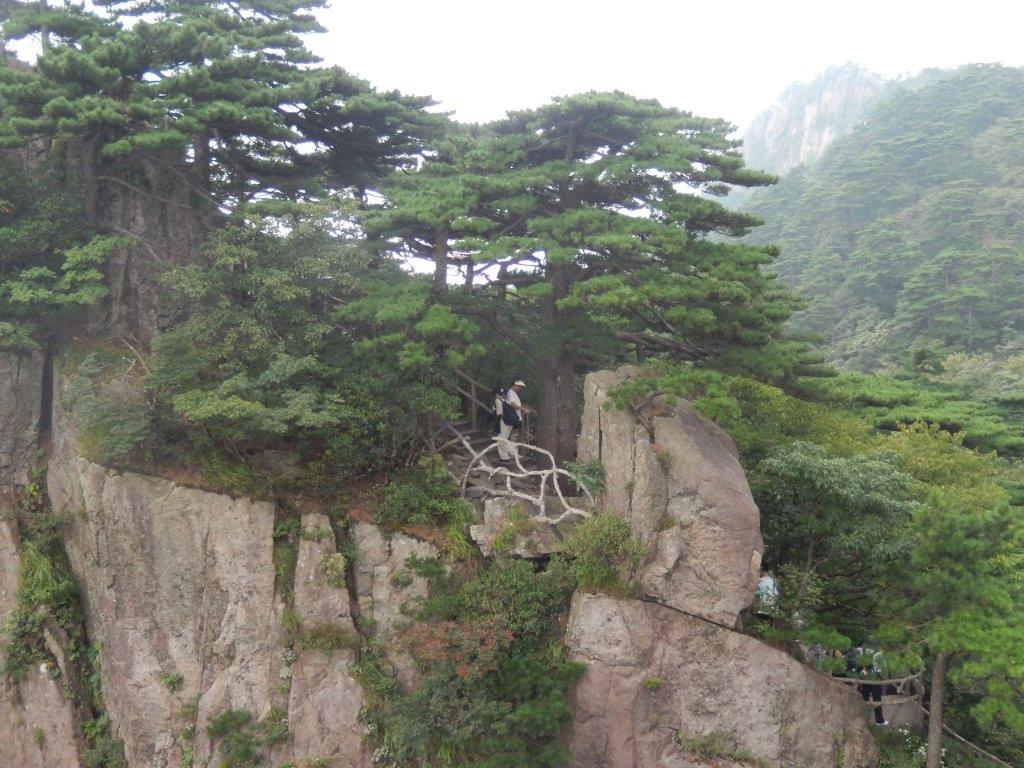 The large boulders that can be found everywhere are probably broken off pieces of rock after a pine or maybe a bunch of pines got hold of them. There are lots of split rocks in these mountains …
The large boulders that can be found everywhere are probably broken off pieces of rock after a pine or maybe a bunch of pines got hold of them. There are lots of split rocks in these mountains …
The pathways lead toward spectacular views, but the view platforms themselves are just as spectacular …
There are route signposts pointing towards the major viewpoints, cable car stations and the hotels…
Beneath what seems to be a dead tree, which however did win the battle against an unwilling rock boulder, now split in half …
 The area was and is visited a lot by poets as well and the many poetic names of rock formations and pine trees seem to spring from poets minds …
The area was and is visited a lot by poets as well and the many poetic names of rock formations and pine trees seem to spring from poets minds …
4. Flower growing out of a Writing Brush Rock
The next rock formation accurately describes what can be seen: Flower Growing out of Writing Brush Rock is a striking formation of a stunted pine sprouting out of solid rock.…
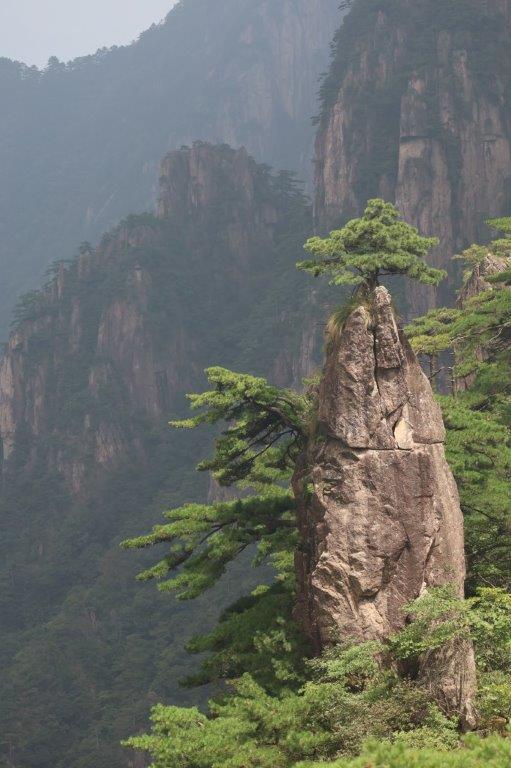 A bit of imagination is needed, but The Wandelgek was convinced of this being a very suitable name.
A bit of imagination is needed, but The Wandelgek was convinced of this being a very suitable name.
Very near was:
5. Pen-Rack Peak
Beneath you can see both rock formation. Flower that grows fron a painter’s brush to the right and Pen Rack peak to the left.
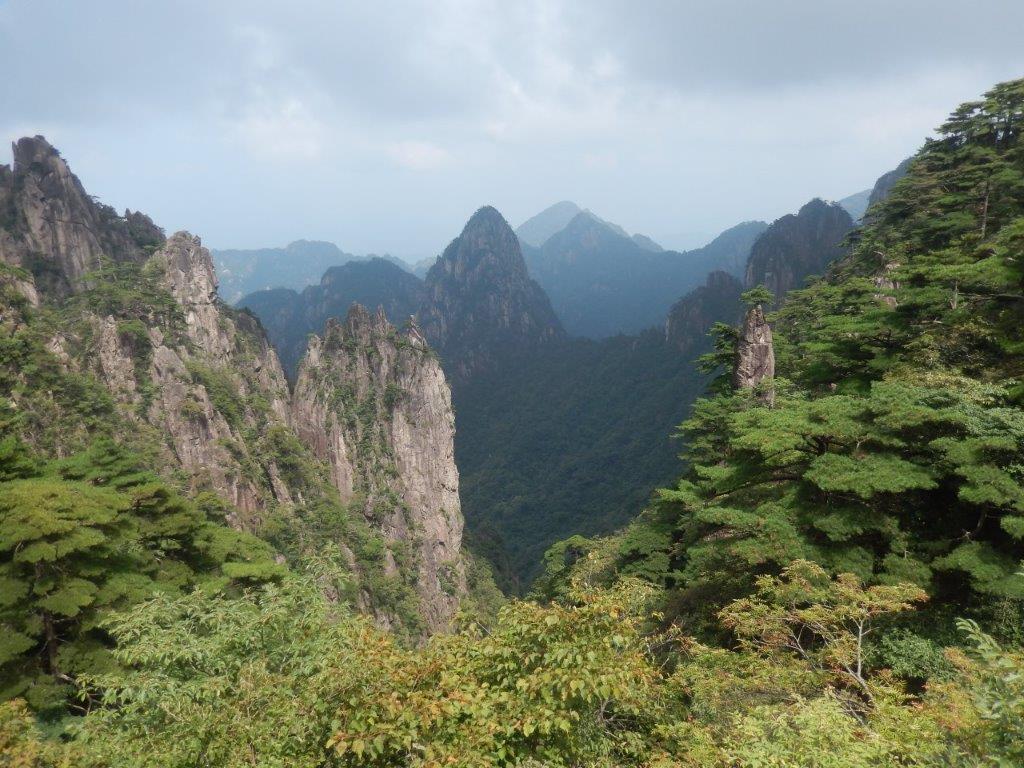 Calligraphy, or the art of writing, was the visual art form prized above all others in traditional China. The genres of painting and calligraphy emerged simultaneously, sharing identical tools—namely, brush and ink. I’ll write more about this topic soon, but because we see here all these rocks named after the tools used for calligraphy and painting, I want to show a typical calligraphy/painting set as available in China and also in Vietnam, where I bought this one:
Calligraphy, or the art of writing, was the visual art form prized above all others in traditional China. The genres of painting and calligraphy emerged simultaneously, sharing identical tools—namely, brush and ink. I’ll write more about this topic soon, but because we see here all these rocks named after the tools used for calligraphy and painting, I want to show a typical calligraphy/painting set as available in China and also in Vietnam, where I bought this one: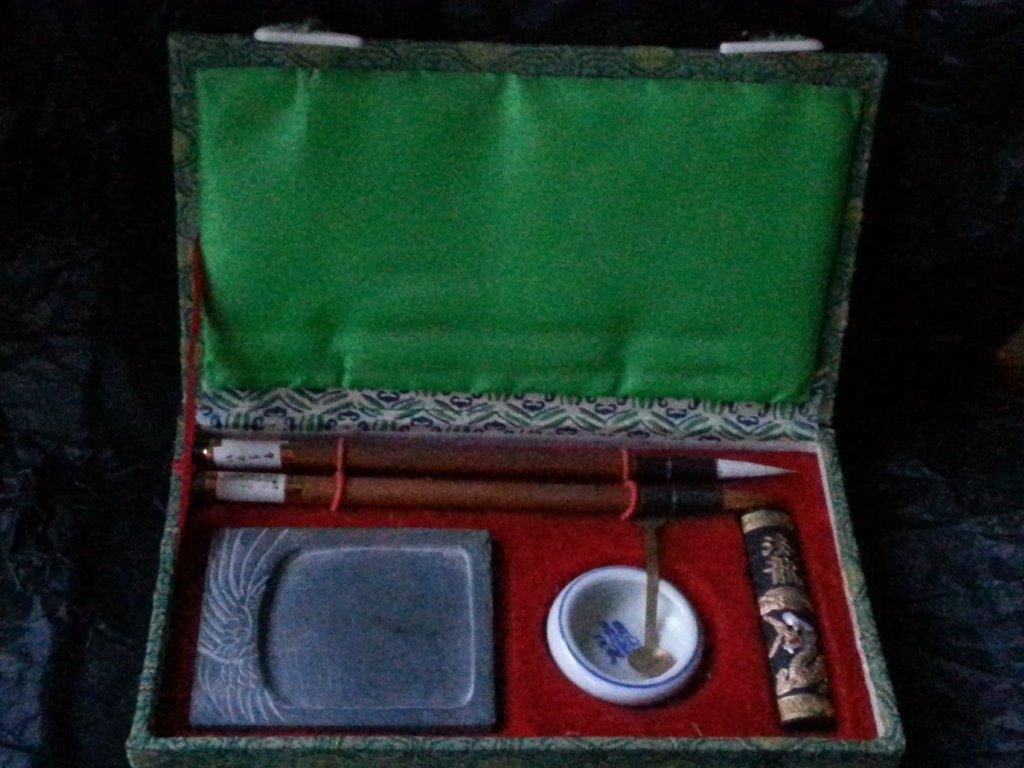
Read more about the Calligraphy tools at:
Souvenir 011: Chinese Calligraphy and Painting Set – Ho Chi Minh City/Saigon, Vietnam, 2008
The rock formation’s shape does look like a holder, pot or a rack in which brushes are positioned with their tips upward. A common use in ancient China, because it kept the shape of the brush intact.
In modern China however, brushes are often hanged in a rack with their tips down. This way paint residue and water can leak downward and the brush tips do not change shape because they are hanging in the air, not touching any bottom.
The Wandelgek enjoyed walking past these really beautiful rock formations with incredibly steep slopes. which were still here and there overgrown with pine trees…
 Shan shui refers to a style of traditional Chinese painting that involves or depicts scenery or natural landscapes, using a brush and ink rather than more conventional paints. Mountains, rivers, bamboo forest, pine trees and waterfalls are common subjects of shan shui paintings.
Shan shui refers to a style of traditional Chinese painting that involves or depicts scenery or natural landscapes, using a brush and ink rather than more conventional paints. Mountains, rivers, bamboo forest, pine trees and waterfalls are common subjects of shan shui paintings.
Concepts
Most dictionaries and definitions of shan shui assume that the term includes all ancient Chinese paintings with mountain and water images. Contemporary Chinese painters, however, feel that only paintings with mountain and water images that follow specific conventions of form, style and function should be called “shan shui painting”. When Chinese painters work on shan shui painting, they do not try to present an image of what they have seen in the nature, but what they have thought about nature. No one cares whether the painted colors and shapes look like the real object or not.
According to Ch’eng Hsi:
Shan shui painting is a kind of painting which goes against the common definition of what a painting is. Shan shui painting refutes color, light and shadow and personal brush work. Shan shui painting is not an open window for the viewer’s eye, it is an object for the viewer’s mind. Shan shui painting is more like a vehicle of philosophy.
Connection to poetry
A certain movement in poetry, influenced by the shan shui style, came to be known as Shanshui poetry. Sometimes, the poems were designed to be viewed with a particular work of art, others were intended to be “textual art” that invoked an image inside a reader’s mind. This explains also why painters and poets were both attracted to the Huangshan Mountains, because they were thinking like-minded and expressed themselves both in the Shanshui style, influencing eachother’s work.
Zhang Yimou and Calligraphy
The art form of shan shui has been popular to the point where a Chinese animation from 1988 entitled Feeling from Mountain and Water uses the same art style and even the term for the film’s title. Additionally, many recent movies and plays produced in China, specifically House of Flying Daggers and Hero, use elements of the style itself in the sets, as well as the elemental aspects in providing “balance”.
Construction
The term shan shui is sometimes extended to include gardening and landscape design, particularly within the context of feng shui. A lot of the towns and villages in the Huangshan Mountain area were constructed within that Feng Shui context, like e.g. the village of Chengkan:
More Huangshan Pine Trees: A photographic impression
Here follows a photographic impression of the upcoming mist Huangshan Pine trees in the Huangshan Mountains, which I hope will show you readers, without the use of words what ultimate strong survivors these pine trees are:
6. Monkey watching the cloud sea
One of the best chosen names for a rock formation. The Wandelgek misread this name at first, missing the word “cloud”. He thought it a strange name for a rock which by the way does resemble the silhouette of a stooping short-tailed Macaque monkey, which does live in these mountains It seems to sit there, bent over, on that mountain, overlooking the landscape, but where is the sea? he wondered. Well if you see the Huanshan mountains when there is a low hanging deck of clouds, than it all becomes clear…
7. Other strange rock shapes
There were much more stangely shaped rock formations, all carrying an often poetic and self explanatory name, but The Wandelgek did not remenber them all, although Louise undoubtedly must have named them when passing by …
But it does also get your imagination running wild when you don’t know the name and are triggered to think of a name for yourself. You should try it with some of these photos, like the one above or the ones below. This one really looks like a man wearing a hat. A farmer maybe?
8. The United Pine
This pine tree I think was also named the Black Tiger Pine …
Look at how the strong roots have cracked the granite stone …
It is one tree, but it has two large tree trunks attached to eachoter, hence the name Unity Pine …
It was also the largest pine tree The Wandelgek had yet seen in the Huangshan Mountains …
It was so large and probably old that it had to be supported …
BeiHai Hotel
Then the first morning and early afternoon walk ended at the Beiha Hotel, where The Wandelgek quickly checked in and left for his room to take a shower and some rest, because the walk and es[peccially the heat were taking their toll…
Above is the main building of the hotel, which was located quite centrally in the National Park and gave easy access to lots of walking routes. Beneath is the second building where The Wandelgek had his hotel room…
Hotel room
The room was tiny compared to the previous one, but hey: this one is on a mountain top and it was still a very good room …
But as you can see I had onky brought minimal luggage to the top so everything is relative… is that a feng shui thought?
Bath room
The bath room was basic but also spacy so I liked it a lot. There was a hot water shower but no subsequential rain shower. Then again I heard the Behai was the very best hotel on the mountain …
After a dozung off on the bed, The Wandelgek rose again for a second walk, but for that you’ll need to wait for the next blogpost or maybe the one after that 🤣😂
I’m probably never ever gonna learn and behave like a propper travel blogger or worse a travel influencer.

